Ray's Ramblings - Volume 5
Ray Kessler is a lifelong Mt. Vernon resident who has played a lot of ball, written about others playing a lot of ball and loves to wax eloquently about Mt. Vernon. We are fortunate to have access to many of his short stories and observations to show here.
We have organized the articles by the period of time Ray is referencing. This volume started in October, 2012.
Come back often, because Ray just keeps finding items to add. This is Volume 5.
2010's
Safe Deposit Keys from People's Bank & Trust Still Used at Old National Bank
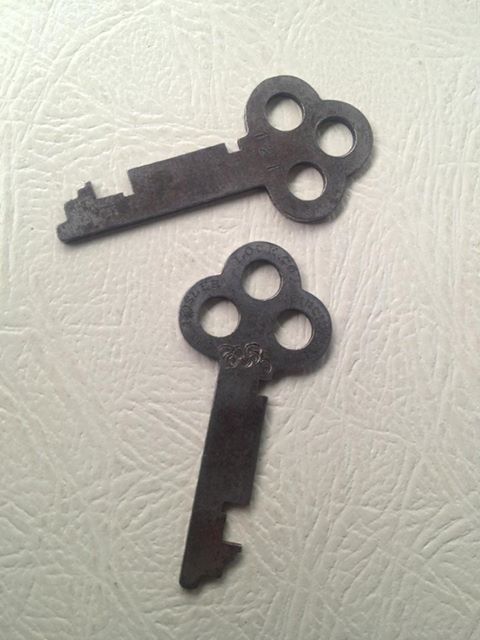
Went to the bank this morning to pull out my marriage certificate...dug through rookie cards of Hank Aaron, autograph of Joe DiMaggio, insurance papers, birth certificates, commemorative coins till I found it. Same box and keys I have had for over forty years. In fact, they tell me these are the same boxes and keys since the creation of the bank over a century ago....pretty cool.
Lest we forget.....2013
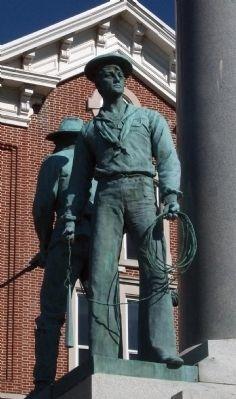
On a Thursday morning the town was alive with excitement, a booming cannon blasted the city air heralding a day of celebration. By mid-morning crowds filled the town square, buildings were decorated with bunting, our roads filled with buggies and wagons. A large parade headed by Grand Marshall Captain Frank Greathouse marched down our streets. A platform decorated smartly with flags and bunting was erected on the west side of the court house, just to the rear of the monument itself. Potted plants decorated the platform and the chairman, Captain John Corbin, of New Harmony, former member of the 91st Indiana Infantry regiment, called everyone to order. The principle speaker was James Watson from the 6th Indiana district and a republican candidate for governor. The idea of the monument came from Christian Dannheiser, a native of Bavaria, Germany and a worker at the Keck-Gonnerman foundry. Major G.V. Menzies and Leroy Wade became interested and a petition drive was circulated. Monument cost about $14,000 and was made possible by a tax levy of 6 cents per $100 of taxable income. 55 feet high, base of 8 feet, and 12 feet high, marble shaft is a sold piece of granite 24 feet in length, 3 feet in diameter. The bronze statues represent the Army and Navy and are 10 feet tall and weigh 1560 pounds each, the Goddess of Liberty is 13 feet high and weighs 2500 pounds. The statues represent a sailor, infantryman, soldier and artilleryman. Designed by F.M. Young of Litchfield, Illinois and molded by Rudolph Schwartz of Indianapolis. Two cannons were donated by the Grand Army Post, 7 feet 10 inches in length and weighing 9000 pounds each were put in place but donated to the war effort in 1942.
2000's
1990's
Where did he get that from?.....1998
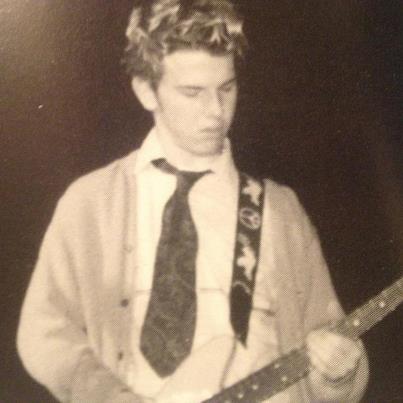
"My youngest boy Brock in the high school talent show. Hoop Pole says: During the performance by Collision, band members jumped off the stage into the aisles; several students ran to the front of the stage and mosh pit broke out. Proving to be one of the year's most controversial events brought mixed reviews from students and faculty."
EPA Testing For Chemical Contamination.....1998
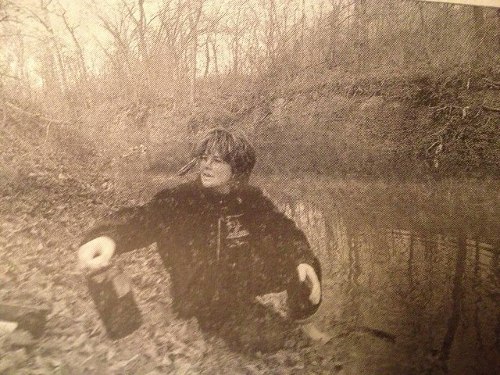
Melanie Ellison is seen checking samples from McFadden Creek for chemical runoff from WSI fire. Minute levels of chlorine were found, well below the 5 ppm level considered toxic. A boil adversary was still issued; it was hoped that the runoff was stopped by a system of dams and ditches built to retain the chemicals of the fire water. For some time the water works stopped its intake from the river until it could receive test results. Good thing to have big government when you need it isn't it? Protect our environment; inspect our meat and factories, and drugs. They could always do a better job, but think what it would be like without them. Don't you think we should pay for such services?
Carl Madden Handle Factory ...1997
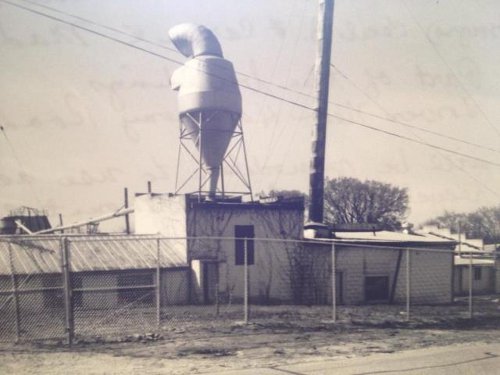
Now Mt. Vernon Recycle
1997 portrait representing Norman Norvell at Schneider Funeral Home
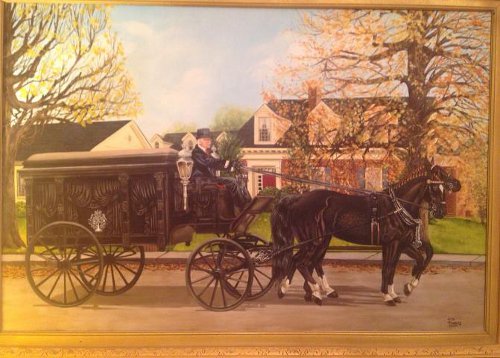
1997 Hovey Dig
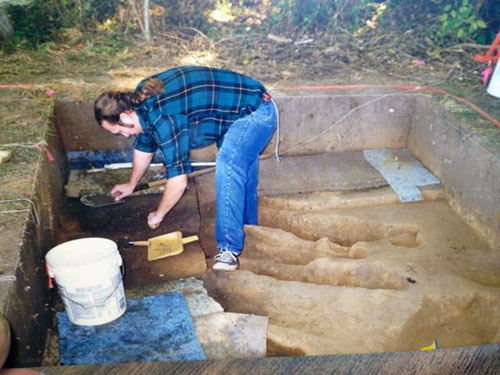
...carbon dating, removed small animal bones, looking at food stuffs and plant specimens of Native Americans.
Bobby Jo Steward...First Black Police Officer in Mt. Vernon. Officer for 23 years.....1995
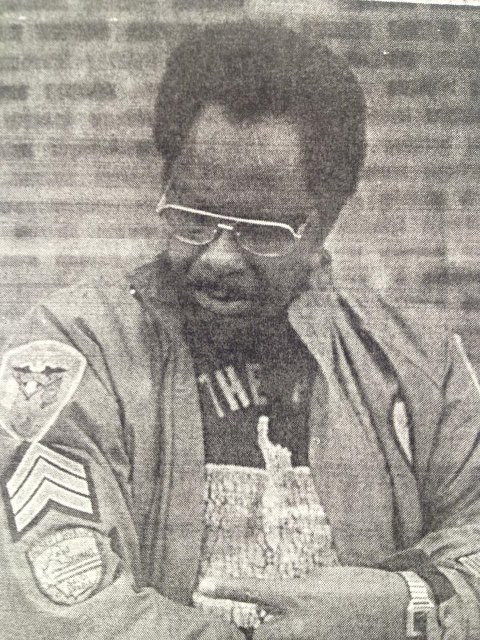
1980's
Mapco Coal Dust Hearings and Protest....Late 80's or early 90's.
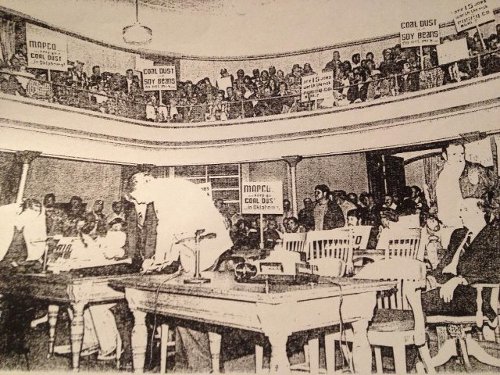
I remember retired school teachers coming to my door wanting me to sign a petition against this company. I found it cool that here were some of my teachers saying, "Not everybody can live upstream," and "protect the environment and not the polluter." I felt vindicated....."Good morning star shine, the earth says hello." Don't you just love the rock tribal musical Hair? I do.
"Looking Through A Glass Darkly".....1987
"What?" Mayor Higgins said that as he took a call from a resident who told him that the mirrors placed on Tile Factory Road facing Sherman Street were upside down. "I wasn't aware that a mirror could be hung upside down," Street Superintendent Steve Wild told the city council. The 2 feet square mirror was hung to rectify a problem. Callers said the mirrors offered, "Good views of the clouds and some facing the mirrors at the Sherman stop sign witnessed cars approaching upside down. Wild promised to correct the problem and turn the mirror right side up.
Dr. John Vogel Retires.....1987
After 43 years of private medical practice in Mt. Vernon, Dr. Vogel put in his last day. He began his practice February 7, 1944 when physicians were in demand everywhere including Mt. Vernon. At that time, two Mt. Vernon physicians were in the military and one left soon as Vogel arrived. Elmer Stephan, then president of the MV Chamber of Commerce, welcomed Vogel to our town. Stephan renovated space over his implement store at 422 Main Street for his first office. During the Korean War, Vogel himself was drafted and served in the Army from July 1952 to July 1954. Upon his return he located his office at 131 West Third Street. In April of 1968 he again moved into a new office building at 722 Main Street and practiced there until the fall of 1977 when the Mt. Vernon Medical Center was completed. The following July, his son Dr. Gordon Vogel joined him in practice. Two years later Dr. William Sutton joined them. Vogel did his premedical studies at then Evansville College and received his doctorate in medicine from Indiana University. He completed his internship at Methodist Hospital in Indianapolis. He was a charter member of the Academy of Family Practice, a member of the American Medical Association and a member of the Trinity United Church of Christ. He was involved in Boy Scouting and attended the National Boy Scout Jamboree in 1957 and 1960 as a medical officer. He was a charter member of the Posey County Emergency Medical Service Council.
Walter King and City Clerk/Treasurer Laura Bullard Check Out Old City Ordinances...1987. I wonder if a hippie could look at those?
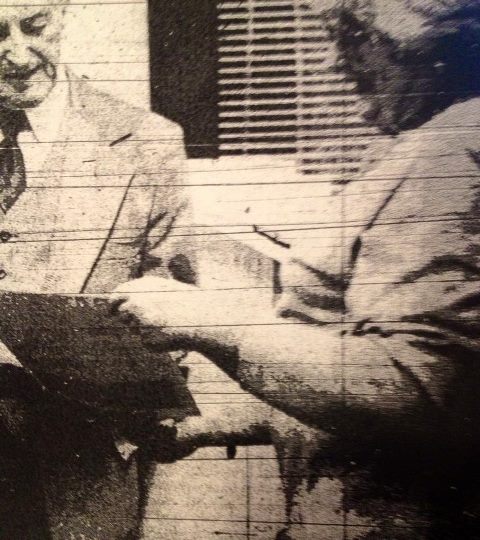
I wonder what is in them. Maybe, like no horse can be ridden within the streets of the city faster than ten miles an hour and must not drink from the city wells. A female over the age of 13 shall not wear a bathing suit within the city business district. It is unlawful to take your dog to the Vernon Theater. No pinball machines shall be operated by anyone under ten years of age at Wanda's Pizza. No person shall spit on the floor of a public building or sidewalk - do it in the alley.
Archaeological Dig at Southwind Maritime Port...June 1983
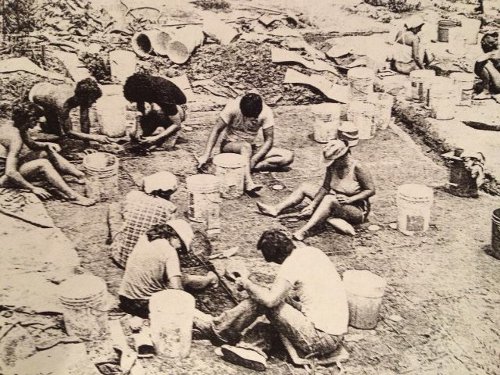
A prehistoric Native American excavation was held at the port, just east of Mt. Vernon conducted by Indiana University and funded by the State Port Commission. Here they were examining a 1200 year old village. This was a place where maize was grown, deer and turkeys were killed and fish was pulled from the mighty Ohio River. The houses were walls of wooden posts into which twigs were woven and plastered with clay like mud. The houses had roofs thatched with grasses. Beside 20th century plastic buckets, dark stains of long ago post holes marked a home of long ago...before Columbus, before the white man. Shards of broken pottery were found that once was a vessel that held the dinner for a family, perhaps a young child. The site was found in 1978 by a Dr. James Kellar and informed the Division of Historic Preservation thus the dig. Little pieces of bone or pottery, crumbling under touch...sieved and floated for still smaller items, maybe charred seeds were collected in bags for later cleaning, identification and study. From small things come advancement in learning....I am told. I hope so.
Courtney Smith Calls it a Career.....1981
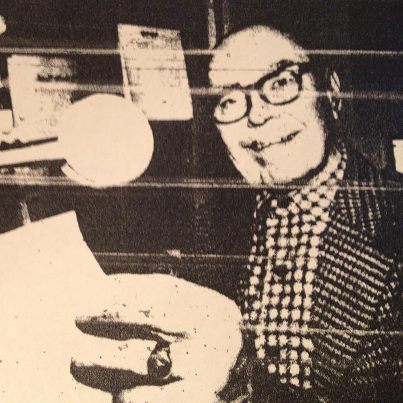
Courtney was synonymous with Mt. Vernon radio. For 25 years he was the manager of WPCO in Mt. Vernon and before that he was with WSON in Henderson in 1941. After the WWII he began in Pittsburgh then to Evansville as new director at WEOA, known later as WROZ. In 1955 WPCO opened in Mt. Vernon and he came here.
Happy, Happy, Happy.....1980
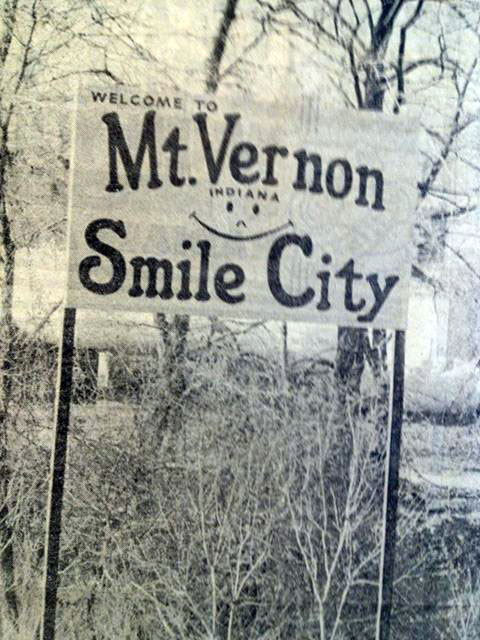
1970's
1975 Glenn Curtis classic
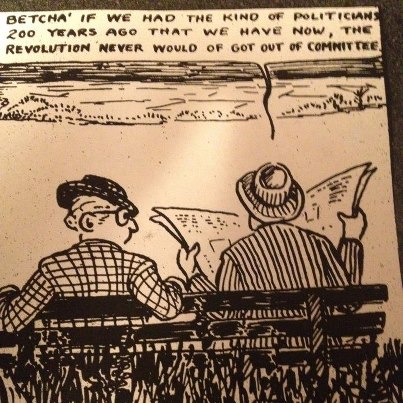
Remember those Thatched Overhangs ? What was with that?.....1970's
I was looking at the old Robison Men's Wear building on Main and thought of the thatched overhang that use to be over the entrance. Those things were getting plumb popular for a while around here. They were at Gentil's, Frank Parrish's, and Yaggi's Plumbing as I recall. They must have gotten a group deal. I thought they were very ugly. Now days many of our Main Street buildings require more than just a tiki bar look and a coat of paint for esthetic enhancement.
Glenn Curtis Cartoon.....1973
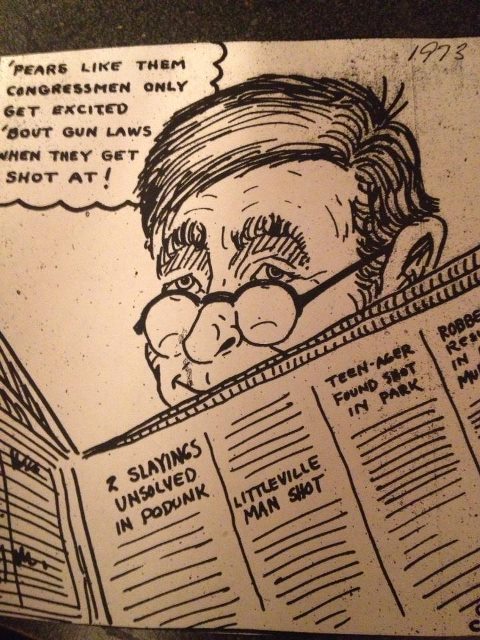
Dairy Dream...early 70's
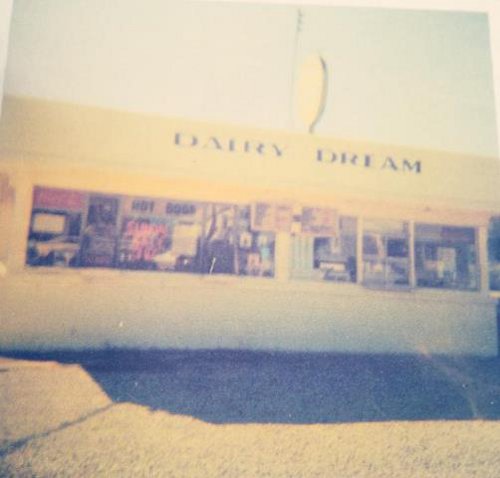
Ohio River Bridge Near Mt. Vernon Turned Down....February 1971
Some of the residents in MTV have never been anywhere else and don't realize that industry looking for. A place to locate a new plant, look for many things. They look for the best tax breaks a town and/or state will give them, what is available to move their product once it's made, suitable land for the. Plant, and training facilities available to train local people so they can operate the machines of a particular plant.
Haircut?.....1971
In January of 1971 Steve Burris opened his new barber shop where it remains today at the corner of Second and Main Streets.
Get Your Complete Set...The Easy Way.....1971
There was a time I remember where you could go to a local bank and get your "fine China" right there in the bank. Must be why I have savings accounts in both People's and Posey County National ...I mean Fifth Third and Old National, or something like that. The idea was you open up a new savings account of say $10 or more and you get a saucer. For each additional $25 or a CD you could purchase an additional place setting for $3 or so until you had all the plates, saucers, bowls, cups, sugar bowls, butter dishes you wanted. They still do this?
Gary Shoemake Received Bronze Star for Heroism in Vietnam....February 1970
Army Specialist Four Gary A. Shoemake of Mt. Vernon was awarded the Bronze Star Medal for heroism under enemy fire in a presentation at Song Bee, Vietnam. The citation read: "The Bronze Star Medal is awarded to Specialist Four Gary Shoemake for heroism while under fire in connection with military operations against a hostile force in the Republic of Vietnam. He distinguished himself by heroic actions on January 21, 1970, while serving as a machine gunner of a defensive bunker complex at Advisory Team 67. An enemy sapper force was attempting to penetrate the American compound and the Vietnamese Province Chief's compound near this bunker. With complete disregard for his safety, Specialist Four Shoemake proceeded from his living quarters under heavy fire, reported to his bunker, participated in harassing defensive firing of bunker weapons, repaired the bunker complex as needed, all the while continually exposing himself to shrapnel, miscellaneous airborne debris and automatic small arms fire. His heroic actions helped to prevent any penetration of hostile forces into the compounds, which surely prevented the loss of friendly lives. The heroic actions of Specialist Four Shoemake were in keeping with the highest traditions of the military services and reflect great credit upon himself and the United States Army."
Population Facts.....1970
The city of Mt. Vernon boasted 6,770 residents in 1970, the 76th largest town in the state, down from being 74th in 1960. Evansville ranked 4th, Tell City 67th, Princeton 72nd, and Boonville was 85th. Posey County moved up four positions in a decade to 57th place with a population of 21,749.
No tear gas or clubs were needed during this student demonstration on City Hall.....1970
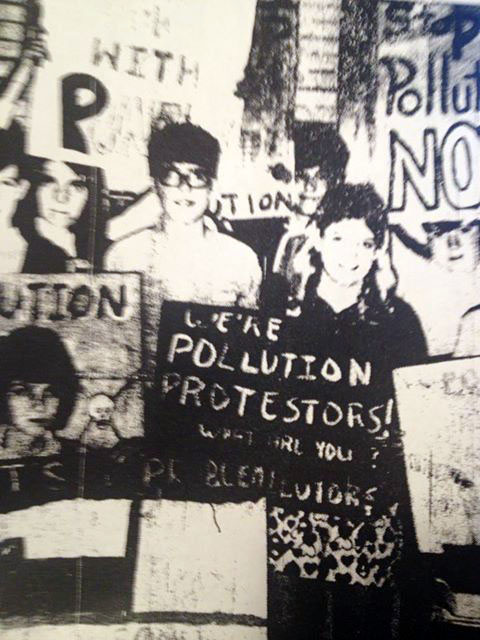
Jr. High Students marched downtown "carrying signs, saying hooray for our side." no that's not it. Twelve days prior to Kent State our country had its first Earth Day and protests were the order of the day. I was in California at the time and the pollution was terrible. I was actually there several months before I knew there were mountains on the horizon. This demonstration was said to have been an individual effort and not a school sponsored event. The students during the march collected debris in parks, along the roadside and in the yards. We were so much more socially conscious then....we need another movement for the earth. We are not the same planet we were 40 years ago.
1960's
Christmas.....1966
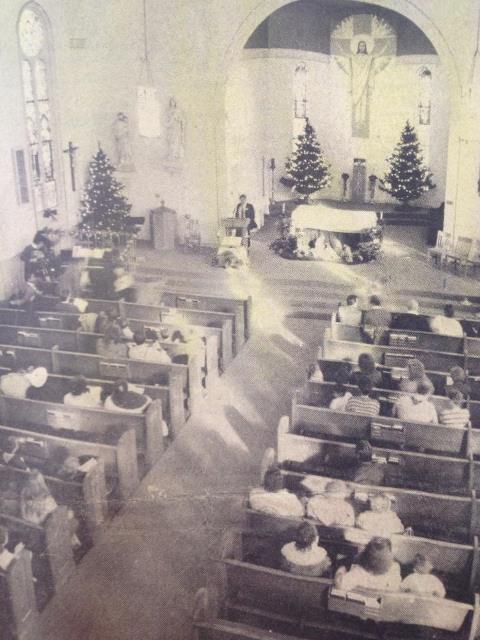
St. Matthew Church
An Evansville Courier article of August 14, 1966 said Diamond Island, near West Franklin was used as a headquarters for pirates in the early 1800's, much like Cave -In-Rock, Illinois.
Pirates such as the notorious Colonel Plug were said to be in the area stealing from flatboats and killing the occupants many who were immigrants. Sometimes they would lure them to shore for a card game and a good meal, and then steal their flour, whiskey and whatever was with them. Counterfeiters were also on the prowl, selling their paper money cheap to pass onto others.
Bones of Mastodon Found Near Farmersville.....1966
Bones at least 30,000 years old were found near Mt. Vernon. Some already have been excavated a mile and a half northeast of Farmersville and an archaeologist as positively identified them as remnants of the hairy elephant like animal that roamed this area prior to the Glacial Age. The discovery was made by 12 year old Gary Schneider, son of Mr. and Mrs. Earl Schneider. The boy was hiking with a brother and a cousin when he spotted part of a large bone in an eight foot creek bed on the Darwin Allyn farm. John Elliott, New Harmony, an archaeologist formerly on the staff of the University of Kentucky, examined some of the bones and determined Schneider had found a mastodon. The skeleton was uncovered by water action from the creek where it was spotted. Elliott theorized the bones were deposited in their present location by action during the last glacial period about 20,000 years ago. After examining the site, he determined that the bones were not an undisturbed skeleton but were scattered about. Elliott drew that conclusion because the bones "did not appear to be articulated in their natural relationship to the skeleton of the giant herbivorous animal." The bones were found about one quarter mile from the Schneider residence in the natural ditch off Indiana 69 separating the Allyn and Don Uhde farms about 200 yards from Copperline road. Some of the bones excavated to date include an upper foreleg that weighs over 100 pounds, several vertebrae, broken rib fragments and a small piece of the large pelvis. Two teeth were uncovered each weighing a couple of pounds. The teeth, both molars, were used by Elliott to identify it as those of a mastodon. One tusk was recovered. Weighing over 100 pounds, it was almost five feet long and worn down at the tip end, apparently by natural causes during the animal's lifetime. In recent years, the bones of two other mastodons were discovered in the county. One was at the gravel pit near the Wabash River and another at a drainage excavation in north Posey County.
Mt. Vernon Gunslingers.....1966
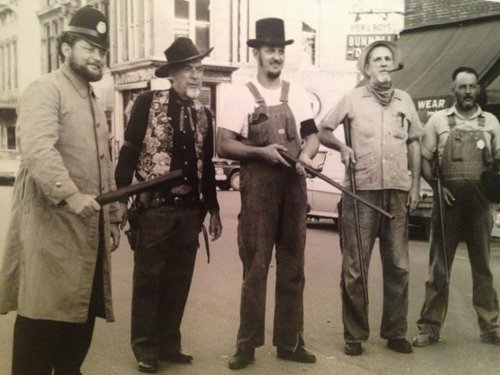
Jerry McClarney (?), Bill Booth, Charlie Huey, Orrin Estes, ?
Leonard Kuhn and Dot....1960's. Dot lived from 1958-1976
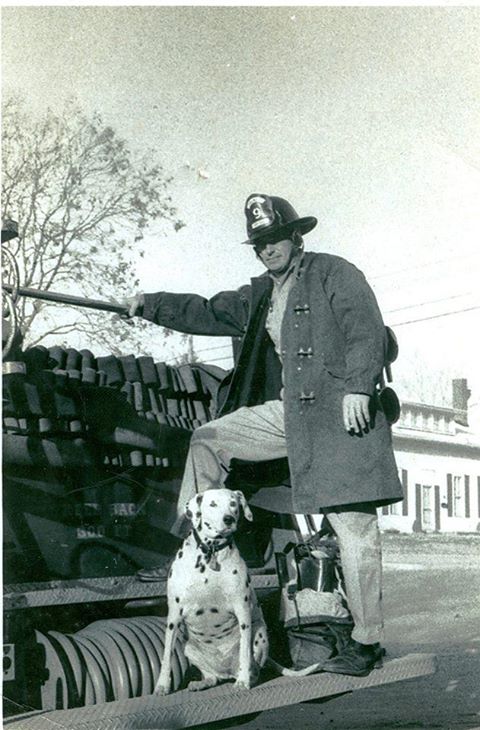
Evansville Couple in Dallas When President is Murdered....1963
Dallas "the city of pride" soon would be known, rightly so as the 'city of shame" following the assassination of President Kennedy. Mr. and Mrs. Stanly Atkinson were there only six blocks away when it happened. They were able to observe the reaction of a shocked and stunned city. "Within 30 to 40 minutes after the shooting, most of the stores were closed and the streets had been cleared. I don't know what happened to the traffic, but it was practically non-existent," said Atkinson. The Indiana couple were at Nieman-Marcus and were passing a Christmas display of radio and television sets. "I noticed a large group around a tiny transistor TV set, and I thought there must be some sort of demonstration. But there was something about the crowd. I walked over and they were telling the President had been shot," he said. He found his wife, who "didn't believe it," but when she went to the beauty salon, the news had reached there that the President was dead, and appointments were canceled. "The whole city was in a state of emergency," he said. "There were police all over the place. Everything just stopped. I never saw such a drastic change in my life in a group of people. I saw thousands of people and no one smiled."
Athletic Park early 60's
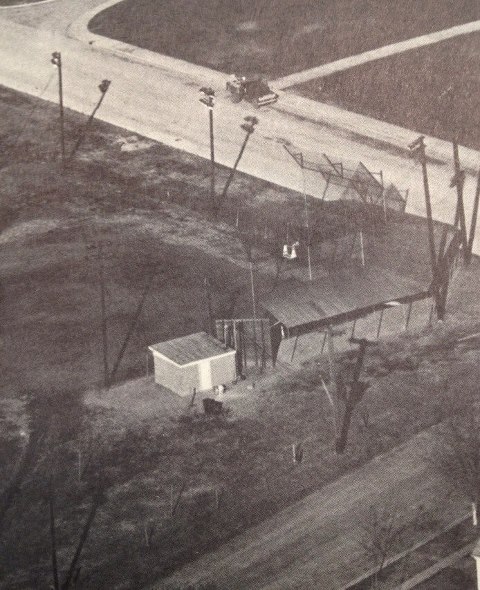
Memories. Those were the days...Merchants, Flopsy Philips, Bill Benthall, all ballgames (softball and baseball in one location) and a free ice cream for just working the field. What a life! Were we lucky or not? Those wool Little League uniforms of the Retailers, Lions, Elks, Jaycees....Manual scoreboard down first base line. Pole and track on the field. Wooden bats, Tiny Waller umpiring.....chasing down foul balls for a soda at Double I League games. I think lights first came in 1954. I can recall gasoline poured on infield and set afire to dry diamond for a game. Little League Baseball was actually started in MV by MV Democrat sportswriter Bill Causey who paid for much of the early equipment himself. He would put the season stats in the paper and write ups of most games. He was a poet also. No one mentioned the cinder track. For those youngsters reading this, cinders are what are left in a coal burning furnace. They look like black, exploded, rocks covered with sharp edges. If you fell down on the track there was no way you would come up without bleeding or at least covered with scrapes.
Reserve Cheerleaders 1962-1963
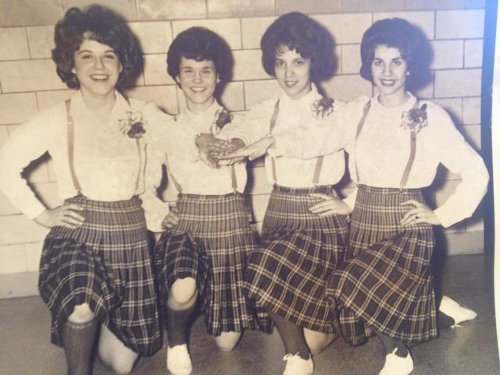
Mary Ann Watson, Patty Crooks, Susan Dixon, and Debby Feldbush. Debby Boarman gave me this picture from her scrapbook. Sure are some long skirts......such a shame. :>)
Working On 8th Street Culvert.....1962
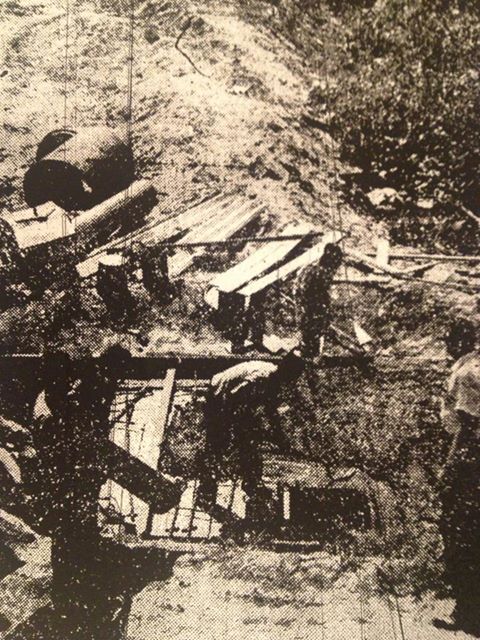
The culvert under Eighth Street and a portion of new Mill Creek tube were connected in August, 1962. The concrete tile (left center) would be used for the manhole and the two tall poles (top) anchor the tube into position. The city hoped to recover over 11 acres of land when the Mill Creek is enclosed in a tube from Eighth Street to the river.
MT. Vernon.....May of 1962
Let's start with 123 graduates of MVHS departing on buses for a trip to Nashville Tennessee to see the Hermitage and the Confederate museum. It was also the month the Wildcats' six game baseball winning streak came to an end when future NFL Hall of Famer, Bob Griese, of Rex Mundi pitches a two hitter and shuts us out. Babcock and Wilcox broke ground that month and the Mt. Vernon city plan commission approved a layout of a new Park Ridge residential district west of town. Keck Motor Company celebrated 50 years in Mt. Vernon that year and announced they had sold 15,587 automobiles during that time. I played American Legion baseball against him once. He was a great athlete. Mike Minton was another RM star of that time. The Monarchs advanced very high in basketball in 64. Remember when we stalled against them and lost 26-24 in the Sectional? That is the lowest scoring game in the last 50 years! It was 14-13 at the end of the third quarter.
Remembering Ole Diz and The Baseball Game of the Week.....1962
When I was growing up everything stopped on Saturday afternoon to watch baseball on TV. You see back in the late 50's an early 60's, "The Game of the Week," was the game of the week....the only game. Usually a Yankee game and then in September we again watched usually the Yankees in the World Series. Now Dizzy was something else..an ex 30 game winner with the Gas House Gang. He would pitch every other game down the stretch if you wanted him too. Born in Arkansas he didn't have much education, but he had all the smarts and confidence in the world on the mound. There are a million quotes of his just like Yogi Berra, Satchel Paige, or Casey Stengel. He was injured by a line drive in the toe one all-star game, came back too early and hurt his arm losing his velocity. Finally he became a broadcaster and was on television with Pee Wee Reese. Pee Wee didn't get to talk all that much as Diz would be telling us about "hump back quails, blue darters to center, how a batter slid into third and calling Pee Wee "Partner." We loved him in his white fedora hat and string tie sitting in front of a Falstaff beer sign singing the "Wabash Cannonball" during the 7th inning stretch. Sometimes he would talk about shooting turkeys in Mississippi or catching a string of fish in the river. He was unique. At Sportsman's Park in St. Louis I got to see him and he signed my scorecard as did batting champion Tommy Davis and Dodger manager Walter Alston. "Will you please sign my scorecard Mr. Dean?......"Why sure partner hand it here kid."......Thanks Diz!
Skating Rink on College Avenue....Hmm, News to Me.....1961
I was roller skating a lot in those days...until Junior's burned in January of 1961 that was located on Highway 69 North. I guess this took over for a while, but I don't remember it, It was located at 218 College, right next door to the Mt. Vernon Creamery. I have no memory of this...do you?
May of 1960
In May of 1960 Mt. Vernon pitcher Dale Smith hurled a three hitter, fanning 14 as the Wildcats defeated the Bosse Bulldogs 7-2 at Athletic Park. Frankie Adams and John Price each had three hits. The most strike outs I have ever found for a Mt. Vernon high school pitcher for seven innings work was 18 I believe in 1948 by Isham. Was his name Bennie? I think.
The General ...came to MV around 1960
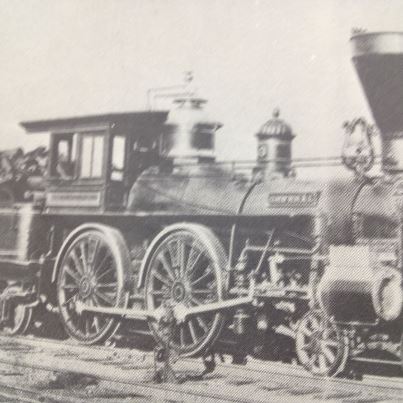
Now in Kennesaw Georgia....this was a confederate locomotive.
How Beautiful is This? Doane Photo ....1960's
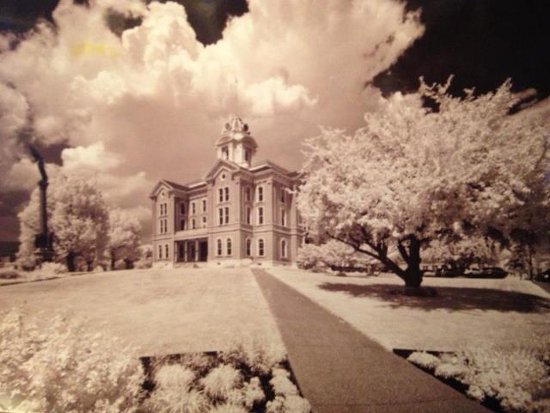
Athletic Park.....early 1960's
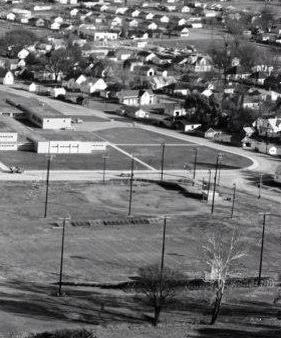
I hated those posts and track on MY baseball field. I am so pleased they are gone. Right field would always flood and we had many a game washed out. I can remember watching Sunday Double I League games here and they would sometimes burn off the infield! Wasn't much of a concession stand....it also served as a backstop while warming up pitchers. (I did a lot of that). Springtime was always cold sitting on the bench after if Coach Jeffries needed to warm up a reliever I was glad to grab a mitt to generate some heat. The scoreboard was letters hung on a nail. But there were some great games there and many a big leaguer and minor league played on this field from the 1920's until today. Of course, today that field had drainage, larger grandstands, dugouts, batting cages, homerun fence, bullpen mounds, press box......it looks good, And oh....grass infield. It is now quite beautiful and has even hosted post season games.
1950's
Hello this is Cynthiana...number please....1959
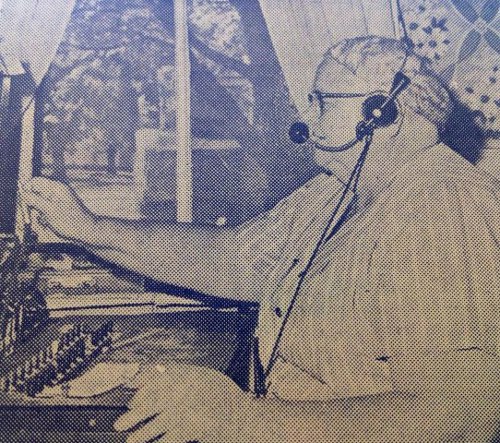
Claude Shafer, Parachute Jumper at 4H Fair.....1959
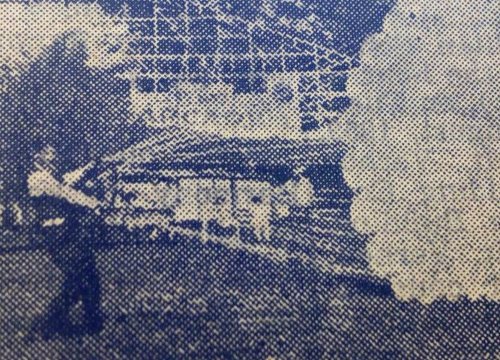
Back in 1910 at the fair a man died when his balloon burst and he fell to the ground out of his chair. This man Claude was from Indy and he came to our fair several years at the Fairgrounds , four miles south of New Harmony on Highway 69. The veteran balloonist made his first parachute jump at 18 and had since made more than 4000. He said the most risky part is the landing. He had landed in lakes, trees, on houses, other buildings and fences. He doesn't sound like someone I want to double up with....how about you? Shafer built his own balloons and parachutes also. The balloon took about 860 yards of material and measured 70 feet high and 40 feet around. He usually rises to about 2500 feet, depending on the weather, before returning to Earth....hopefully not Oz. So after the pet parade and before the greased pig catch....look to the heavens for that little dot of a man falling to Posey.
Camp Pohoka Opens for 35th Season in 1959
Camp Pahoka, operated by the Buffalo Trace Council, Boy Scouts of America and located on the Wabash River opened in 1924. During that time it was estimated that over 25,000 Scouts spent a week there of camping. I was one of them...living in a tent, hearing scary ghost stories, drinking "Bug Juice" from the chow hall, almost drowning in the lake, and standing along the lake for the Order of the Arrow Ceremony which included Indian drums and people running around behind you with torches "tapping" candidates out and leading them away to a new campsite. I remember they didn't like it very well when I told them I would be returning home for a Little League game. Nothing stood between me and my baseball back then...my parents even had to schedule vacations around my playing ball! We also camped out at Trinity Grove and at Pfister's Pond I believe it was called. I belonged to Troop 475 I think it was....Jack Hargett was scoutmaster. Pohoka is closed. Maybe bought out by state park. Not sure or when it closed. Pfister's pond may not be the right name. It was out by Farmersville and wasn't readily seen from the two lane road. It was a pretty good size lake as I recall. Likely of the outings I remember it rained....the evening lasted forever, but that breakfast out of a mess kit over a fire was outstanding!
John Keck Breaks Ground at GE Site.....1959
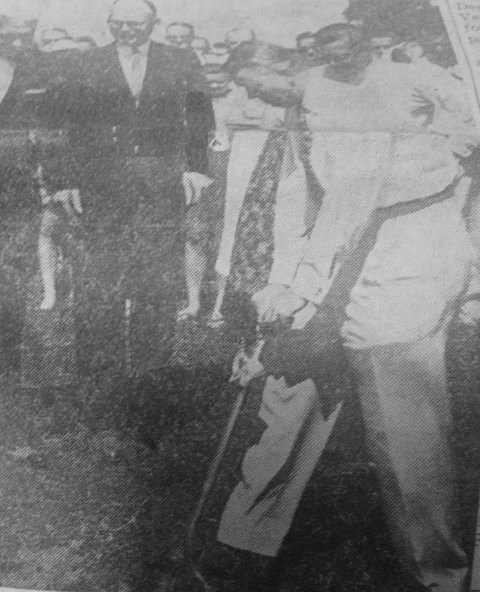
500 local residents were on hand to give an enthusiastic welcome in a important milestone for Mt. Vernon. Lt. Gov. Crawford Parker was on hand calling it a "red letter day."
Lincoln Flatboat Stops in MV.....1958
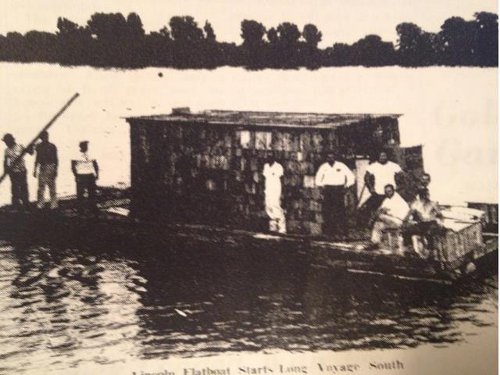
A flatboat en route to New Orleans from Rockport received a warm welcome in Mt. Vernon in June of 1958. Among its passenger list were two men re-enacting an important incident in the life of Abraham Lincoln. The boat had a four hour layover in Mt. Vernon. Several hundred people in small groups braved a drizzling rain to visit the craft. Mayor Percy Bartlett was the official greeter and Bee Nix, president of the Jaycees was the welcoming committee. Gifts from Mt. Vernon industries included raincoats from Advance Manufacturing, ice cream from the Mt. Vernon Creamery, flour from Fuhrer Ford Milling, gasoline from Indiana Farm Bureau Co-Op Refinery, and cornmeal and grits from Mt. Vernon Milling. It was Lincoln and a neighbor Allen Gentry who journeyed down the Ohio many years ago with a cargo of flour, grain, meat, tobacco and whiskey. It was in New Orleans that Lincoln first saw a slave market and it was there that his determination to rid the nation of slavery was born.
1958 Wildcats...18 game winners and Evansville Sectional Finalist.
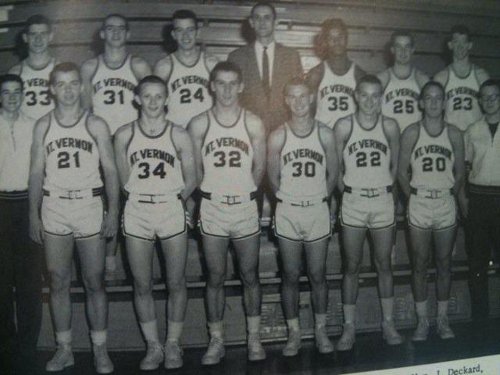
The team entered the sectional with a 15-5 record and ended the season 18-6. They averaged over 66 points a game that season and established the best season since 1922. At the time the 18 wins was the most ever until the 1972 established a 22-2 record. This team won 11 games on the road! They scored 90 vs. Richland, won a Holiday Tourney and in the Sectional defeated New Harmony, Griffin, Evansville Lincoln and lost to Evansville Central 58-57 in the Sectional finals. On the season the leading scorers were Charlier Brauser 387, Jim Russell 245, Kenny Stewart 226, Bud Wright 221, and Jim Challman 202. They were coached by Jim Solomon. MVHS Hall of Famers on this team included: Bud Wright, Gerry Allyn, Charlie Naab, Sam Gander, Ken Stewart and Charlie Brauser. Other players were Frankie Dickens, Joel Deckard, Steve Noon and Bueford Deig. Jim Baxter reminded me of the bad call in the Central game. Gerry Allyn told me back in 1983 that the turning point in the title game occurred in the 4th quarter after the Wildcats had come back from a ten point deficit to take the lead. An out of bounds call was made and the officials disagreed on who would get possession. Gerry said, "I was standing out of bounds getting ready to inbound the ball to Challman when the other official took the ball from me, handed it to the Central player and they scored." Mt. Vernon payers, I believe, were not set up when the ball changed hands and it was a quick basket. Principal Charlie Hames had told me he regretted not taking it to the IHSAA as a protest, but he didn't.
Mayor Percy Bartlett practicing Direct Distance Dialing.....1958
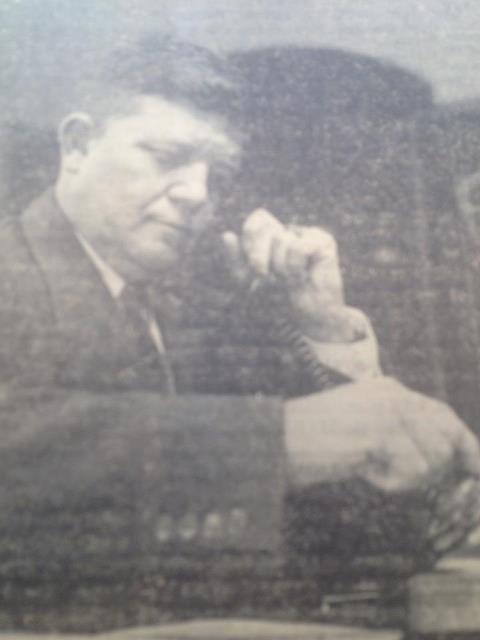
Poseyville's David Davis gets an autograph from Reds outfielder Gus Bell.....1958
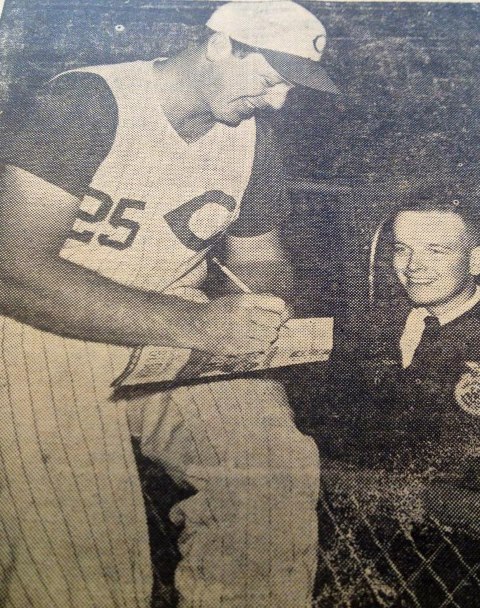
Remember when the Reds changed their names to Redlegs back in the fifties because of McCarthyism?
Food Merchant Retires After 55 Years.....1958
John C. Griess hung up his grocery man's apron after serving patrons for 55 years in Mt. Vernon. The Griese Food Market at 614 West Second was sold to Joseph Boehman of St. Meinrad, Indiana who also at that time purchased the Stocker market building, residence and parking lot on the east side of town. When Griess first entered the grocery business he started as an employee of Charles F. Tente when he was 14 years old. That was back when they used a horse drawn delivery wagon, had charge accounts, a "bologna meat department," and pickles and vinegar came in barrels His wife, Margaret, also was closely associated with the store putting in long hours, hard work and let 's say they both worked with integrity. They had two sons, Simon, a clerk at the Post Office, and John Jr., a chemist employed in nuclear development by Union Carbide in Tennessee.
Troop 81 Gets Another Eagle Scout.....1958
Boy Scout Week had a special local ring to it that year as John W. Doane Jr., 15, a MVHS sophomore received his Eagle badge. The formal presentation of scouting's highest award followed a potluck dinner at First Methodist Church, sponsor of Troop 81. Doane, son of Mr. and Mrs. John Doane became the 30th member of Troop 81 to achieve Eagle rank. Tom Hoffman, district scouting executive, showed a Boy Scout film called, "They Also Serve," and the scouts conducted a candlelight ceremony depicting the Scout oath, and law prior to the Court of Honor.
Two Posey Flyers Escape Death in Local Plane Crash....1958
Two well-known men, Aubry Robison, Jr., and Bill Hinton cheated death in a crash landing of a single engine Cessna 140 plane. Minutes after take-off from the Mt. Vernon Municipal Airport, the plane's engine failed necessitating a forced landing. Twenty to thirty feet off the ground the right wing of the craft dropped but did not fall off, causing a crash landing in a pasture on the Rosenbaum farm off the Tile Factory road a mile north of Mt. Vernon. Robison suffered a cut on the forehead. Hinton's jaw was fractured and a spinal disk compressed. Both walked away from the crash but entered the hospital after Dr. Eckerty, local dentist, checked Hinton out and found the jaw fracture. The plane was a total loss, despite the fact it did not catch fire. The plane belonged to some Mt. Vernon, Illinois enthusiasts and had been left here so Robison could demonstrate to Hinton, a prospective buyer of the plane. Both Robison and Hinton were licensed pilots and Hinton qualified under instruction by Robison. Hinton was at the controls when it took off from the airport, but when the motor failed at an altitude of 400 feet, Robison took over. Robison said he knew he would have to make a forced landing, made a 360 degree turn looking for a landing spot and saw the pasture. He did not anticipate the right wing failure that caused the crash. Fred Freimiller was the first man to reach the downed plane and brought them back to Mt. Vernon. I doubt he bought it!
Ninth Annual Kiwanis Kids Day Wraps Up.....1958
The annual carnival for the public to finance boy's and girl's programs was a glorious occasion from start to end, crowded with entertainment and even the shops got a boost. Baked goods were abundant as well as Kiwanis bags of peanuts. Big pet parade, with escorts from the police and fire departments. High School band with their new uniforms, cheerleaders...did I ever tell you I like cheerleaders? I was there...right up there on the lawn watching the first ever Mt. Vernon Hula Hoop contest. Never seen so many hoops in my life! What a fad that was. Barbara Lowe won the most graceful, and Margaret King got an award for moving the hoop up and down her body in all so many ways. Linda Neal took an award with tricks with the hoop too. Jody Crabrtee had the cutest little pet, Charlie Topper the largest pet, and decorated bike winners were Mark Dewart and Vicky Turber. There was a dunking machine available and the sorority wore bathing suits of yesteryear. What were they thinking? Bikinis are here! Oh well, ~Wavy~ never gets asked for suggestions.
Redman Assigned to Regional at Jeffersonville.....1957
Many times I remember headlines like this of Malvern Redman, Mt. Vernon's premier basketball official come post season play. I always thought he was a good official and I know he did a few State Final tournaments too in boy's high school basketball.
PCHS had great photo of Blackburn's Shop on Main from 1956. Formerly Palace of Sweets or "Greeks."
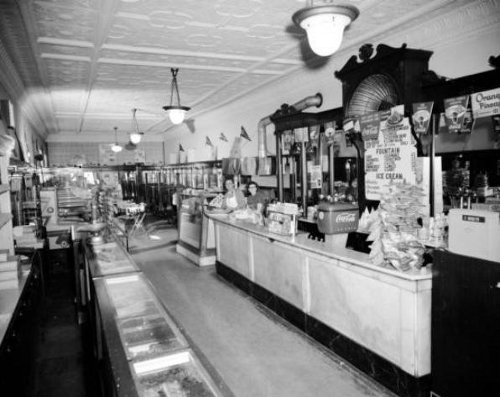
Teen Hurt by Police Gun.....1956
Thirteen year old Judy Carvin of 325 Nettleton Street was wounded accidently by ricocheting shot from a policeman's gun as two policemen were shooting starlings. Mt. Vernon police officers Alex Herring Jr., and Carl Keitel had accepted an invitation of Lealon Allen of City Cleaners to aid him in ridding his premises of 329 Nettleton of starlings roosting in trees. Officer Keitel was using his own gun, a 410 pistol, and officer Herring was using one of the old sawed off 12 gauge shot guns of the police department. Both were shooting No. 8 birdshot shells. Officer Herring said that when he pumped in a shell with the gun barrel directed at the ground in the back yard of the Allen home the gun discharged and the shot hit the ground and ricocheted about 30 feet to hit the child who was swinging on the front porch of her grandmother, next door to the Allen home. After treatment locally she was admitted to Deaconess Hospital. Thirteen or fourteen shot hit the girl in the back, leg, right arm, and shoulder. Two more shot hit an eyelid but did not penetrate the eyelid. One shot nipped the corner of the eye and buried itself in the nose.
First Methodist Church.....1955
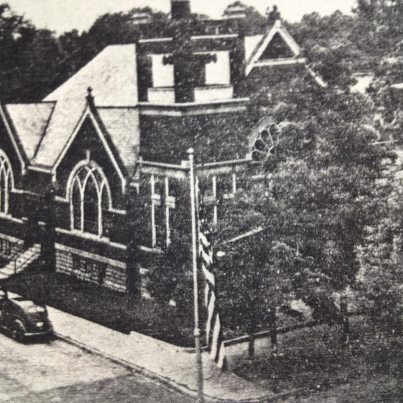
This photo was taken from a 1955 Chamber of Commerce Leaflet.
83 Year Old Remembers Old Mt. Vernon from Chicago.....1955
Ed Regin writes: "I was born in Mt. Vernon, March 15, 1872 and by wife Alma Feldman, December 31, 1874. That made us Hoosiers for life. Two of our children, Elizabeth Regina and Mary Lucile were born at the time I was telegraph operator at the L&N station. We left there in 1898 and had another daughter, Martha Jane, born in East St. Louis. The original settlement now incorporated of Mt. Vernon, was McFadden's Bluff. From up around Poseyville there was built into Mt. Vernon what was known as the Calico R.R. It came in about 2 or 3 blocks west of the E.&T.H. (now the C.& E.I.) To fulfill the conditions of the contract the building had to run equipment over the rails. An engine named the Judge Wilber, (engines were named then instead of numbered), after this engine was run into Mt. Vernon it was loaded on a barge in the river and there ended the Calico R.R. I remember (when quite young) of seeing what remained of the right of way. Simply a mound running through the street overgrown with grass. Hooppole Township. This name was given because the levy was always stacked with piles of whooppoles. The flatboat men called it Hoop pole township. These poles were brought in from Tennessee and Cumberland river territory. (*~Wavy~ exerpt: Story sounds different than the usual Hoop Pole Incident doesn't it?) Mt. Vernon being a milling town with wheat and corn products. Then packed in wooden barrels which required hoops made from these hickory poles. In early days there were the Fuehrer Ford, Pfefer and Traut, Evertson and Schnuer Flour Mills. Also the Hudnut Hominy Mill. The original site of this mill was occupied by a hotel which was turned into Hudnut's first Mill. When my father, Harvey Reagin first came to Mt. Vernon he ran a butcher shop. At that time there was wooden covered bridge over mill creek on 2nd St. Father was driving some cows from the west of town arriving at the west end of the bridge. One cow decided to go down into the creek bottom instead of crossing the bridge. The bottom was full of trees and underbrush and the cow never was found. I was there when the water works system was installed (1880's), also oil and later carbon electric street lamps. Main was paved out to 8th street. We thought these were great. We had two old time bakeries. P. Walter on northwest corner of Main and 3rd and Dexheimer Bakery east side of Main between 2nd and 3rd. I remember when the fence around the court house was a flat board on top and cross boards from post to post. There were locust trees in the yard from which those Negro men were hung. One that shot deputy sheriff Thomas was thrown into a work train engine fire box which was on siding at L&N. I remember when Sheriff Hays hung John Anderson and Zack Snyder for killing a young man by name of Vanyer (1884). There was a time I remember when the steam boat did a good business on the Ohio. E. Thomas operated a wharf boat at t time. My father was Master Mason and laid the corner stone of old Central school. I remember when Mt. Vernon got its fire pump. Operated by hand, 12 or 15 men on each side drew water from a made well cover of 4th and Main. I guess I have run long, so I will close." Ed Reagin
Famed Local Curve Ball Pitcher Dies.....1955
William "Billy" Bell, 86, retired employee of the Mt. Vernon Milling Company was a baseball pitcher in the early days of the diamond sport in Mt. Vernon. He had the reputation as one of the first curve ball hurlers in the tri-state and his assortment of "Uncle Charley's" was always buckling the knees of the hitters. Players of that by-gone age remembered him as the ace of the Mt. Vernon Red Jacket Pumps a local baseball team. His interest in the game never dimmed and loved to sit in the bleachers and tell his stories while watching the younger men play.
Firemen's Thanksgiving Ball.....1954
Public celebration at the 63rd Annual Firemen's Ball held at the National Guard Armory. The Bud Avery Orchestra entertained at the benefit dance.
Trinity Shelter House Dedicated.....July 1952
A shelter house erected by the men of Trinity Evangelical and Reformed Church at Trinity Grove, three miles east of Mt. Vernon on Highway 62, was dedicated. Dedicated on a Sunday the church observed a outdoor worship service in its honor. Construction of the shelter house began in the spring and the entire project was done by volunteer labor. The shelter house, 30 x60 feet in size, was constructed of concrete blocks, with open sides, metal roof, insulated from beneath, and electrically lighted. It was hoped in another year they would add running water and a fireplace and an oven. Trinity Grove was started as a recreational area in the 1930's when the late Gottlieb Grabert (relative of my wife), a church member, granted the ground for picnic purposes. After his death, his widow Louise and family wanted it continued as a memorial to Mr. Grabert. The grounds were equipped with slides, swings, horseshoe courts, baseball diamond, volleyball court and a refreshment stand. The public also by application could use the grounds. As I write, bull dozers are pushing down the trees of the former Grove. In the early 60's, I was a Boy Scout, no really I was, and we were sponsored by Trinity, with Jack Hargett the scout master. We had a camp out one night there and I believe it snowed. I remember it cold as the dickens. During the day they took me out for some compass training. I never could get the hang of that! I do remember the baseball diamond. I don't know how many times I had passed this clump of forest and remembered that night.
Memorial Day Speaker Appeals For "Leavened" Patriotism.....1952
An appeal for the type of patriotism that is leavened by reason and intellect was sounded by Dr. Frank Greer, First Methodist minister, who was the principal speaker at Mt. Vernon's formal observance of Memorial Day at Bellefontaine Cemetery. "High patriotism has its dangers in civil life in the same way that it does in religion," Dr. Greer said. "Patriotism and Religion must be balanced by intellect and reason." "If an American wishes the preferential grandeur and well-being of America above all other nations and the same is desired by all other nations...we have the recipe for war." The address and ceremony was conducted under cloudless skies with sponsoring organizations being the Owen Dunn Post #5 and the Harrow Relief Corps. Legionnaire Charles W. Hames was general chairman. The high school band was heard under the direction of Robert Padgett. Frank Fessenden gave a tribute to the Harrow Post, and a young Jackson Higgins recited Lincoln's Gettysburg Address. The Harrow Relief Corps conducted services for the unknown dead, depositing flowers at the soldier's burial plot. Bugler Oswald Pfister sounded "To the Colors" and bugler Carl Lurker sounded taps followed by the Legion squad firing a salute to the dead.
Expanded Park Program Undertaken.....1951
College Avenue Park at West Fifth Street and College Avenue was converted into a playground for small children. A slide was erected, two swings and two sets of trapeze rings installed along with a small merry-go-round and a sand pile. Remember sand piles? We all had big old tractor tires in our back yards back in the day to play in with our toys. Toys were small then too. We had buckets full of little Indians and soldiers, farm animals and dinosaurs. Anyway, getting back to the story, this park was designed for little ones ....ten and under. Baseball was not permitted, so don't be caught playing cup ball or any other kindred activity here....okay? Sherburne Park on the riverfront also opened and the playground was updated with 12 teeterboards, a walk-ladder, bar and ring trapeze, chain swings, a "slippy slide", merry-go-round, swing-around, and more sand piles. Additional benches were added for adults watching them or enjoying the river. Louis Clark was employed by the Park Board as Sherburne Park custodian and William Banks was hired in a similar capacity for College Park. All right....get out there and have a good summer. You ball players....catch you at Athletic Park.
1940's
Feed the Meters......September, 1949
Parking meters made their first appearance in Mt. Vernon in September of 1949 with penny and nickel slots
Mt. Vernon Republican.....May, 1949
At the start of May of 1949 the Western Star newspaper, founded in 1876 by John C. Leffel and carried on by son Herbert Leffel, consolidated with the Mt. Vernon Republican and combined...they would procede under the name...Mt. Vernon Republican.
The Parkett opened in 1949
The menu included hot and cold sandwiches, cokes, root beer, soups, chili, milk, coffee and Ideal ice cream. Insider Wurlitzer machines were available for music selections.
Henry Wallace came to Evansville as the Progressive Candidate in 1948....If in my lifetime, I would have supported him over Truman
Wallace had served as Secretary of the Agriculture and Commerce under FDR and was Vice-President from 1941-1945. He was a polarizing man...thought to be a Socialist by the right who heckled him. If he would not have been replaced as Vice-President, Truman would not have become President and we may have avoided the Cold War. His progressive wing of the Democrats and then his own party advocated an end to racial segregation. Wallace would only speak at non segregated events and he advocated voting rights for black Americans and wanted to provide universal health care. He was a big fan of labor and some thought him a communist. A University of Evansville professor was fired because of him handing out Wallace literature to students. George Parker was his name. Protests were held in Evansville for and against Parker's stand. He was re-instated, but later left on his own to complete a doctorate degree elsewhere. His party was again united with the Democrats and the ideas he stood for lived on to fight another day. Truman did desegregate the Armed Forces and LBJ did bring us the Voting Rights Acts and Obama did bring us Universal Healthcare. In all 19 different Presidents, before, during, or after their presidencies have visited Evansville.
Widening of the court house driveway began by the Posey County Highway Department in January 1947
Court House.....1947
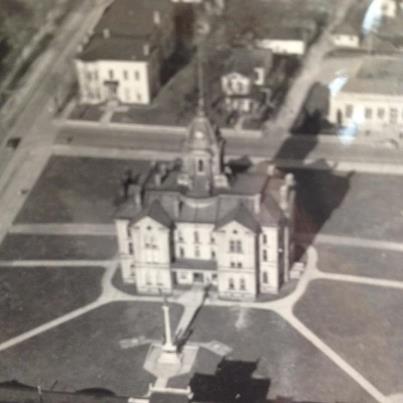
Looking at this photo it must be after 1947. I say this because the large almost century old Elm tree that stood in front of the Hovey House is gone in this picture. That happened in '47. The places where the cannons once were are still in the photo. The cannons themselves were donated in '42. I see a driveway behind the courthouse...not sure when that happened. Most photos seem to be taken from the front; but before the parking lot and ramp were put in the back, I always thought that was very attractive.
Atomic Bomb Observers Talk to Mt. Vernon Teachers...Seek World Peace.....1947
Two of the most educated and inspiring speakers ever to address the Posey County teacher's institute, Wayne Gutherie, assistant managing editor for the Indianapolis News and Rev. Amos Boren, WWII Chaplin addressed the audience. Guthrie was an observer of both the air and underwater atomic blasts at Bikini in July 1946 and had since given 277 speeches on what he called, "Ringside at Bikini." Guthrie described the atomic bomb tests in graphic detail. Wearing black goggles to protect his eyes, he saw the air bomb flash..."a light estimated to be 1000 times brighter than the sun. The flash disappeared instantly and the goggles were removed. This was followed by a red ball of fire which lasted only a second. After that a dark, mucky, grey and black smoke began to ascend very rapidly. It was a turbulent mass that pitched and foamed. Bleaching out it became the color of an ice cream cone and assumed the characteristic mushroom cap. The mass looked like a cauliflower come alive of orange and red fire. A hundred seconds after the flash the sound of the blast was heard like that of exploding tons and tons of dynamite. The cloud rose to a height of 40,000 feet with the mushroom top four miles across." In the second or underwater test, the atomic bomb was exploded by push button, 15 miles from the bomb. "The explosion sent up from the lagoon's surface a column of water which was 2100 feet across. It went into the air 8400 feet in two minutes and thirty seconds and reached maximum at two miles. Then it spread out like a giant toadstool which was something like 16,000 feet across the top." Despite the fact the press ship was nine miles from the blast and between it and the blast was large Bikini Island, Gutherie said the blast shook the vessel twice terrifically. Rev. Boren spoke saying the citizens of the world hold great responsibilities to build a "New Day." To achieve Peace he stated we must: "understand our lives are based on the fatherhood of God; we must accept the brotherhood of man; we must realize the necessity of co-operation and make a positive conviction in international relations by believing the first step begins with me...the individual. "Peace is the only defense to the Atomic Age."
Western Auto Grand Opening.....1947
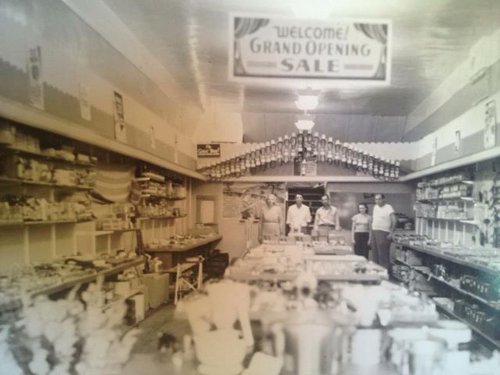
People in photo are Orrin and Elba Estes. A Western Auto representative, and Bob and Dorothy Estes.
Western Auto
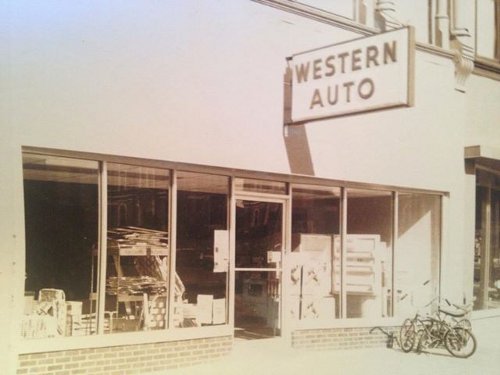
Western Auto
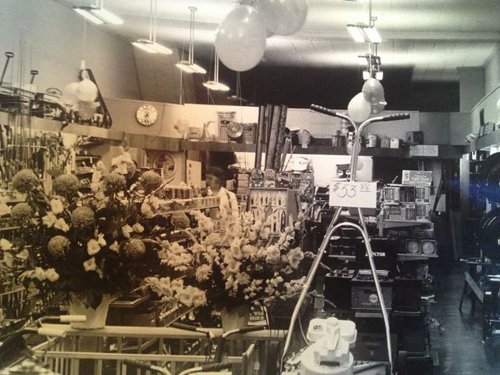
Decorated buggy winner at 1947 Mt. Vernon Fall Festival
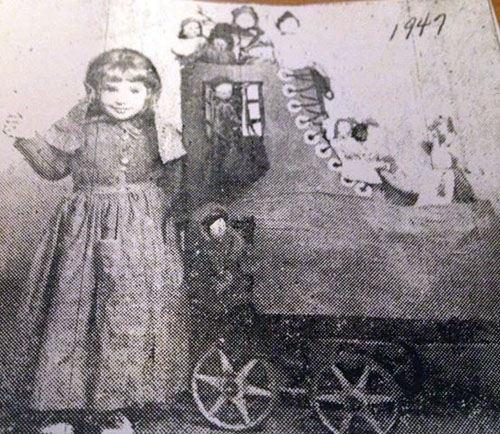
Jackie Jo Anderson...."Old women who lived in a shoe."... How wonderful is this?
Sherburne Park.....1947
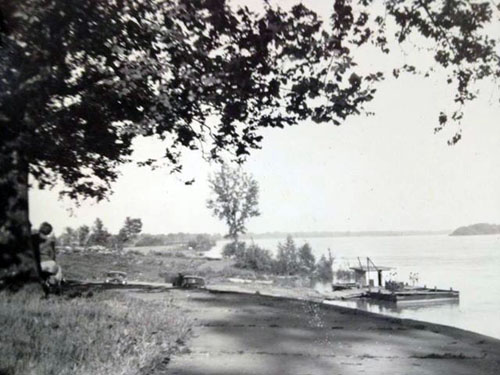
Mt. Vernon Airport.....1946
According to Anne Doane, Mayor Frank Fessenden approached a group of "air-minded" citizens with a proposal to build an airport. There was only $600 available for the project. The Mayor appointed a Board of Aviation Commissioners with David Alldredge as President, Dave Hasting as VP, Henry Graining, Roy Bauer and A.A. Robison Sr., as the other members. Popular subscriptions increased their funds to $2500 and the leasing of the land took almost all of it. Construction came from volunteers of equipment, supplies and labor. Sixty five acres were found on the north banks of the Ohio River, east of town and men showed up with hoes, rakes, shovels and axes. Trucks, tractors, plows, drags, two bulldozers and a winch truck got into action. Gas and oil dealers donated fuel and farmers brought back enough lespedeza seed to sod the runways. Two buildings were built, one an operations office and the other a small lunch room and sandwich shop. A 2000 gallon 80 octane gas tank was installed with provisions for a 1000 gallon 91 octane tank to be added later. A trailer home was brought in for the resident manager. The runways were T shaped, running east and west, north and south. They were both 2640 feet long. They had a orange wind sock. The first plane landed at the airport on May 15. By July 4th they had a dedication. Commercial fliers took up passengers for sightseeing trips until noon, and then the Mt. Vernon High School did a short band concert. Dave Alldredge introduced Pop Fessenden who spoke and then introduced Gene Dawson who was aviation editor of the Indianapolis News. He was active in stunt flying. Planes from the Freeman Field of the Air Force landed for our celebration. In the evening the ceremony was moved to Athletic Park with a fireworks display and more concert music. Traffic grew to seven planes as time went on. Classes were held under the GI Bill. A 30X50 repair shop came in next and individual hangers. Anne Doane wrote a weekly column in the Democrat to keep everyone up to date on the activities at the airfield. John Doane became a private pilot examiner. Many of us remember his photos from the air of the Wabash Bridge construction in the 1950's. In 1947, the Jaycees painted Mt. Vernon in 10 feet high letters on the roof at the Mt. Vernon Milling Company with a length of 125 feet. Some of the hardest workers at the airport were Alldredge, Bill Humber, Herschel Aud, Bud Baer, Hasting, Dale DeFur, Fred Freimiller, Dewey Boyd, Millard Ashworth, Harry Cremeens, Joseph Dailey, Norman Rowe, Floyd Cox, Don Cox, and Donald Moore. Agricultural spraying became big as they sprayed to kill Army worms, weeds and fertilizer. One year a airplane was even put on display on the courthouse square. It was during a fall festival and they placed a Cessna on display. In 1949 Doane sprayed the town with DDT from the airport. There were model airplane displays held here also. Frank Parrish later ran the airport and he had a helicopter pad near his home. That is part of MV aviation history.
Traffic Barred at Riverfront.....March 1945
Flood sightseers on the Mt. Vernon riverfront who park their cars on Water Street between Main and Second Streets have been interfering with the movement of trucks transporting evacuated livestock and personal belongings via the Mt. Vernon ferry. Chief of Police, Edgar Alldredge closed traffic on Water Street and two OCD auxiliary policemen were stationed there as patrolmen and to direct traffic. Persons wishing to view the swollen Ohio River can park their autos elsewhere and walk to the riverfront.
Darwin Rueger...1945. Elected to Mt. Vernon Hall of Fame in 1985. Played 25 years of semi-pro baseball.
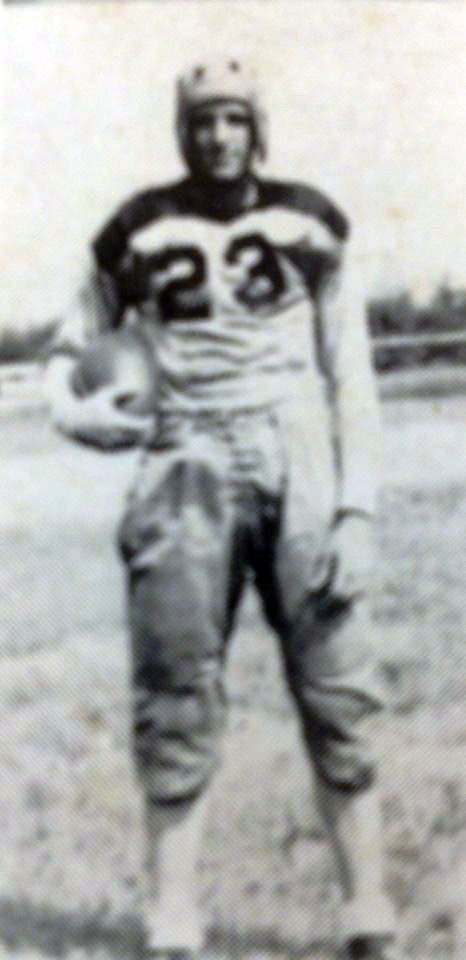
I remember as a kid watching him play centerfield for the Mt. Vernon Merchants in Double I League. He was a quite an athlete in all four sports it seems. There is a picture of him in the Hoop-Pole being hoisted in the air after the Wildcats won the Posey County Basketball Tourney. He was only able to participate in track one season due to the war which limited sports travel during that time. He participated in the shot put, pole vault, 440 yard dash and the broad jump. I even played in an old timers baseball game with him in 1990. He loved sports and should be remembered.
Dogtown, Illinois Ferry... 1944. This is how we crossed the Wabash River before the Memorial Bridge of 1956.
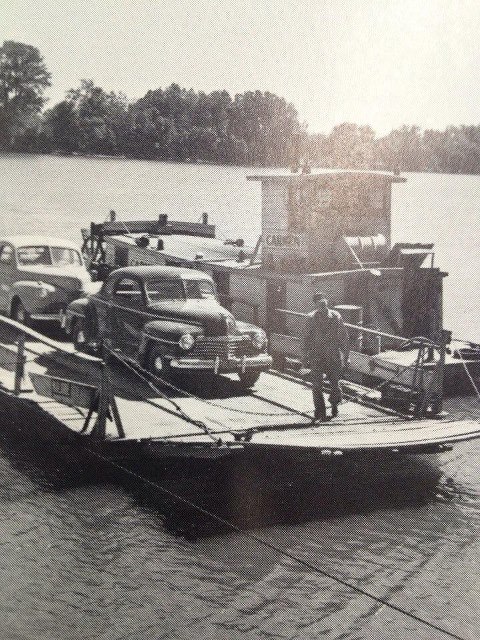
Ira's Got a New Freezer.....1944
One of them newfangled electric ice boxes is now in place at Rothrock Pharmacy and it is immense. Just what the doctor ordered to house candies and medical serums inside. I think it would be fine for Snicker bars too. Have they invented those yet? Oh well. Anyway, the temperature is kept at near freezing so it will be a welcome blast on a hot August afternoon.
Recycle Those Old License Plates...We Need More Bullets....WWII
The oldest license plate turned over to the service stations for collections was a 1913 plate belonging to the late Richard Wilson. The plate was used for a Dodge touring car belonging to Wilson. The plate was of heavier metal than the plates of the 1940's and maybe two or three times thicker and smaller in size. Instead of the customary painted figures, this plate was heavily enameled in black and yellow.
War Hysteria Leads to Laughter.....WWII
One day a farmer entered the county agent's office and seemed to be quite alarmed......in his hand he held a branch of a tree on which a large silky, finely-woven pouch was held. "Please, somebody identify this," he said. The farmer was of the opinion that this was something new and he stated that trees and bushes along the Savah-Mt. Vernon road and the Evansville road were loaded with such items. He suggested there could be a possibility of a sabotage campaign being worked through the country and these pouches were being used to spread germs and disease.....suppose they were parachuted into the rural areas without our knowledge. The pouch was opened and found to contain thousands, maybe hundreds of thousands of web worms, which are quite harmless and are destroyed by their natural enemies, such as parasites and birds.
Local Soldier Meets Eleanor Roosevelt.....November 1942
Sgt. Robert Rowe, son of Mr. and Mrs. Maurice Rowe of Mt. Vernon had a very rare opportunity to chat with the first lady, but he was so thrilled that he was unable to respond to Mrs. Roosevelt's question. Eleanor was in England and while there she visited the camp in which her son, Lt. Col. James Roosevelt was located which was the same location as Rowe. She walked into the dining room during one of the meals, and as she arrived at the place were Bob was sitting at the end of one of the tables, she asked Bob if the meals were appetizing and if he was getting plenty to eat. Evidently, he got "all choked up."
Mt. Vernon Has "Dim-Out".....November 1942
The entire city practiced what to do in case of an air raid by enemy fighters. The rules set up by the wardens were: 1.) If you are at home, stay there. 2.) If you are not at home, stay where you are and don't try to go home. Take shelter where you are. 3.) If you are on the street when the blackout warning sounds get off the street and under cover. No one is authorized on the street except duly authorized persons. 4.) If you are at home when the blackout starts and haven't made advance preparations to cover your windows and doors, turn your lights out. It is absolutely necessary that no light shows on the outside. 5.) If you are driving a car when the warning sounds, pull to the curb and turn off your lights. Take cover wherever you can find it, but get off the streets. 6.) If you are running a business which is open at the time of the warning, turn out all outside lights and window lights. In fact, turn off all lights inside the building, except the night light, which must be shaded. 7.) And last, but not least, If your warden knocks on your door and asks you to put out your light please do as he asks you to do and "do it with a smile." He is backed up by law and an ordinance," and could cause you some trouble and unpleasant publicity if you decide to have your own way." All places not co-operating in the dim-out will be a matter of record. The Western Star ran an editorial on the dim-out stressing the seriousness of the exercise and not "to be confused with child's play." A city ordinance was passed which prescribed definite penalties for persons failing to comply.
No "Tricks" This Halloween.....1942
Following reports of several broken windows in town, Chief of Police Ralph Rowe re-emphasized his statement made earlier that "vandalism this year at Halloween is very unpatriotic and virtual sabotage and that offenders will be punished to the full extent of the law." He went on to add that of such activities do not cease a serious penalty will be attached to crimes of this nature.
City Organizes Defense Control Center.....July 30, 1942
Leaders of the various defense departments of the Mt. Vernon Civilian Defense Council met in the city building and further organized the control center which will be the chief administrative center in times of emergency. It was determined at the meeting that all leaders would attend a practice blackout to be held at Reitz Bowl in Evansville in August. First Aid stations in the city were announced at the session and would be located at the residences of Walter King, 912 Mulberry, Alex Herring, 520 East Water, and Henry Renschler, 313 Pearl along with the city building. Plans were discussed for the adoption of air raid warning signals. Arm bands were distributed to the members of the auxiliary police corps and the auxiliary firemen's corps. Mt. Vernon had 21 auxiliary policeman, 23 auxiliary firemen and 82 air raid wardens. Represented at the meeting were the following control board members: William Shrode, acting director of the Posey County Civilian Defense Council; Clinton Maurer, director of the Mt. Vernon Civilian Defense Council; Thomas Welborn, chief air raid warden; Clarence Carr, street repair corps director; Albert Gerth, city fire chief; Henry Renschler, chief of the auxiliary firemen's corps; Ralph Rowe, chief of police; John Wm. Brown, chief of the auxiliary police corps; Harold Brown, director of the messenger corps; and Frank J. Fessenden, director of the medical corps.
Air Raid Wardens Class Trained by Legion.....Spring of 1942
Ninety men attended their first meeting of the air raid warden's training course at the city building. Thomas C. Welborn was appointed chief air raid warden by Mayor George A. Krug and instructed the classes. Welborn had recently returned from Indianapolis from his own training by the American Legion. Future study lessons were held in the library of the Mt. Vernon High School. The first class was devoted to the general picture of the aircraft warning system from the offshore patrol through the inshore patrol, listening posts, the filter center and the information center into the central control station and the alert. Welborn went over explaining the military objectives of an air raid and told what the bombing plane would carry and the perils of an attack. Mt. Vernon was mapped and divided into sectors, each sector being under the jurisdiction and supervision of one senior warden and three to five assistant wardens. Talk was to have 15 sectors. "While Mt. Vernon is not looking forward to an air raid, the class is determined to learn how to hold damage to an absolute minimum and to keep Mt. Vernon citizens as calm and as safe as possible," Chief Warden Welborn stated.
Model Store.....1942
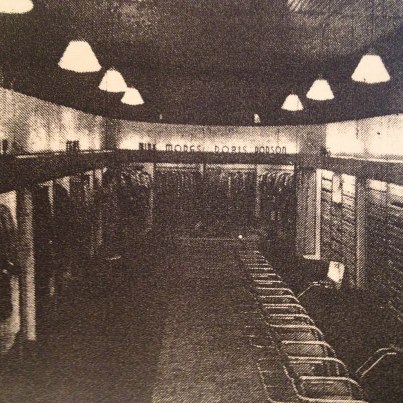
This department store operated in the building formerly occupied by A. Hartung & Bro. department store. Plans for the store were drawn by Harry Ryan superintendent of the store planning division in St. Louis. The store operated in a 3,300 square feet floor space, plus 5000 square feet on the second floor where reserve stock was held. The interior was a natural finished Philippine mahogany. The store carried a line of clothing, ready to wear, yard goods, work clothing, shoes and fashionable millinery. The store was managed by Norman Walling, Mt. Vernon resident who for the previous ten years was head of the men's department of the Stinson Bros. Company. Other store personnel were Miss Dixie Wallis as cashier who worked the past seven years at the Hartung store, Miss Mary Blackburn, who will handle the domestics and lingerie departments, Miss Lillie Sherretz, supervises the ladies ready to wear department and assists in the men's clothing and James Woolsey, who will also assist in the men's department.
Your Vote Counts.,., "Pop" Elected by Only 23 Votes.....1942
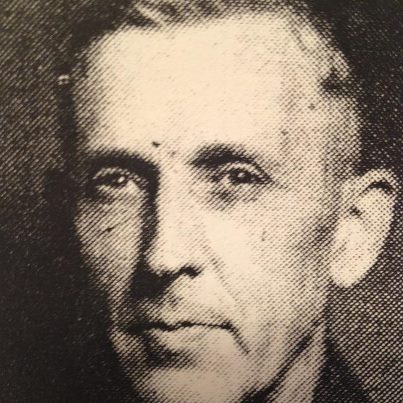
Frank J. Fessenden, Democrat defeated the incumbent, George A. Krug by the narrow margin of 23 votes-1146-1123 and continued the jinx that is mayor of Mt. Vernon. No one could ever win a second term until Jackson Higgins ran off, what was it, six straight? As is the norm....the local Dems made a clean slate of the city slate. Also Republican cartoonist Glenn Curtis once lost in his bid for Mayor by only 8 votes. Last year Wendy McNamara had a recount and the "Bloody 8th District" has had several controversial endings for House seats. And of course those 537 votes in Florida that could have made Al Gore President and prevented a war in 2000.
MV Man Watches Man Fall 50 Feet and Walk Away.....1942
A local man working at the Republic Aircraft Defense Plant in Evansville saw a worker fall from a scaffold approximately 50 feet high and walk away! Yes, after lying there a few minutes, he arose, shook his hand and started for the office, a few yards away......An ambulance rushed to the scene of the fall with sirens screaming and a doctor and nurse arrived about the same time. They followed the man into the office where he calmly lit a cigarette...."Aren't you hurt"," the doctor asked. "No, just shook up a bit," the worker replied....the doctor ordered the ambulance driver to bring out the stretcher to take the worker to the hospital...."I'm not going," the man said...."Yes, you are," the doctor insisted...."If I do. I'll ride up front with the driver, "the worker stated, and he climbed into the front seat....and they drove off. The man was back at work the next day. We would be required to take a drug test today, be discussed in a meeting, make out an incident report, fight over whether it is a recordable or not, take nothing stronger than an aspirin, and be told how to properly hold on to a scaffold with a three point contact....oh, sorry no quarterly bonus, but your insurance will be going up...here's a voucher.
Mt. Vernon Native Made Brigadier-General.....1942
Col. Patrick H. Tansey, 48, a native of our city, but in recent years of Memphis, Tennessee was advanced to the rank of temporary brigadier general in the Army by order of President Roosevelt. He was immediately confirmed by the U.S. Senate. The mother of the new general was a sister of Charles A. Joest of Mt. Vernon and Mrs. Laura Wade of Evansville. His father and mother were Henry and Anna Joest Tansey. Tansey is a graduate of West Point and spent his early boyhood in Mt. Vernon. Tansey 1894-1976 was chief of material division and War Department General Staff during the Second World War He retired in 1953.
1942 Booker T. Washington Blue Devil Basketball Team
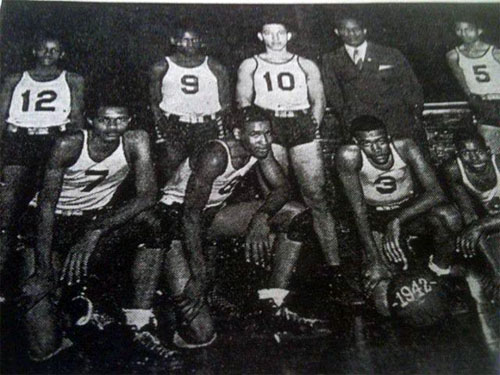
Old Cooper Shop Razed.....June 1941
Back in the 1860's a cooper shop was constructed on North Mill Street and the L&N railroad. This was started by John Moeller. His son John H. ran a similar shop on Wolflin Street. Products from the plants were used by at least four of the mills in town including the hominy mill. The staves and other items were transported to the local mills by a large horse drawn wagon. After a fire in 1911 the shop on Mill Street was severely damaged and the elder Moeller retired shortly after. Eventually, People's Bank owned the property and it was torn down by a contractor. At one time it was one of the town's most important employers.
B.O. Hanby Goes to New York....Worrys About War.....January 1941
Local historian, B.O. Hanby was in New York and asked an officer in the know if he thought the Germans of this country would be loyal to our government .He said that those who were citizens would be. Those that were not he was informed should be watched, especially those that were sneaking in from Europe. The next day he was sitting in a waiting room of the New York depot, when a large German came in and he knew he was from Europe by the labels on his satchel. He carried in his hand what looked like a long stick, wrapper up, but an end of it was loose and he saw that it was a map. He sat down and soon another German came and they were glad to see each other. They talked in German but now and then I caught the word Washington. He wanted to know what the map was, but he lacked the nerve to ask for it. Later, Hanby talked to a congressman if he thought we would be going to war. He said yes. That it was going to be like the last World War, the same thing ever again and Germany would be whipped. The congressman said this war would be so terrible that war would forever be done with and people would rise up against war in the future.
George McCarty Purchases Local Taxi Service.....1941
George McCarty of the McCarty Coal and Oil Company purchased the Red Cab Service, a local taxi firm, from Arthur Willingham. Office was moved from East Second Street to the McCarty firm at 334 West Second. Day and night service would continue.
Trapped Bald Eagle Given to the Zoo.....1941
A bald eagle with a 10 foot wing spread, caught along the Wabash River in Posey County by "Happy" Melton and George Groom of Mt. Vernon, was presented to Mesker Zoo. The eagle was caught in a trap and was not injured. My question is if he was "not injured," why was he not released?
WTH?.....1940
"Jiggs" walked into a local Mt. Vernon store to purchase some long-legged underwear....but the only kind they had with long legs had long sleeves, and "Jiggs" wanted short sleeves....so the obliging salesman said he would cut off the sleeves and deliver the long-legged underwear to the purchaser's place of business.....but you may well imagine the consternation of "Jiggs" when he opened the package and found that one of the sleeves and one of the legs had been cut off....but 'tis said he finally got what he paid for......
"It's Lovely Weather With A Sleigh Ride Together".....1940
In January of that year a real honest to goodness, full-sized sleigh gracefully was seen gliding over the streets of Mt. Vernon.....the sleigh had horse power....it was attached to a brand new automobile and on either side of the sleigh and at the rear were lanterns for warning signals...the cops thought it was neat....and the occupants had a good time with no fear of going to the pokey. "Those were the days my friend."
Posey County 4-H Club Picnic.....1940
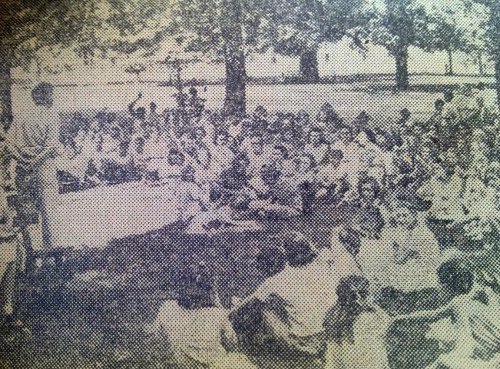
Parents brought lots of food and the day was devoted to games including softball, volley ball, horseshoes, relay races, dart games and other activities. Over 450 children enrolled in Posey County.
WPA School Projects.....1940
Federal approval of a $14,000 WPA allotment to improve Mt. Vernon school buildings was announced. Improvements included in the project included installation of new lavatories at Central and Booker T. Washington school buildings; re-decorating of interiors and painting of woodwork of all buildings; new outside doors for Riley and Central buildings; sealing of High School gymnasium and changes in electrical wiring at the High School building. Also added was painting and repairs at Athletic Park.
1930's
Building on Main Razed.....August 1939
Main Street always continues to change...many buildings that have been here for 130 years are going down left and right. There has always been change. That summer a little frame business building between Fourth and Fifth streets, formerly occupied by the Green fruit store bit the dust. The building was owned by the Rosenbaum heirs and had been condemned by the state fire marshal. The newspaper said it had been there "ever since anyone alive can remember."........."Time keeps slipping, slipping into the future."
Overall Factory Makes Changes.....1939
In July the local factory on North Main ceased to make overalls, which were moved to Evansville and our factory was "doing more advanced work in the production of men's clothing." The papers told of an abundance of orders and some 250 persons were now employed making and average of $2 to $3 per day.
Locals Buy Mt. Vernon Ferry.....April 1939
David Ashworth and J.W. Vail purchased from Bert Downen the Mt. Vernon ferry on the Ohio River. The transfer involved the gasoline boat Dugan, ferry flat, docks on both sides of the river and the franchise.
Skating Now at Paragon Too.....January 1939
The floor of The Paragon was re-sanded and put in first class condition for skaters as well as for dancing said owner George Bottomley.
Martin W. Smith "Artscraftsman".....1930's and 1940's
Mr. Smith lettered many a store sign in Mt. Vernon in his day. His brush produced walls of distinction. In the Old Heidelberg Cafe on Main Street he painted three murals representing the ruins of Heidelberg castle, the huge wine cask and the castle before its destruction. Each was four feet by twelve feet. Martin's father, Frank Smith, was a student at Heidelberg. Smith was a boy artist and served the Evansville Courier as the Mt. Vernon correspondent for several years and likewise for Cincinnati, Chicago, St. Louis and Indianapolis for anything happening down here. He was associated with Oscar Keck, electrical firm in the Poster advertising company. Art work, lettering, and kindred subjects have been his work since high school. He had many an opportunity to go to a larger city; but preferred to remain at home.
Shooting Gallery... Just What We Need.....1939
Carl Moore, of Aurora, Illinois rented the Main Street building of Nick Andriakos, formerly occupied by the A & P and hopes to have a shooting gallery.
Tour of Posey County Jail.....1939
My friend Leonard Brown took pictures a few years ago inside the old jail on Mill Street and it was an eye opener. Back in 1939 one unnamed local citizen had been reading about the horrible conditions of prison life a century ago and decided to visit the Mt. Vernon prison, er.. jail. He found the place strictly clean and with "good moral management." He said the sheriff and his wife look after the home and reception department and superintend the jail proper. "The Sanitary Court," keep their abode in a spotless condition free from bed bugs and vermin. If an inmate came in with bad physical appearance he was required to take a bath and his clothes fumigated and given sanitary treatment. The basement revealed some of the methods of the past however. "There was a very dismal dark cell where unruly prisoners were thrown in as though they were wild beasts. This treatment was supplemented with instruments of torture in the way of heavy shackles and not so very long ago prisoners could be seen on the street known as a chain gang, as some of them were fastened to a chain attached to an iron ball." ~Wavy~ thinks objects like this would be great items for the Historical Society. The ropes of the lynching of the Negro men on the court house square long ago were visible. "They still are in good condition and ready for use if need be."
Restoration of Old Rapp Labyrinth.....1939
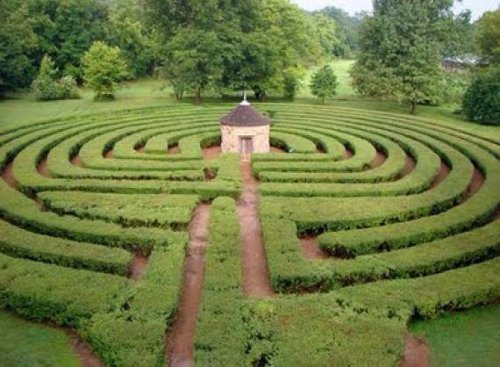
The labyrinth was described by Robert Dale Owen as "a pleasure garden of small groves and gardens, with numerous circuitous walks enclosed by high beech hedges and bordered with flowering shrubbery, but arranged with such intricacy, that, without some Daedalus to furnish a clue, one might wonder for hours and fail to reach a building erected in the centre." Daedalus is mentioned by Homer as the creator of the Labyrinth on Crete. Here a thread was given to Theseus to find his way to kill the Minotaur, a being of part man and part bull. The site for the labyrinth, located on Main Street near the south outskirts of New Harmony, was donated by Clarence Thomas, of New Harmony. Mrs. Bertha Crosley Ball, Muncie philanthropist donated $5000 for the project.
Old Coin Found in Cynthiana.....1939
While digging sweet potatoes, Homer Williams uncovered an old Mexican coin which was dated 1831. It was a copper coin just about the size of a silver dollar. On the face it had "Republica Mexicana" and the symbol of an eagle. On the reverse side it had a symbol, which might be that of a rising sun and inscriptions of letters which to we gringos are meaningless. I have no idea of its worth or denomination.....but cool.
Working as a Miller for 64 Years....and Still Counting.....1939
Louis Schnur was 75 in 1939. As a small boy he lived on a farm near Mt. Vernon and his father bought a mill that was on the spot where the Sunlight Mill stood later on at Water Street. Louis at 9 years old started to work at that mill. When grain came in they measured by the sack as there was no truck dump and machinery like later on. They ground the grain on stone grinders. The mill, like many burned and was rebuilt as the Sunlight which was bought out by the Home Mill and Grain Company. Louis stayed on...and on.....and on.
Got Me A Houseboat.....Ready for the Next Flood...Bring It On.....1939
James Dawsey thinks he has solved his problem of having a home subject to large flooding like we experienced in 1937. He bought a portion of land back of the Water Works, and at first he thought of building his house on poles, but changed his mind when he found out a house built that way had been undermined and swept away. He then purchased a large well built house boat in Evansville and had it moved to the bank of his property. He called upon Clarence Kuhn, who makes a business of moving things and with his help, the house boat was pulled up an placed in a desirable position on his land, He even had piped water from the Water Works in is home." Let 'er rain...James is gonna ride it out!"
Got Me A Houseboat.....Ready for the Next Flood...Bring It On....1939
James Dawsey thinks he has solved his problem of having a home subject to large flooding like we experienced in 1937. He bought a portion of land back of the Water Works, and at first he thought of building his house on poles, but changed his mind when he found out a house built that way had been undermined and swept away. He then purchased a large well-built house boat in Evansville and had it moved to the bank of his property. He called upon Clarence Kuhn, who makes a business of moving things and with his help, the house boat was pulled up an placed in a desirable position on his land, He even had piped water from the Water Works in is home." Let 'er rain...James is gonna ride it out!"
About Town; Early Morning Scenes.....Late August 1938
The signs of fall were in the air as there was an added impetus of coal trucks and shipments of fall merchandise arriving at the downtown stores. Johnny Mills was unloading two truckloads of heating stoves at Alles Bros. Furniture Company, Stinson Bros, was having a sidewalk suit sale for 25 cents! No refunds. Workers of Eilert Farm Equipment could be seen before opening time discussing the gossip and smoking cigarettes. Mann Grocery was taking huge orders and loading their bakery trucks. Icemen Eddie (Slick) Kost and Don Coker were making their rounds. The Western Star saw Henry Schaefer, well known lower Main barber running late in a hurried jaunt to work...."Junior" Duckworth was setting up a window display in a downtown store and activity was brisk at the Mt. Vernon Creamery with the delivery trucks. Good day to take off I say, head to the river and throw in a line.
Famous Race Horse On Train Through City...People Come Out to Wave.....1938
Stagehand, famous American race horse, the only horse ever to win the Santa Anita Derby and the Santa Anita Handicap in the same year, traveled through Mt. Vernon in a special car attached to a L&N passenger train. Churchill Downs was destination. Also riding with Stagehand was the horse, The Chief, another entry. Owners, trainers and jockeys also on board. In 1938 Stagehand raced 15 times winning 8 with 2 second place finishes even beating famed horse Seabiscuit.
What is the Oldest Building On Main Street?.....1938
That question was asked in the Mt. Vernon Republican newspaper of 1938 and they went in search of the answers. Some had dates right on the sides like City Hall, 1893. Other buildings occupied as follows: 1884 Gronemeiers; 1888 Oscar Keck, Neuway and Niblo; 1886 Weckesser; 1898 Bank and Express office; 1884 Hermann Jewelry, Garrison Radio, Electric Office, Abstract Office of Anderson; 1887 Gentile Restaurant; 1885 Mann's Tailor Shop; Dagget's Place and the Arrow Restaurant each had 1881. The oldest building they said was recently torn down. It stood next to Forthoffers on lower Main. The oldest then standing was on the northeast corner of Main and Water. These buildings when constructed were not longer than 60 feet, a back edition being added later on. Roser & Roser kept a general store in the south building. At that time there was a barrel of whiskey in the back part of the store and a tin cup. "After all it is Mt. Vernon." If a customer wanted a drink he could go back and get it free of charge, but if he wanted a gallon it cost him 65 cents. Jeans cost 90 cents a yard and thread a dime a spool. The store of Reedel Company was a bank conducted by Lowrey & James and James Gardner had a drug store on the north side.
Hanby is Heard On National Broadcast.....1938
B.O. Hanby, local publisher and historian was heard on the CBS nation-wide hookup broadcast of the "We the People" program. Hanby was in New York for ten days as guest of the program sponsor. In the interview, the Mt. Vernonite told of his father's career and of the writing of the classic, "Darling Nellie Gray," for which he received the grand total of $50. At the conclusion of the interview a studio ensemble sang the ballad.
Failing Vision Ends Dr. Hovey's Dental Career.....1938
My friend Barbara Lanman-Givens asked me the relationship of Dr. Alvin J. Hovey and General and Governor Alvin P. Hovey. I'll get to that in a moment. Now Dr. Hovey practiced dentistry in Mt. Vernon for forty years and because of failing vision he gave it up. He left Mt. Vernon and visited his daughters Helen, Louise, Florence, Esther, and Anna Jaques. Anna Jaques at the time was Anna Hovey, a Hollywood actress. So let's get to the genealogy shall we? Alvin Peterson Hovey had several children and one of them was Charles J. Hovey. Charles married Lillie Jaques and they had five children. One of these was Dr. Alvin Jaques Hovey and Alvin J. was the father of Anna the actress making General Alvin Peterson Hovey, Indiana's Governor the great-great-grandfather of Anna. Everybody got that? That's too much begetting for ~Wavy~ to keep straight too long.
Idlewild Cafe.....1938
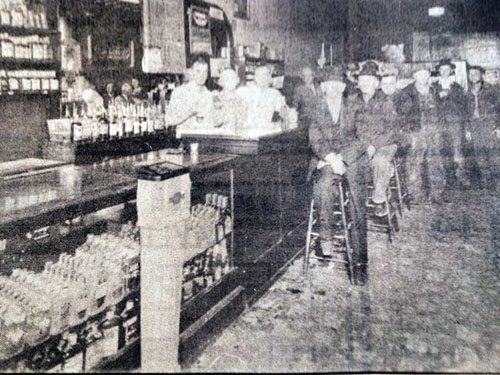
Manuel Curtis, Mrs. Souders, Ross Benner, ?, Mr. Fetter, Bill Oeth, Harvey Schelhorn, Elmer "Speed" Schelhorn, Walter "Jim" Schelhorn, Syl Mattingly
Man Has "Fit" Taken to Insane Asylum.....1938
This guy he seems to have had some sort of fit on Main Street. He threw himself on the street, struggled with an imaginary foe, worked his face into contortions, and was having a real hard time. People and police held him down and a doctor was called. Later it seems he was taken to a psychiatrist who looking him over advised the patient to "behave himself as there was nothing really wrong." He pronounced him "starving for attention and putting on a show." The Sheriff wanted to know if the doc was sure, because he had seen enough of him. The doc said he would admit him on a temporary basis to see if the patient would continue his "melodramatic acts."
USS Akron Flies Over Posey....October 1931
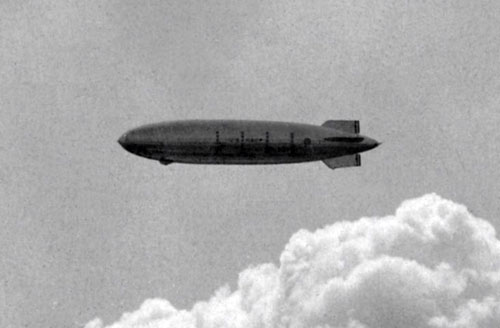
The giant blimp, the Akron, just weeks into its trial period passed over the northern part of Posey County. Many motored out to a point east of Mt. Vernon to get an excellent view of the airship, the largest in the world. The Akron was 785 feet in length and carried 6,300,000 cubic feet of helium gas reaching speeds of 58 mph. The ship built for the U.S. Navy was destroyed in a thunderstorm off the coast of New Jersey in the spring of 1933 killing 73 crewman. Although the Hindenburg was 20 feet longer it used hydrogen and not helium. A sister ship, the USS Macon, crashed in 1935.
The Republican Press Urges Trees at Court House.....Summer of 1937
Another hot scorcher of a summer was upon us and with no air conditioning , the town was simmering and looking for relief. In the midst of a contract to paint the court house for $900, the "Republican Press" newspaper called upon for trees and shrubbery to be planted on the sun scorched grounds of the court house. "Nearly every city surrounds its public buildings with heat defying trees and plants, and while the court house is county property, it certainly can claim no immunity because of that. True it is that memory of the sad incident that killed the last trees around the court square (lynching), but we've traveled a good many miles since then and there seems little or no danger of a recurrence of such an event. In every way, The Press believes that Mt. Vernon itself would be benefited by a down town park and it is something, we have been telling the local civic organizations to put in their programs." Also of note, the paper again called as it had for several summers for a public "bathing beach." policed by qualified life guards. They said there had been too many tragedies in the Ohio River from drowning and they wanted a safe place to be watched either on the Ohio or an outdoor swimming pool. One idea was on College Park where the "old Castle School" once stood.
Do you see the boat to the right of the water works in this 1937 flood photo?
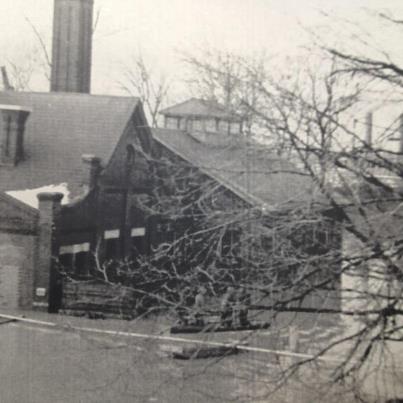
Mt. Vernon Pumper from 1937
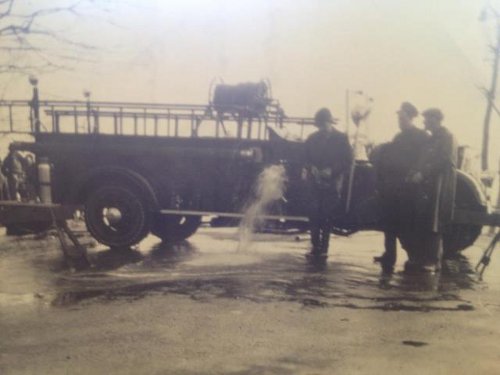
Picture was probably taken at one of our streets near the river to wash away debris from the great flood.
Local Cheese Factory Cuts and Runs.....1937
The Mt. Vernon Cheese Factory, which had operated in the rear part of the Mt. Vernon Creamery Company building on College Avenue moved out to Newton, Illinois. I guess that swarm of bees that was hampering traffic in that area will just have to stay with milk and cream from now on.
Cook Your Brownies in the Kiwanis Oven.....1937
It seems the Kiwanis Club had an oven, and they originally kept it down at Black's Grove where the town had picnics, celebrations, political speeches, and once a organizing of a mob for a hanging. By 1937, I guess the Grove was starting to lose its interest, so the oven was torn down and reconstructed on the northeast part of Central grounds by the WPA. The public was invited to make use of the oven and plans were to erect table and benches at the oven site. Please do not park your car in the grave yard!
Hovey.....1937
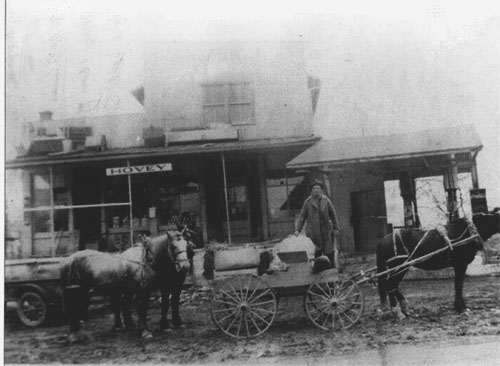
Model Bakery Installs Modern Oven.....December 1936
Adam Goss, owner of the Model Bakery, located on East Third Street in Mt. Vernon installed a Hubbard Reel Revolving oven. The oven is stoker-fired and is an investment of $5200 and has a thermostatic heat control which insured uniform baking. The capacity of the new oven was 300 loaves, doubling the old method. Before this it took an hour and a half to bake a batch and now just 45 minutes. Bread and pastry made here was said to be some of the best around and their territory of business has increased necessitating the expansion and improvement.
The Evansville Journal Newspaper is Discontinued.....November 1936
A newspaper that lasted 103 years died that day due to high costs and the prospects of higher wages, paper costs and taxes. With the Evansville Press and the Evansville Courier around it was doomed. It was known as the Republican newspaper and in recent years, "like its candidates it utterly failed." LOL. It was even ignored by the Vanderburgh County Republican organization in advertisements at its close. Mt. Vernon's Republican papers in their varied forms from the "Free Press, " The Republican News," "The Public," and "The Mt. Vernon Republican" would find similar fates over the decades. The paper however would be missed by older subscribers who remember it as the voice of the Republicans in what once was the old First District.
Article on "Miss Indiana" Leaves Me Puzzled.....August 1936
On the corner of page one of "The Public" it said Miss June Duckworth of Mt. Vernon was given the title of "Miss Indiana" in the bathing beauty contest sponsored by the American Legion, held in Muncie. She went on to represent Indiana in the national contest in Atlantic City. I have never heard of this before and I wonder if the Mt. Vernon they are talking about was upstate. If she was really from here, I would think they would have a picture, even in the depression years. Surely, they would list her parents and address, don't you think? Oh well, maybe I should try looking for this in the "Mt. Vernon Democrat"....you know for the facts! The Republican paper is funny to read how Hoover is trumping Roosevelt in poling nationwide and then came Alf Landon...same thing..."Alf leads by 3 to 1 margin in early returns." Hahaha Two weeks earlier, however, it didn't mention that the Owen Dunn post was looking for a "bathing beauty" to represent the city in the state contest. She had to be 16-25 years of age and a local resident. No swimming was required...."just look good!"
State Refuses Field for Swimming Pool and Golf Course.....August 1936
Mayor Herman Bray learned from Governor Paul McNutt (D), that the city's request for a 14 acre tract of land on North Main Street used as a pasture for Battery E horses before the outfit was motorized, could not be granted at that time. The tract of land was sought by the city as a site for a municipal golf course, swimming pool, tennis courts, and general recreation center. McNutt advised that the federal government may use the field as a maneuvering ground for Battery E's motorized equipment. Mt. Vernon contributed $1000 towards the purchase price of the field when it was donated to the state for use by Battery E and also assumed the taxes. The city believed that since it was currently not in use, it should have been given back to the civil city of Mt. Vernon.
Let's Have a Party!.....May 1936
The Republican Press editor, William Tischendorf Jr. despondent over the small Republican turnout in Posey primary decided to look for something good. He proposed a "Gala Day" to celebrate the long awaited re-surfacing of Main Street. Merchants could put their wares out on the sidewalks but urged the public to "leave your illegal hootch at home ".
Local Steeple Jack Tumbles Twice...."Born Under a Lucky Star".....May 1936
Jack Rose, local high climber sure is a lucky fellow! Following a fall on St. Matthew parochial school on a Saturday morning in which he owed escape to the fact that his shoulder caught between a chimney and a gutter and held him; that afternoon Rose tumbled 50 feet from the steeple of the St. Matthew Church. This time Jack was soldering of a cornice of the church steeple pulling it loose, causing him to fall. He landed on the church roof, rolled from there into the roof of the nun's home and then onto the porch where he caught again on a gutter. Except for some severe bruises he was okay. Time to go home for the day.
In the ice gorge of February 1936, various groups of Mt. Vernon and Kentucky men and boys crossed the Ohio River on foot.
During that time the receding stage of the Ohio River under heavy shore ice left the Ferryboat Dungan, in the Mt. Vernon port perched atop broken cakes of ice 15 feet above the water's level. Joe Vail, ferry operator, said the craft had not been damaged.
Ad in "The Republican Press" of which subscription was $1 per year in 1936
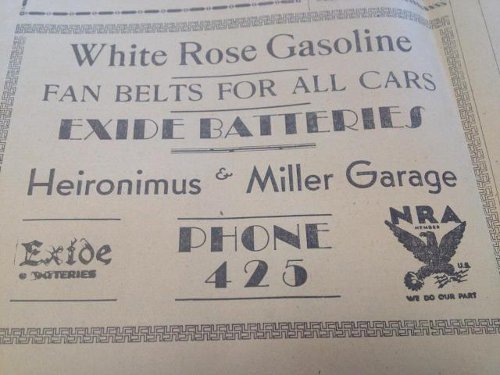
How about those swastikas for a border? White Rose gasoline was introduced in 1905 as the first premium motor fuel produced by the National Refining Company. Gasoline prices in Mt. Vernon along this time were between 16 and 18 cents a gallon.
Ten Boys Warned Not to Kill Song Birds.....1936
Okay folks, my first ever story from newly found, "Mt. Vernon Free Press." Sounds like some of the publications I wrote for in the 70's; Oh well. The story goes that following up on complaints the Chief of Police a Mr. Basil Cox headed to the Central Elementary and High School and pulled out the alleged offenders and warned them about their air rifles and sling-shots. He scared them so much that he took them down to see the Prosecuting Attorney, William Espenchied. The "man" explained the legal penalties for their actions and the boys took an oath "promising to give up the practice of killing birds," forever and ever.....Amen.
Dietz Grocery Becomes Mann Grocery.....1936
Fred Dietz passed on having had the Dietz Grocery on Second and Mill since 1888. The store came into the possession of a nephew of the late merchant and was sold to Karl Mann. Paul Roy, son-in-law of Mann who was employed at the Stocker Grocery until recently, will manage the new commercial business.
Supplement to Mt. Vernon Public Newspaper of 1936
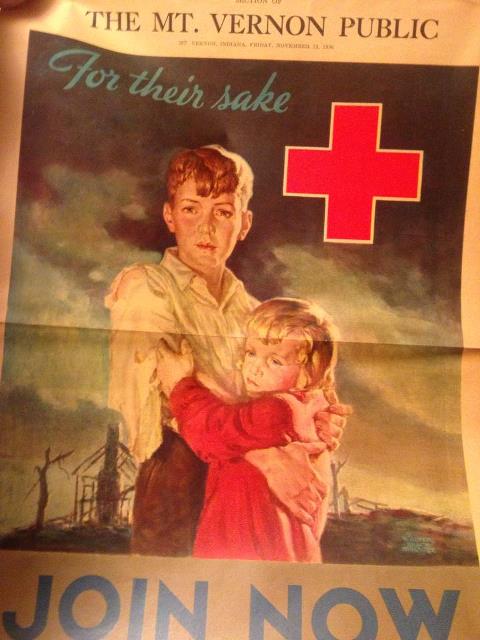
Other 1936 Gleanings.....
- Bert McReynolds, well-known barber resumed his employment at Ed Turner's barber shop on West Second Street.
- WPA (Works Progress Administration) opens an office at the Armory Building on lower Main.
- Erection of the Eilert Farm Equipment Company started at the corner of Mill and Fourth Street.
- Restaurant and Grocery opens at the former Oliver stand at Main and LN railroad.
- In special meeting of Owen Dunn Post #5, American Legion in the coliseum colored WWI vets were special guests. Charles Rachellor, commander of the Otis Stone Post, colored legion of Evansville had a special message for colored vets.
- Dr. Frank Oliphant located his practice in town.
- Two dimes and a nickel were found in a bird nest in town.
- President Roosevelt was in Indy
- 33 members of the Mt. Vernon National Guard unit were called for duty to assist.
Red Cross Chapter Gets 6 Steel Boats.....1936
The Posey Chapter of the American Red Cross, through Chairman Dave Alldredge, secured six steel hull boats for emergency use on the Ohio River. The boats had air-tight compartments and are nonsinkable.
Major Kimball Celebrates 92nd Birthday.....December 1935
Major G.W. Kimball of College Avenue, Grand Army leader and prominent Mt. Vernon citizen, celebrated his ninety-second birthday on a Saturday. For four years Kimball served on the staff of Governor Alvin Peterson Hovey and Governor Ira Chase, who succeeded Hovey to the office made vacant by the death of our Posey County's honored son. Major Kimball was the only remaining white Civil War veteran in Mt. Vernon. His military service during the war was under Generals Nelson and Manson and one of his prized possessions was the sword given him by Col. John R. Mahan for valorous service in the battle of Richmond, Ky. He was one of the few living men alive to see the body of Abraham Lincoln as he lay in state in the state house in Indianapolis en route to Springfield, Illinois for burial. He was also the last survivor of the military staff of Governor Hovey.
Old Papers Surface...New to Me of Their Existence...1935-36
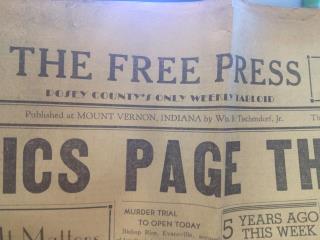
Boxes of old newspapers were turned into the Posey County Historical Society from the recycle center. I have looked at everything that is microfilmed in our county libraries. I have read history books that told of old publications, but I have never seen or heard of these before. They are flaking badly and yellowed and probably not worthy of being microfilmed; but I sure hope I get to look at these before they will have to be discarded. They got that old musty smell; but they deserve to be looked at for glimpses of the past. The Free Press (actually cost a nickel) but it had an office at 619 East Water Street and the editor was Wm. B. Tischendorf Jr. The papers seem to be about 8 pages long with the front page being the only local news. Two pages were pictures of national events. Some cool ads of local business too. I will try to put up a few from time to time when I get more of a chance to read them. Oh, I love finding new stuff, especially when it is old stuff!!!
Other paper picture.....1935
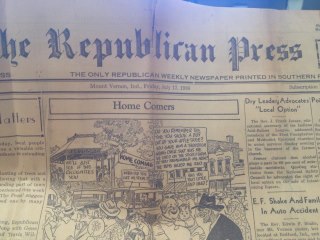
Trouble in River City.....1935
Mayor Herman Bray in 1935 requested that all card playing and pool playing in public card rooms and billiard parlors suspend on Sunday. If voluntary suspension does not occur he vowed to seek adoption of a city ordinance requiring such suspension.
Bishop Grocery.....1935
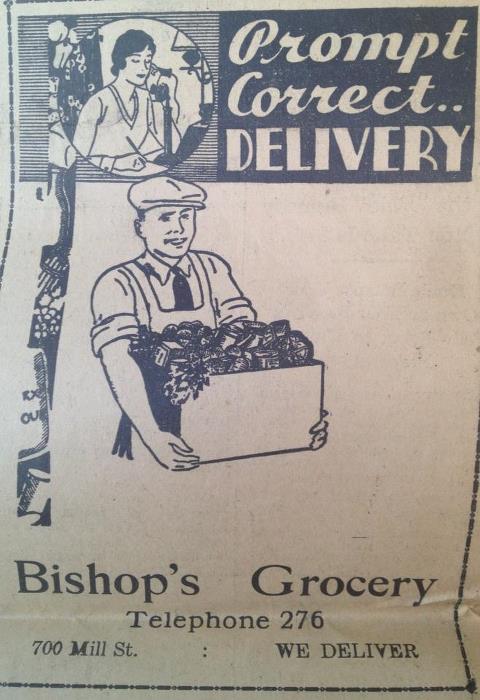
Traffic Problems....1935
During the week it seems there wasn't too much problem with the flowing traffic. Hell...they even had to put up "No U Turn" signs on Main Street as out-of-towners consistently did that! Well, the town fathers started painting parking spaces on the street for parallel parking and asked people who came to town on Saturday to sit on the court house stoops and gawk, not to park their cars on Main and leave them over a half an hour. Let someone else have a place.....merchants need the business.
American Legion Baseball Wins Regional Championship.....1935
Owen Dunn Post won the junior baseball tournament by beating Princeton and then Tell City 6-1 in the championship game. In earlier games they had defeated Paoli 3-2. Dale Gentil and "Dutch " Wehr were superb on the hill. Mt. Vernon lost in the State tourney 3-0 to East Chicago.
Old Man Evans Recalls His 19th Century Youth Looking Back From 1930's...
When I was a boy, milk was delivered in a tin can at 5 cents per quart, fresh county butter, with a pansy on top was 15 cents per pound, hens made money laying eggs, three dozen for a quarter, old rooster were 10 cents each, ; the butcher gave away liver and treated his customers to bologna; a kerosene lamp and stereoscope in the parlor were luxuries, people walked miles to wish their friends a Merry Christmas; the boot-jack and the Dutch oven were the main kitchen equipment; high heeled shoes and dancing pumps were unknown; the cow bell and the dinner bell made sweet music; log rolling, husking and quilting bees furnished opportunity for the strong men to show off or for gossiping women to exercise their tongue; the Virginia Reel and the quadrille dance was the occasion to trip the light fantastic toe; the country fiddler was the king; moral standing was a cherished compliment; pride and common decency were an asset to human character; the people who advocated the automobile and air machines were promptly carted off to the crazy house; the sleigh and the sled in winter and the buckboard and the family shay in summer were the principal modes of transportation; a "Jackass" was a "Jackass" then the same as now; young girls were dressed up and smart aleck boys were dressed down; powdered faces and rouged lips were found only in the "red light" district; we read "Wild West Stories" instead of going to the movies; we went to bed on the same day we got up; churches were full and the jails were empty; if a person did go to jail that person was an "outcast" from that day forward; the sanctity of the race was virtue; the ambition of a man was to own a home instead of a Ford; the desire of a wife was to have a large family and stay home and take care of it; our food was served from a fine old pastry cupboard instead of from a tin can. In this jazzing, suffragetting, pussyfooting, profiteering, excess tax and prohibition days if you think life is worth living, I sincerely wish you a Happy New Year."..............Well folks, most people seem to long for the past or see it lovingly different than it actually was...I can attest that crime existed here in Mt. Vernon since our creation and reading the papers I read of more murders then than now. The jails were seldom empty. Women and minorities didn't share in prosperity and opportunities...it was a white man's world, dominating and exclusive. Of course, there were pleasures of any age that we miss. Mr. Evans has a right to his opinion.
"Bird, Bird, Bird Is the Word.".....1935
Mr. Whipple, Jasper that is...farm manager and real estate agent was driving on Highway 62 from Mt. Vernon at a very high rate of speed when a flock of sparrows coming out of a field swooped down directly in the path of his car. Jasper got out, checked his automobile and counted 47 kills by the collision....."Good Evening."
Negroes to be Sent To Wadesville CCC Camp.....1935
Plans were made to send a "colored" population to the newly established Civilian Conservation Corps, a public work relief program to Center Township. This has come under controversy and unless appeals of the community leaders mandate a transfer of white recruits and is granted this will be the case. I found no follow up to this story other than an advance group of black men had been working in the area erecting barracks on the camp site for several days. It was estimated that between 250-265 men will be moved into the camp at intervals during the following three weeks as quickly as barracks are available.
1935 New Harmony Rodeo
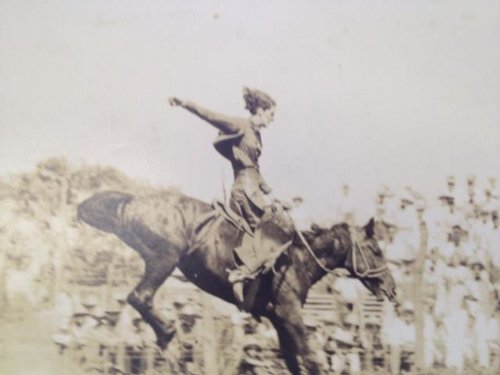
The Workingman's Institute had these fantastic photos that I couldn't pass up. I said I would give them credit. A few of these photos were even reproduced on postcards. Unfortunately, there are no newspapers of New Harmony between late 1861 and the end of the war. The publisher, C.W. Slater closed down the office and enlisted. The papers pick up again when he returns starting in 1867 with the New Harmony Advertiser.
Idlewild Cafe Opens.....November 1934
The Idlewild opened for public patronage at the southwest corner of Second and Main streets. John Sonder was the owner and operator. The building was made with booths and tables for patrons and served sandwiches, plate lunches, drought and bottle beer as well as soft drinks.
Out to Kill Rats; Mortician Accidently Kills Wife.....September 1934
Mrs. Grace Sullivan Weisinger, 50, wife of Lieutenant Colonel Merle Weisinger, local mortician, was killed instantly when a rifle in the hands of her husband was accidently discharged. Mrs. Weisinger with Mrs. A.V. Weisinger, her mother-in-law, was seated in the parlor of their home on Fourth Street. Merle entered the room to get the rifle, a 22 caliber Winchester, with which he was going to shoot some rats. As he picked the gun up it was accidently discharged. The bullet entered her head from the rear, traveling forward along the base of the brain and lodging under the left eye. Death came in about ten minutes afterwards. The Lieutenant Colonel saw service in France during the First World War and was in the infantry of the federal organized reserve corps.
Rodeo in New Harmony.....August 1934
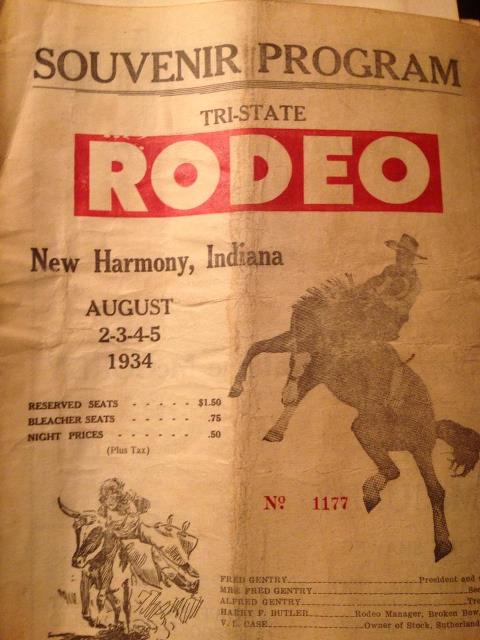
Evidently, there is some romance to a rodeo. This was put on in New Harmony by Fred Gentry. He staged a great show by all accounts. The program mentions events at the track and arena. I guess this was the old fairgrounds. It opened with a grand mounted march of contestants, Indians, Cowboys and officials. They had serpentine drill where cowboys rode around what I imagine were barrels and there were clowns and judges, timers and handlers. Clowns sometimes rode comedy mules and in one race one of the contestants was a monkey riding a horse. There was trick and fancy roping, professional calf roping, an Australian whip act, expert pistol and rifle shooting, bronco riding, Sioux Indian ceremonial costume dance, cowgirl bucking horse riding exhibition, high jumping horse, track and fancy riding exhibition, steer bulldogging contest, running race over a half mile, chariot race, wild brahma steer riding and a wild horse race. I can almost hear the announcer and the crowd as some reckless cowboy clears the chute chasing down a calf. The program shows contestants were mostly from Texas, Oklahoma and Wyoming. The ads in the program have some Mt. Vernon flavor like Consumer's Ice Company, E.B. Schenk Hardware. The Western Star newspaper, the Reedel John Deere Company, Gronemeier Hardware, Tank Car Oil Company and the Arrow Restaurant.
Brick Work Finished On Booker T. Washington School.....April 1934
Ed Stallman, superintendent of construction announced that all the brick work is done and it is now ready for plastering. 216,000 brick all taken from the old High School building on College Avenue now have a new home and soon will the students.
Mt.Vernon Library.....1934
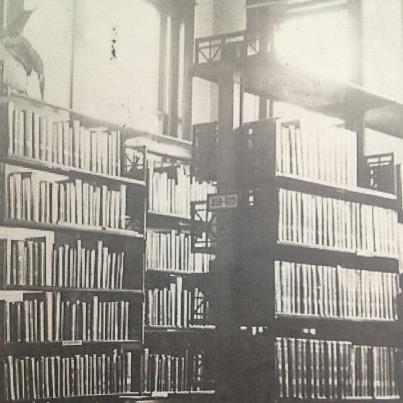
Mt. Vernon Library.....1934
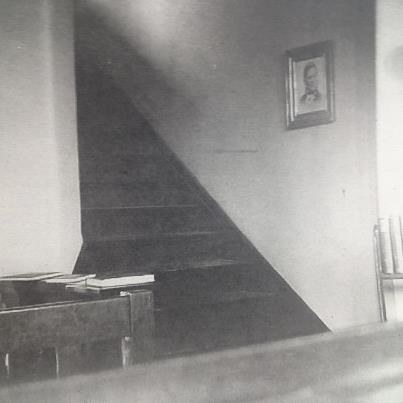
Another Government Program That Benefited Mt. Vernon.....1934
Some call it socialism, this redistribution of wealth from one neighborhood to another. That's how we got a Coliseum, a post office and now a grant for revitalized riverfront. Grants will come for a new police station too I believe. Back in 1933 the first Booker T. Washington School burned from a defective flue at Third and Owen Streets. Roosevelt came in as President and started many New Deal programs to stimulate the economy. One of his big ideas was the Civil Works Administration (CWA). The new BTW school was built by workers from the C.W.A. and the Public Works Administration. That program paid minimum wage for "shovel ready" work. The materials came from the old high school that was located on College Avenue and then then that area became College Avenue Park until the new Alexandrian Public Library was built. Booker T. Washington was used as a school until 1953 with high school students being integrated into the high school on Canal Street during the 1949-50 school year.
Acting Chief of Police Killed in Gun Battle on College Avenue....1934
A battle of revolvers on College Avenue between First and Second streets resulted in the death of acting Chief of Police Robert Randolph and Stephen Hembes, a concrete worker on State Highway 62, whom the officer was attempting to arrest for intoxication. Hembes had been drinking heavily during the afternoon and a half hour previous to the gun battle had been ordered to go home by Chief Randolph and patrolman Bevens. Following along in a patrol car to make sure the man went home they were crusing along College Avenue when Hembes fired three shots from his Colt revolver with the third shot hitting the officer. Randolph fired three shots from his Smith & Wesson pistol hitting Hembes in the temple. Randolph had been a Mt. Vernon policeman for 25 years and was a native of New Harmony. Hembes was born in Mt. Vernon and had an excellent reputation; except when he was drinking.
Memoirs of Civil War Days Here..... 1861-1865
In the 1890's records of the Committee of Safety organization were discovered on the shelves of the First National Bank. All these documents were turned over to Major G.W. Kimball, adjutant of Harrow Post, Grand Army of Republic, to be placed in with the Post's records. In 1934, Kimball disclosed some of the contents for the first time publicly. The first meeting of the committee of safety, the records show, was the morning of April 20, 1861 in the Clerk's office. Hostilities along the northern boundary of Kentucky, just across the Ohio River from Mt. Vernon, prompted our meeting, which had charge of various military components. Those present at the first meeting were E.R. James, J.D. Hinch, John Burtis, John Mann, John Pitcher, E.T. Sullivan, Joseph Edson, H.P. Casselberry, J.M. Lockwood, Thomas Newman, Charles Haas, Joseph Showers, John B. Gardiner, William Nettleton, Absalom Mackey, J.H. Chaffin, Jacob Dieterle, John M. Barter, Joseph F. Welborn, A.P. Hovey, and Milton Black. At the first meeting the governor was asked to provide arms and ordinance. The board of trustees of Mt. Vernon was asked for $1000 for the defense of the town and the finance committee was instructed to purchase all the powder that could be found in the town. That same afternoon a second meeting was held at which the first company of Mt. Vernon artillery, 210 men in command of Captain Jesse Oatman, reported for duty. Another semi-military unit of 100 men became known as "The Home Guard.' They were under Captain A.P. Hovey. We also had the Union Guard under the command of Captain Ferdinand Koch, the Mt. Vernon Guards, in charge of Captain William Larkin and the Posey Boys with R.F. Barter as captain. That sounds like a lot of units considering most young men were already in the war. At a meeting two days later, the Posey County commissioners asked for an appropriation for defense. All noisy demonstrations now became illegal on the city streets and no boys were permitted out after 10 PM at night. Strange to me during war time that no flags were allowed to be displayed from any business house, the court house or private residence for the duration. Seven days later they changed their minds regarding the display of the flag as Absalom Mackey was appointed to procure and erect a flag on the court house. Guards were put on the city streets starting in May of 1861. "All places of business within the town of Mt. Vernon shall be required to close up precisely at 10 PM and all persons found on the streets after that hour shall give an account of themselves to the officer on watch, and if not satisfactory such person or persons shall be put under arrest until morning, when legal proceedings shall be instituted against them." The committee passed a resolution in early May sending kindest feelings to their Kentucky neighbors and stood ready at the call to those who stood with the Union. On May 15th, a delegation from Kentucky visited Mt. Vernon and confirmed continued amicable relations and "friendly relations to the end by pledging our lives, fortunes and sacred honors." The meetings continued every Wednesday it seems and the last meeting recorded was August 20. 1861. At that meeting it was ordered that the trustees be authorized to take 100 guns and place them in the hands of the citizens for the defense of the town. Although no record is made of the incident, Major Kimball informed us that a company of Home Guards crossed the Ohio to repel the rebels during 1861 and this invasion was called the "Hovey Raid." My reading of this was that it was very controversial and atrocities may have been done. Five pieces of artillery were received here and were placed at advantageous points along the river front.
Negro Veteran of Civil War Dies.....1934
Josiah Foster, 93, Civil War veteran as a private in Company K, 111th regiment of the U.S. Colored Infantry, died at his home at 421 East Ninth Street. Funeral was at the Colored Methodist Church and burial at the colored Odd Fellow cemetery. The death of Foster left but one colored Civil War veteran in Mt. Vernon....William Tinsley.
200 Year Old Spectacles On Display.....1934
A pair of eye glasses over two hundred years old in the possession of Dr. N.N. Williams, Mt. Vernon dentist, were on display in the show window of Ike Rosenbaum, local jeweler and optometrist. They were hand made with rims and temples of wrought iron and the latter of hinged design. The lenses were very small. They originally belonged to Dr. Williams' great-great grandmother and were brought from England in 1740.
Indian Chiefs at New Harmony Rodeo.....1934
Among the Indians at the Tri-State Rodeo which drew large crowds was Chief Search the Enemy, a son of Yellow Robe who was a great warrior and powerful Chief of the Sioux, Chief Shout At was there who was known by his good nature and so was Red Goose, who was present at the "Custer Massacre." White Shield, who was a great dancer, was also in attendance. These Indians along with others were from the Rosebud division of the great Sioux tribe. They camped at a village of their own at the fairgrounds and played Lacrosse, put on many dances and participated in trick riding and roping. They were in charge of Clarence Cordry, who spent 30 years as a government agent among the Sioux and other Native American tribes. The local Boy Scouts also had an opportunity to study woodcraft and Indian lore from the Chiefs. Two carloads of Brahma bulls and steers were shipped in from Sonora, Mexico for the rodeo. Two people were hurt during the rodeo, but not seriously, and the affair was said to have been a financial success. Shorty Ricker, the world champion bulldogger was on hand and wrestled down a 1500 pound steer in less than 4 seconds.
Famous Evangelist Speaks in Mt. Vernon on Dangers of Integration....1934
Rev. E.J. Rollins, internationally known evangelist from Detroit accepted an invitation by the First Christian Church and helped lead a revival at the Coliseum. He was famous international figure and spoke at many undenominational services and at chautauquas. He was a favorite at law enforcement and was praised by "Billy" Sunday, Homer Rodeheaver, and Harry Clarke, also famous religious leaders of that time. He made a name for himself speaking of the dangers of racial integration and spoke of it in an aggressive way that stirred up his congregations. He was in the Billy Graham Motor City Crusade of 1953. Billy Sunday wrote of Rollins: "I have known him for years. He is a gospel preacher and conducts great meetings in Detroit every summer and has my absolute confidence and backing as a God fearing person."
1934 Sioux Native Americans are Part of New Harmony Rodeo
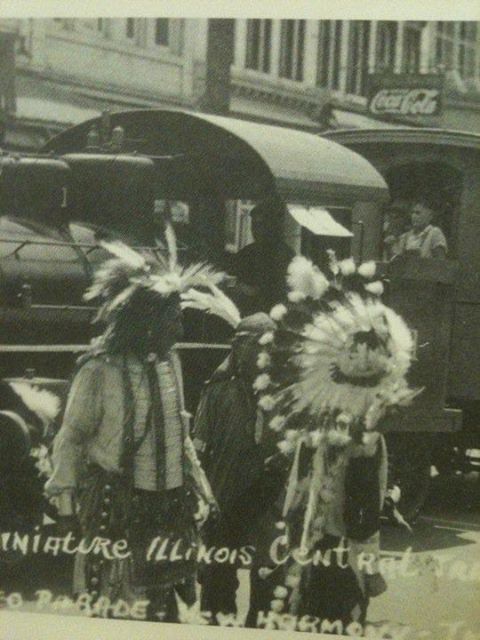
38,000 people came for the Tri-state rodeo. A mounted march to the grounds from a downtown parade with contestants, Indians preceded it. There was bull riding, bareback riding, Sioux ceremonial dance, etc. In 1935 a second rodeo came attracting large crowds with four ranked cowboys in attendance. A street parade included a 95 year old stage coach once belonging to the Wells Fargo Company. Music was furnished by a 22 piece cowboy band and 200 Sioux tribal members pitched their teepees on the New Harmony fairgrounds.
Airplane Flights at Grover Keck's Farm.....1934
Two planes for passengers, under the auspices of Keck Motor Company began fights for citizens at a charge at Grover Keck's farm east of Mt. Vernon on State Highway 62. The tri-motored all metal Ford cabin monoplanes with an open cockpit arrived here from Bloomington. The first six to ride were some of Mt. Vernon's finest: Charles Knowles, Philip Rowe, Paul L. Short, Beuford Alldredge, Grover Keck, and Clinton Maurer.
Hundreds Line Fourth Street to Watch Cavalry Unit Pass By On Way To Ft. Riley......1934
Schools closed, business was virtually suspended and our military delegation including Lieutenant Colonel Merle Weissinger, Edward Alles, President of Commerce Dr. Jenkinson and Captain Philip Rowe stood by and watched the First Cavalry unit of the United States Army, established in 1838 move along our streets towards the New Harmony Bridge. The unit included 587 men, 37 officers and 200 motor vehicles, under the command of Lieutenant Colonel Adna Chaffee. They had been on the move from Ft. Knox Kentucky to Ft. Riley, Kansas for summer maneuvers. One of the four Christy tanks had caught fire in Evansville and broke the regiment in half, resulting that the outfit passed through Mt. Vernon in two mains. They were making about 150 miles a day and had camped in Owensboro, Kentucky and would camp again at McCleansboro, Illinois on their way westward.
1934 Griffin High School Sectional Champs
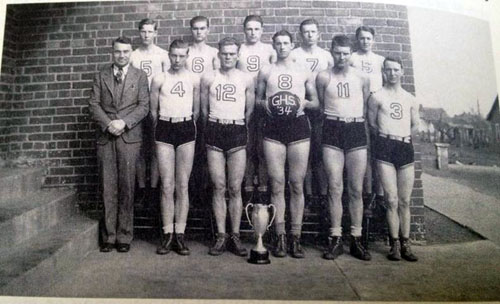
Coach Ray Goldman said, "None of my players wanted to sit beside me on the bench because I pinched their knees in the excitement of the moment." The Tornados defeated the Wildcats twice that season including the Posey County Tourney Championship game.
The First Booker T. Washington School in Mt. Vernon Is Destroyed by Fire.....November 1933
At that time it was the oldest school building in the city, built in 1872 by contractor Edward Brown. You have heard of Brown Street haven't you? Well, there you go. Carpentry work was done by Edward Brown, Sam Houts and William Smith. The building was framed by Adam Zuinger and Tom Alelen was the principal brick layer. Lumber was furnished by Charles Smith of Mt. Vernon (lumber yard, later Mt. Vernon Lumber) and Langstaff and Orm of Paduch, Ky., who shipped material here by flatboat. It was originally the Eastern School for white pupils.
Mt. Vernon Mill Opens.....September 1933
Operation of the new mill of the Mt. Vernon Milling Company, built on the site of the structure destroyed by fire a year ago opened. It will produce pearl hominy, hominy feed grits, corn meal, and corn oil and be able to convert 5000 bushels of corn each 24 hours. It was expected to provide employment of more than 100 persons. When the old mill was destroyed it had employed 92 people. The new mill is five stories in height, and a warehouse of three stories. Frank Keck is President of the Mill. So, when you are out and about check out the mill and look around....there is a pumpkin show on Main Street at the Standard Oil station, a clover seed show at Gronemeier's, a squash show at Strack's, a soy bean show at Oscar Keck's Craft Shop, a bailed hay show at the J.J. Moll feed and seed store, and the tallest stalks of corn around or on show at the Neu Way Cleaners and the Walton Maytag Company.
No Surprise...Posey Chooses Being Wet Over Dry.....June 1933
In December Prohibition would be repealed with the 21st Amendment ending alcohol prohibition mandated by the 18th Amendment. The election in Posey County of June 6 went smoothly and quietly. About 50% of the registered voters turned out to vote 3037 for ratification and 1037 against. Shortly afterwards Charles Joest became the first retailer of beer in Mt. Vernon with his restaurant at the corner of Second and Main. The Elks Club was dispensing the beverage also. The wet delegates were Albert Heckmann of New Harmony and John Moeller of Mt. Vernon. One Democrat and one Republican they were and they went to the convention June 26, to represent our county as delegates for a vote on repealing the 18th Amendment. "The Public" newspaper, predicted the vote would be dry and explained to the voters where to place their X....Sorry about your luck.
Arrow Restaurant.....1933
The Arrow Restaurant became the newest Mt. Vernon eatery. Located at 219 Main Street, it was here you could buy a plate lunch, special order sandwiches, with draft or bottled beer. They were also a sponsor for the local semi-pro baseball team.
Local Circus Performer Dies.....1933
F.V. Kiefer, known as Vincent Kiralfo, once a juggler for Barnum & Bailey's, Ringling Bros. Circus died at his sisters in Cynthiana. Born in Mt. Vernon he was a regular on vaudeville, circus, and Chautauqua circuits. He died 60 years to the day of his birthday.
Tank Car Oil Company.....1933
Located at 1000 Walnut Street in Mt. Vernon. It had gas back then at around 16 cents a gallon. They featured Goodrich tires and tubes and the store was under the direction of Mr. Dalton Alldredge. Pull up and the boys will be waiting at the pump to put in your gas and oil as well as look over the water, air, and windshield. They carry the very best petroleum products so don't you fret none. Let them drain your crankcase and fill it up. Here you got more for your money so tell your friends. They fix flats too so I'll see you there!
Old Hand Press Goes to New Harmony Museum.....1933
Over three quarters of a century for the New Harmony Register and as the New Harmony Advertiser was put in by this Washington hand press. It had printed the papers of editors Harry Slater and his father Charles before him and was retired when the Register closed business. The press, a six-column, two page press, or at least part of it was to print the Western Atlas and the Gleaner, which papers preceded the New Harmony Advertiser. It was known as the oldest Washington press in service in the state and was believed to have been the oldest of its type left intact in the country. It was well over a century old. There were seven fonts of wood type, all made in New Harmony by hand some time prior to 1850, perhaps by Josiah Warren. The two imposing stones each 3 1/2 by 6 1/2 feet were originally made for grave stones and bear the inscriptions carved upon them. New Harmony was a Rappite community and it was the custom to cover the grave with these stones. The museum also received complete files going back to 1858. In addition all the antique furniture of the weekly was donated. Within the pigeon holes of an old desk were found many old and interesting pamphlets, papers and books. Among these was an Indiana pocket manual printed in 1845 and a Shipmaster's Assistant, printed in 1801, which had been the property of Gad Peck, the captain of a privateer. The Advertiser, which later became the Register, was published until 1861. It closed for a spell when the editor closed up shop and joined the Union army. That was Charles Slater who was born in London in 1826 and as a boy shipped as a sailor to the Indies. He came to America at age 14, landing in Galveston. At Victoria when Texas was still part of Mexico and land was being given away he took a square mile and settled upon it. While there he took part in some Indian fighting along with his farming. Due to sickness, he left his land and arrived in New Harmony in 1848 with a theatrical troupe and fell in love with the town. He died in 1894 and his son took over.
Historical Items of Mrs. Hanby Donated to Historical Society.....1933
118 articles of historical value were turned over as a gift and exhibited at the society's headquarters at Memorial Coliseum. Mrs. Hanby, former president of the society was a tireless collector. The collection included articles of furniture, household collections of glass, silver, china, etc., that belonged to her grandparents, Mr. and Mrs. Dunn. A few pieces were owned by pioneer families of Posey County. The Posey County Historical Society, starting with a modest collection of 46 pieces now possessed more than 700.
Fox Hunt is Big Success in Cynthiana.....1933
Got up this mornin sittin with ~Stormy~ et brekfust and was reeding bout the old paper on a fox hunt. Tellin the missus about it sum and she kleered her throte en winkin et me, she just sort of hum humed me. Maybe you will like it better: You see they were having the Second Annual Posey County Fox Hunt for four days at Christi's Grove south of New Harmony. The foxes I like to chase or foxy ladies...me and Jimi; but these are those bushy tailed ones. Each evening the crowds gathered early and by night the grounds were packed with people and cars. Estimated at around 3000 visitors for the four nights. Fox hunters from all over came it seems, pitching their tents and staying the entire meet. They had orchestras and they danced until midnight. Over 100 dogs were registered and several trades and sales were made. Each night chases were held in several different places as there being too many hunters and dogs for a single chase. One day they judged the dogs and gave out of awards. No body from Mt. Vernon won a single thing...all the awards went to Kickapoos, Rappites, Acorns, and Annas.....Rigged!'
Evansville Reporter Provides Own Story.....Summer 1932
Let's slip out of the county for this beaut.... Around midnight after a hard hot days work, John McCormick, newspaper reporter was anxious to get home. As he stepped out of his office onto the sidewalk, he saw his auto just a whizzing by and two young teens occupying it. He hailed a quick taxi and they took chase catching them three miles out of the city. McCormick leaped out with an auto crank and subdued the thieves. He personally took them to jail, wrote his story, and went to bed.....A little banjo music please!
What's In the Post Office Cornerstone? I'll Tell Ya....Spring 1932
In April 1932 the laying of the cornerstone of the new $75,000 federal building at the corner of Walnut and Third Street took place. The Mt. Vernon Chamber of Commerce, the Kiwanis Club and civil city officials ran the program. Postmaster Philip E. Rowe presided and introduced the various speakers. So, skipping all the speeches...what is in the box? "Newspapers of the city, a telephone directory, a list of present post office employees, postcards of Mt. Vernon, C of C and Kiwanis membership lists, (of course), and Washington bi-centennial stamps." I'm a little disappointed. We should get more creative with these things! Long ago a school was constructed in the 1860's and they included names of all the single women between 16 and 40....now that is interesting! What would you like to see in a cornerstone? Well, I guess that is all they had room for in their time capsule do-hicky......time for Postmaster Rowe and ex-postmaster, W.O. Wilson to spread the mortar and tap her down. 84 years now...I bet that copy of newspaper is in worse condition than the one I am reading from currently. Too bad they didn't put some whiskey or something in there to make it fun one day......Ah, politicians have no spunk!
Those Darn Methodists After Our Smokes.....1932
We shudder as those Methodists of the Methodist Episcopal Board of Temperance, Prohibition and Morals who are after our tobacco or so says Clarence Wolfe, publisher of the New Harmony Times. "They have put tobacco on the tabooed list and are armed to the teeth, ready to smite it hip and thigh as one of the dragons left to vanquish." He said he never enjoyed tobacco himself and could view the battle from the side lines of the two contending armies. "Once it was the demon rum, now it is demon nicotine. Tobacco always seemed innocent enough and to bring a harmless enjoyment to those who use it doesn't seem fair. So far as I know it never caused a man to beat his wife; it never did take bread from hungry children and it never filled asylums with mental cases. One sometimes wonders what the world is coming to-such a state of perfection will it reach that man will become a fair understudy to the angels." The Methodists are militant and have won several hard fought battles. Years ago Major Menzies, prominent Mt. Vernon attorney, said of the Methodists that they never give up. They opposed slavery and won the fight, they always fought whiskey and it went by the board, now they are after tobacco.
New Harmony Gold Star Mother Visits Battlefields of Europe.....1932
Mrs. Nathan Holland sailed from New York in May to France to visit the World War battlefields and cemeteries of Europe. Mrs. Holland had a nephew buried in France, Charles Hobbs, who was killed with the English army in the early days of the war. Her own son, Joseph Oxford, lost his life when the Cyclops mysteriously disappeared somewhere between South America and the United States. No bodies or wreckage were ever found. No records of German submarine attacks. This ship appears regularly on television of stories about the Bermuda Triangle.
According to the "New Harmony Register" of 1932
Baseball first appeared here locally in October of 1867.
Cotner Barber Shop in Full Renovation.....1932
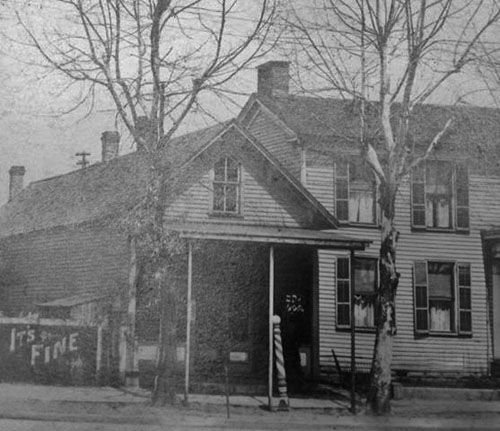
"One of the most sanitary shops in the state of Indiana," is how Harry D. Cotner put it as renovation of the interior of his shop neared completion. The shop on West Second Street included quite an investment. "We have spent every cent for materials and labor in Mt. Vernon in accordance with our policy of putting back our profits from our business into our business." The shop had four chairs and bath facilities. Walls and the ceiling were panted pastel shades, waiting chairs painted, the back bar varnished, and the barber chairs too. In the barber business since 1914, Harry would put in a "special cooling system" later that summer.
Snake Comes Back to Life....Causes Wreck in New Harmony.....1932
A four foot snake, a bunch of Rappite boys and girls and a car all piled up together in a wreck that fall. The teens were on a field study outing and encountered this snake. The boys beat the reptile to death and in the interest of science decided to take it triumphantly to the school for close inspection and perhaps dissection. So the dead snake was given the honor place in the vehicle and the hero and heroines headed for home. Everything was honky dory for a while then the snake resurrected itself and looked warlike and "assumed command of the car." Panic prevailed, kids screaming, the steering wheel was let go of, one boy was thrown partly through the car top, injuring his shoulder and the car smashed into a gate or something. Everybody got out alive including the snake that made his getaway.
~Wavy~ Finds Who's Who Presidential Poll of 1932 Interesting.....
Polls are interesting and most of them are quite accurate today in the time period they are taken. It has gotten to be a pretty precise tool. In 1932 a poll was conducted of all the people whose names appeared in Who's Who. Postcard ballots were sent out and in late September the results were announced. 28,000 cards were sent out and not even 10 % were returned...2,239 replies. Those balloted were politicians, writers, lawyers, engineers, educators, clergymen, scientists, physicians, military officers and artists. The totals: Herbert Hoover, Republican.....1646; Franklin D. Roosevelt, Democrat.....514; Norman Thomas, Socialist and pacifist.....69; Alfred Smith, Democrat....10; William Foster, Communist...0; and William Upshaw, Prohibition....0. Well, the general Election came and Roosevelt won 42 states to Hoover's 6.
Post Office Spy Slots.....1932
~Wavy~ was up at the post office mailing a book off to a satisfied customer and I started rapping with one of the federal employees about the spy slots close to the ceiling. Long ago, many people did not have checking accounts and paid bills by sending cash through the mails. Federal inspectors would show up unannounced and undetected, climb the hidden catwalk into a cork filled room and spy on their employees for theft. Leonard Brown tipped me off on this a few years ago as one of his relatives worked there over 60 years ago. May have even been the postmaster. I forget. The employee I talked to said she had been there way over a decade and had been up there only once. She said she was told a 45 revolver was also there at one time. I could tell by her demeanor that I wasn't gonna get a tour to the chamber or out the little door to the roof. I don't really want to see the draft board room again in the basement. ~Wavy~ is still trying to get over Miss Pettyjohn.
Nice Day For A Drive and Maybe a Little Sightseeing.....June 1931
Sunday marked a number of autos moving up and down the streets of New Harmony from Poseyville, Mt. Vernon, and Southern Illinois. Nice to have a bridge to bring over visitors so easily. They all took advantage of the good weather and machines of all sizes could be seen and the pall of dust from the gravel they frequented. A little Bonnie and Clyde music and a flask fills the picture for me.
Two Business Men Meet River Death.....June 1931
A motor boat containing five prominent men of Mt. Vernon capsized in the Ohio River and two lost their lives in the surging waters. William Bryant, 47, manager and owner of the Bryant Company and director of the Chamber of Commerce was one of them. The other was Harvey Breeze, 37, garage owner, and exalted ruler of the Elks Lodge. Other members who survived were attorney R.U. Barker, Edward Alles, owner and publisher of the Mt. Vernon Daily Democrat and Carl Clemens, employee of the Breeze garage. The five men were testing out a new motor boat when it struck a mud bar and capsized throwing the five men into the river. Those surviving clung to the wrecked boat and Mr. Bryant and Mr. Breeze both good swimmers started for the shore but didn't make it.
Carmi Hoe Found.....1931
William Hubele, resided a few miles northwest of Carmi and made an astonishing discovery while operating his sawmill, when the saw uncovered a hole with a foot and a half iron handle imbedded in a tree trunk a distance of eight inches. The tree had grown entirely around both hoe and handle. The hoe was hand forged and different in design from the present day hoe. It was in a fair state of preservation, although the sharpened point had rusted away. When the big saw struck the metal it dulled the saw points and blocked the machine. Hubele started looking and found the hoe. The tool was imbedded in the log at a distance of about 15 foot from the ground, before the tree was cut down, and how it came to be in the tree is a mystery, the only theory being offered was that some 50 years ago the hoe was leaned against a white oak sapling and that as the tree grew it enveloped the hoe carrying it upward to the 15 foot height.
B.O. Hanby Writes Books of Poems.....1931
B.O. by all accounts was quite a character. People would see him whizzing through town in his car, top down, beard flying over his shoulder in the wind. Son of a famous author, his father composed the anti-slavery song, "Darling Nellie Gray." It is easily found on U Tube. B.O. was a local historian and he traveled too in his jalopy to New York, Washington D.C. etc., reporting on what he had seen and who he had seen. He was a pioneer publisher in Posey County establishing "The Unafraid" in 1905 which was socialism in content. He later became more of a Republican due to the issue of slavery and that party's connection to ending it. At this time he completed a booklet called, "The Lovers' Gate," a collection of some of his poems and verses. Interesting man.
Saltzman Sells Store.....December 1930
Edward E. Saltzman, owner of the grocery store at Main and Second streets for five years, sold his business to C.P. Higginbotham, for over 20 years a merchant in Shawneetown, Illinois. Mr. Saltzman and his wife will spend the winter in Ohio.
Mulberry Street Bridge Built by L& N Opens To Traffic....July 10, 1931
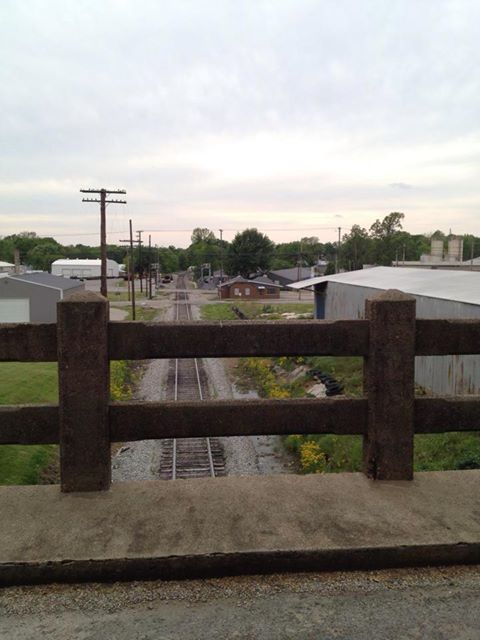
Putt putt anyone.....July 1930
In July 1930, C.C. Maurer and Charles Lawrence, two local young men, began construction of a miniature golf course on the site of the old interurban car barn on East Fourth Street. Opening was July 15th.
Memorial Tree Marker Arrives.....July 1930
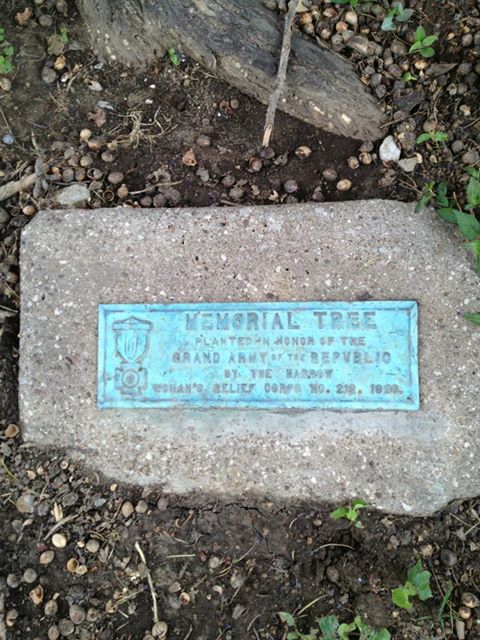
Early in the spring of 1930, the Harrow Relief Corps planted and dedicated on the high school grounds near Sixth Street a memorial tree for Union soldiers. The marker arrived in July made of bronze on a stone base.
Vernon Theatre Launches "Talkies".....January 1930
Installation of DeFarest sound equipment was completed and now the cinema house will have a talking movie picture. The owner, V.F. Grubb stated that the first one would be a Fox Production of backstage life in Hollywood. Doesn't sound all that appealing to me..how about you?
South Carolina Town Named After Mt. Vernon Man.....1930
So enthused were the citizens of Hamburg, S.C., just across the Savannah River from Augusta, Georgia with the work Charles Car did as a National Red Cross worker that they changed the name of their town to Carrsville. The son of Mr. and Mrs. S.C. Carr, he had been assigned to work in Hamburg, an all African-American town of about 100 residents. The river had been cutting into the little town and the Red Cross undertook to move the town one and a half miles back from the river. The population was so pleased with his work that the immediately changed their name...welcome Carrsville!
Worrying About Forgetting the Railroads Editorial.....1930
Mr. Wofe, editor of the New Harmony Times was lamenting the neglect of a great transportation source....the railway. "A century ago we bragged of the pork, the corn, the cattle, horses, oats and lard we sent out to southern markets and the settlers who came in. The arrival of fifty-four steamboats within fifty-five days are recorded in Vincennes and of flat boats nearing five hundred passing down in the same length of time. Ten new counties had been formed above Terre Haute, with a population of seventy thousand pioneers, men and women ancestors of a sturdy race. One hundred years ago folks the Wabash was a great inland artery along which poised the life blood of a nation; today it is anemic, a wreck, and intermittent sandbar, a tangled mass of weeds and willows through which a sluggish river creeps. One hundred years ago its bosom bore the incoming flood of settlers and carried out their produce to the marts of the world; today it is a drainage canal into which the creeks and ditches and cesspools of the north country drain. The neglect of the Wabash and the American waterways as a whole was the stupid crime of the nineteenth century. Ignoring the possibilities of the river, the people turned to the more rapid form of transportation and these natural highways were neglected until today it would exhaust the wealth of a nation to restore them. What the nineteenth century did twentieth is in a fair way to repeat. Turning to the truck, the railways are being neglected in favor of this new form of transportation which is carrying a prodigious amount of produce of a certain kind, taking from the railways a necessary earning that makes their existence possible. If this keeps on, the railways of the country will join the rivers in the graveyard of discarded things......a streak of rust on a right of way."
Heironimus and Miller Garage.....1930's
Located at 331 West Second it featured general automobile repairing and sold exide batteries and Kelly-Springfield tires. They had a towing service and only the best of mechanics on duty to repair all makes of cars.
Roast Pork by Electrocution.....1931
When a hired hand of Andrew Darnell of 121 South Barter Street left the barnyard in the rear of the Darnell home he knocked to the ground an electric wire running from the residence to the barn. Picking up the wire and escaping any shock because the wire was insulated, he wound it around a post near a watering trough. A short time later, Mrs. Darnell heard a pig squealing frantically, and rushing out found that the pigs had chewed insulation off the wire. One of the pigs was dead and the others were running around, "like mercury on a saucer." The 80 pound porker was electrocuted. Using an iron handle hatchet to rake the wire away from the pigs, Mrs. Darnell was severely shocked and the hatchet was tossed 20 feet away. Shazam!
Main Street.....1930's
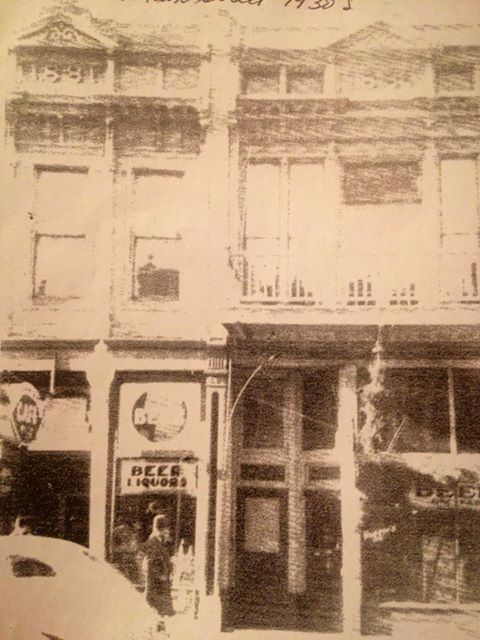
65 Year Old Blind Man Denied Marriage of 15 Year Old Girl.....1930
They all recognized that times were hard, but approval for a 65 year old blind man from Illinois and a 15 year old companion, also from Illinois was denied at the Posey Circuit Clerk's Office. They came in seeking a marriage license and "circumstances were deplorable" even as the mother of the girl was present to give her consent to the union. Clerk Lloyd Dixon's denial was passed on law. "A girl under 16 years of age cannot be licensed to wed under Indiana statutes even though her mother does consent to the union unless a court order directs the issue of the license."
Pistol Falls Out of Policeman's Holster and Shoots Victim.....1930
Thomas Brown, prominent Mt. Vernon resident was accidently shot when a pistol fell from the holster of Chief of Police, W.D. Lawrence as the two were at the home of Herman Johnson, seeking evidence that might determine the whereabouts of the accused slayer. Brown was taken to Deaconess Hospital and was said to continue to improve with no complications.
Henry Ford Uses Our Straw in his Hot Rod Lincolns.....1930
Come the New Year and the temperatures turned cold at the local Strawboard manufacturing plant on the west side of town. They continued operation through a weekend instead of suspending for Sunday as usual to avoid a freeze up during the extreme cold weather. A new contract was made with Ford where five carloads of product monthly was sent to Detroit to manufacture Triplex glass for Ford and Lincoln auto windshields. The strawboard is used as a cushion in the hydraulic pressure process of manufacturing the glass.
Old Booker T Washington Before Fire of 1933
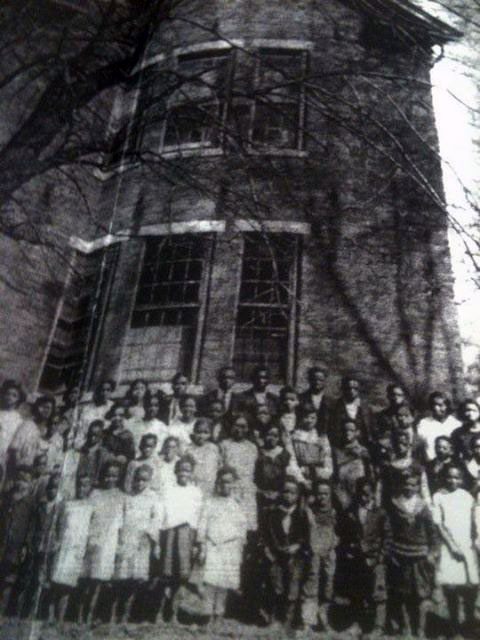
MVHS Canal Street Statistics.....1930's
The basement housed the vocational and prevocational departments consisting of laboratories for physics, chemistry and biology, sewing rooms, kitchen, agriculture and industrial arts and the heating plant. The home economics rooms were finished in ivory glazed brick and the other rooms in the basement in salt glazed brown brick. The first floor was a main lobby with terrazzo floors and stairways leading to the main corridors of the first and second floors. All corridors were terrazzo (exposed marble chips). There were six large classrooms and a study hall seating 125 and offices for the superintendent, principal, dean of girls, girl's restroom, two general offices and toilets. In the south wing of the first floor was the gym with a seating capacity of 1200. The floor was 46X80 feet. In the north wing was the auditorium with a seating capacity of 720. It had a equipped stage with a proscenium opening 17 x 30 feet. The balcony was reached by the second floor and contained a fireproof motion picture booth. The second floor contained 8 large class rooms and a study hall with capacity of 125. This floor also contained a teacher's rest room and toilets. An electric fire alarm system and class bells were operated by a master clock and the heating and ventilating were of the latest approved kinds. The roof was Johns Manville and the corridors contained individual ventilated steel lockers for the students. The gym contained showers and team rooms with private offices.
Defiance Tire Company in 1930's Became Lutterman's Market....
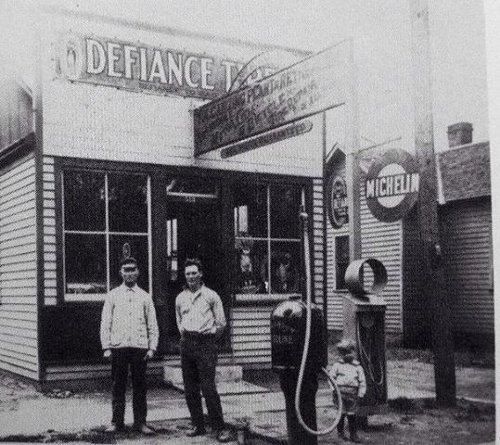
Additions were added at the Defiance Company, owned by the Walker family who sold the building to Edward Lutterman.
1920's
Whitmore Handle Factory Moves to New Location.....Spring, 1920
Building started on the new factory of the Whitmore Handle Company in May situated on the site of the old canning factory on the Lower New Harmony road and the L&N railroad and will enable the management to double their capacity as well as have better shipping facilities. The present factory building on East Tenth Street will be moved and used as a warehouse for the finished product. This building measures 32X60 feet. The new factory will measure 42X84 feet and will be more than twice the size as the old. An engine room and dry kiln measuring 12X24 feet and a building 36X50 feet are to be used for storing the raw material are also to be constructed. The management was President N.N. Williams, VP Horace Smith, and Secretary Treasurer William Ruminer. The old factory is running at full capacity and has been unable to fill all present orders. The new facility will enable them to fill orders more promptly and if needed to expand to meet increased needs.
Major Builder of MV Buildings, Jake Behrick Dies.....September 1929
Jake Behrick, 62, senior member of a contracting firm of Jake Behrick & Son, ex city councilman, democratic political leader, civic worker passed on at his home at 215 West Eighth Street. He had been in bad health for over a year and had been visiting several different spas for a nervous disorder produced by a lesion on the brain. Early in life he learned the carpenter's trade under his father. Forty years he had been engaged in building in Mt. Vernon, Southern Indiana, and Illinois. Among his major projects were the Memorial coliseum, the new High School (Canal Street), Elk's Home, Eagles Home, Masonic Temple, Short Funeral Home, Keck Garage, and the James Whitcomb Riley School. He also for a time managed the Industrial Brick Company in town. Interment was at Bellefontaine cemetery.
Large Showcase Is Addition to Museum.....August 1929
The Posey County Historical Society has added to the equipment of the museum room in the coliseum, a large show case, 23 feet in length.
Weilbrenner Adds Meat Market.....1929
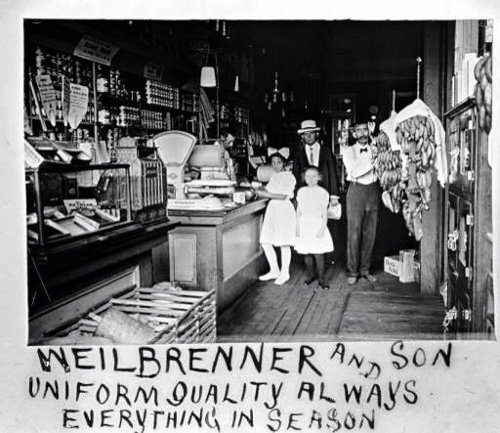
In June of 1929 an arrangement was made with the removal of the Henry Knight meat market on West Fourth Street to the Weilbrenner store. Mr. Knight would continue to run the meat market within the Weilbrenner store as a separate section. A full line of fresh and cured meats would be handled along with delivery service. Remember he is right there on Main between the two filling stations, Standard Oil and Hawkeye. Come on down....they give trading stamps also, plus meat and groceries may be ordered at the same time for delivery under the same credit arrangements as before...good people Weilbrenner...come get u sum! "Our customers will be benefited by the prompt and pleasing service and now we have two phones 153 and 163....call today ma'am."
Plane Lands in Farmer's Field....Damages Wheat.....June 1929
A plane bearing the identification "C-89, Missouri and Pacific Lines," on the wings landed in the wheat field of Arthur Topper and Will Redman in Western Black Township, then ran the length of two football fields an took to the air, before the farmers could reach it. I bet they had a few choice words for the pilot! The wheat was bent to the ground in both fields and was a considerable loss. Is there insurance for such an occasion?
MVHS Dedicated on Washington's Birthday...February 22, 1929
One of the largest indoor audiences ever assembled in Mt. Vernon to that time came to view the $200,000 high school. A crowd estimated at 2,500 witnessed the simple patriotic ceremony. Dr. Henry Noble Sherwood of the University of Louisville defined it, "The American school house is the paramount building in the United States and its task of building citizenship, the nation's greatest problem." State Superintendent Roy Wiseheart, was on hand devoting his address to the discussion of problems of most school administrations, dwelling on the proper housing of pupils in the new age. We had music by the school orchestra, the high school chorus, the audience sang, "America," a few more speeches including one from Mayor Samuel J. Miller, a presentation of gifts to the school from clubs and sorority's, more music and then the benediction.
1929 Posey County Historical Society Says Abe Lincoln Gave Speech at Grafton Bridge
I would like to see this proof, but B.O. Hanby said a paper prepared by a J.F. Davis proved that Lincoln did in fact speak nearby, but no date or details were forthcoming. Maybe I'll find it in this big stack of papers I am going through. I hate reading of relics once given to the society that we no longer have. You see years ago we had a good start to fill a museum of Posey County items. Gifts of the past year like a portrait of Judge Edson, photographs of the toll gate markers of the Old Plank Road. There were annual reports from George Washington's Mt. Vernon that were shipped to our Mt. Vernon ever since 1909. There was an interesting will listed that bequeath some property to his Indian wife in Mt. Vernon. All these items and many more disappeared when the Coliseum was broken into during the 1930's.
Something Called a "Ornithologist" Goes Looking for Water Turkeys in Hovey Lake.....1929
~Wavy~, he don't know the ways of the woods. I love going listening to what I would call the whip-poor-wills and I like watching birds on the lakes and enjoy walks through trails stomping on yellow leaves. I usually do this in places like Harmony State Park or Audubon Park. Nobody with guns there to mistake me for....well a turkey. I don't grow any "plants" anymore, but those who do may have booby traps about and you never know when you might run up on a meth lab. Getting back my story here this "Ornithologist" fellow, a Mr. Samuel Perkins from the State, along with several assistants (pencil pushers) and Mr. Hanby took off spending a part of a week studying the "water turkey," of which claims there were a number in the lake. This turkey was about the size of a common turkey and was proportioned about the same. "It is not known whether it is a destructive bird or whether the fowl can be used for food," said the Ornithologist man. The state representative and the gang waded into the lake checking the species from early morning until roosting time at night that July of 1929. I guess they met with success as the party went out several different times that month and found the bird perched in cypress trees and swimming. They said they saw as many as forty in a single place. They wanted to find them nesting but were unsuccessful. They wanted to see the nests. They found a old one lined with feathers of gulls. Lots of things out there in Hovey it seems. They talked about "prothonotary warblers" and rare wood ducks. You ever notice how complicated the names of plants and wildlife are? They went to Half Moon Pond (that thar is good name), but found no turkeys; but there was some "cormorants" perched on the north side. They were surprised by that. ~Wavy~ would know a cormorant if I fell over one. Lots of Cardinals on the fence posts I imagine, but no Cubs were found. Mocking birds were plentiful, but none were heard. Weird. "Chuck-will's Widow" was heard. Leonard Brown, you are a bird watcher; what the hell is that? They stalked a pair of barred owls and were harassed by a number of crows. We have them in town....no need to go to the country for them. Mr. Perkins was so impressed with our lake and woods that he planned another safari into the wilds in August. Hanby just complained about the "skeeters."
Pharmacist Fogas Dies.....1929
William Fogas and his drugstore at the corner of Second and Main were well known. Many of the old postcards of Main Street show the Fogas name on the side of the pharmacy. William Henry Fogas was born in Mt. Vernon in 1862, the son of a German immigrant. His father came to Mt. Vernon in 1861 and established the first cigar factory known at that time. He conducted that business until 1904 when he died and the business went over to William Frier. William here was a Republican, graduated from MVHS in 1878, and Pharmacy School in St. Louis in 1884. He came back to Mt. Vernon and worked for Joseph Gardiner, druggist until he passed on. He had one daughter...Alice.
Owen Dunn Post Drums On Display.....1929
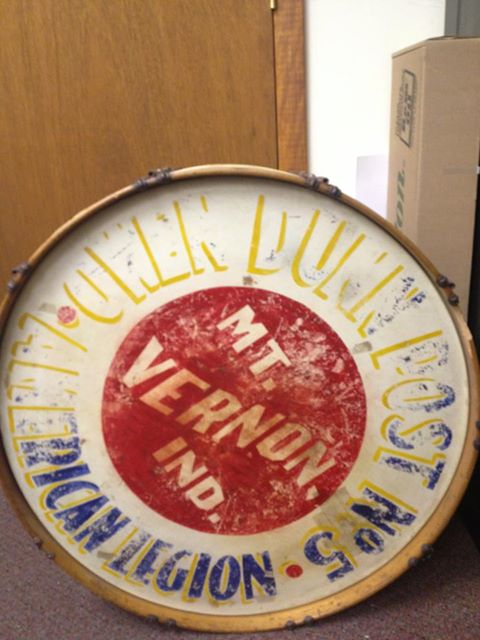
The newly organized post drum corps displayed in the show window of the Rosenbaum Brothers Department store, 24 drums which were a product of Indianapolis. Each was stamped with the American Legion seal. This drum was recently found in an auction in another state, purchased and brought home.
Historic Show Case On Display by Historical Society.....1929
One of the largest movable show cases in Mt. Vernon was donated to the Posey County Historical Society that was owned by George Henrich which he purchased in 1850 and used it in his barber shop at 215 Main Street.
Washington No Longer On Two Pieces of Currency...MV Reacts to New Money.....1929
Before July 1, 1929 there was eleven different denominations made in 39 designs! Washington for instance was on the dollar bill and the twenty. Counterfeiters would change the numbers and the public sometimes got confused. Uncle Sam also reduced the size of the bills to save printing costs and to make them more convenient to handle. Now Mt. Vernonites could put money in an envelope without folding them, something which the old bills would not do. Locals liked how more money would fit in the palm of your hand for counting and did not take up so much room in their billfolds. So, all you Hoosiers memorize all the portraits on the new bills so you will not be shortchanged.
Look What's Happin' Out In the Streets".....1929
John "Judge" Hermann, local garage man and Pontiac/Oakland distributor became a patient of Deaconess Hospital, suffering from a fracture of the skull when he was thrown to the street from the running board of an auto on East Fifth Street and Walnut. John you see was riding on the running board of a Ford coupe of Miss Bess Geissler, Griffin school teacher. Somehow I get the feeling this was a good looking school marm. Passengers in the car were Miss Kemp, another school teacher and a Griffin High School student. It seems to have been fairly common for people to hop on the running board back in the day, maybe that's why they call them running boards. Heck, I don't know...I only saw them when Capone was shooting up Chicago and gangsters were riding shotgun in the movies. The trio of Misses had arraigned for storage of the auto at the garage and Herman was in route to MVHS which was the scene of the Posey County Basketball Tourney. Dr. Doerr rushed brother John to the hospital where a xray showed the fracture of the skull at the base of the ear. Reports later said he was improving nicely and "taking nourishment." By the way, the Griffin Tornadoes defeated the Stewartsville club 30-24 in the championship game. The Wildcats were "smoked" by the Poseyville Posies 30-16. You would think a team with starters with last names of Aud, Ashworth, Bishop, Abell, and Schafer would be belter than that ....wouldn't you?
Train Car Derails and Burns.....September 1928
A wreck estimated at worth over $100,000 occurred on the L&N tracks at the trestle, spanning Big Creek, between Welborn Switch and Upton Station. It was thought that one of the cars derailed near the trestle and when it passed over it caught the ties and caused the wreck. The engine and the greater portion of the train had crossed the trestle before the wreck occurred. Seven cars were carried into the ravine fifteen feet below and were piled in a twisted mass of steel. A tank of 1000 gallons of gasoline went over and immediately caught fire blazing and raging 40 feet high. Railroad people warned everyone to stay away as of the probable chance of an explosion. It was thought the fire would burn ten to twelve hours and could be contained within the ravine.
Blowing Up Stump, Local Gets Powder Burns.....May, 1928
Harold Brown, son of L.C. Brown of the post office, suffered wounds to his face and eyes caused by a powder blast. Shortly after dinner, Harold attempted to blow up a stump in the yard on College Avenue. He put the powder in the hollow of the stump and then dropped a lighted match on it. Not getting away quickly enough the blaze burst up into his face and blinded him. He was taken to an eye specialist and the injury was deemed quite serious and may result in defective vision.
New School.....April, 1928
On April 18, 1928 ground was broken for Mt. Vernon's new High School building on the corner of Canal and Sixth streets. A plow drawn by the members of the 1928 graduating class turned the first dirt towards the erection of a new building.
"The Public" Newspaper Suffers Fire Loss.....February 1928
Editor B.O. Hanby offered appreciation to the Cynthiana Argus and the Mt. Vernon Daily Democrat for assistance in getting his paper out. He called it, "Competitive Courtesy." Flames originated from a defective gas line extending from a tank to the burner of a linotype machine, swept the Public, newspaper and job printing office on North Main Street burning the interior of the south half of the frame building, Several fonts were melted, office furniture destroyed, and machinery damaged. The only insurance was for the linotype machine. Mr. Hanby stated he intended to rebuild and hoped, "The Public" would continue without interruption. Hanby said that the Editor's Grief is one of trying situations with many objectionable features that the general public does not realize. "A country editor always tries to get the paper out on time and free of mistakes. Just think of the job of looking at every word in a newspaper and see that it is correct and at the same time be obliged to always having it printed and distributed on time. Then think of the annoyance of having all kinds of interruptions whereas machinery difficulties that can go wrong. Ads are submitted in a timely matter for sales, etc., and I must deliver. Anyways, there is always some matter that happens to delay the work of going to press. Now it is not every day we have a 'hot time' in the press room like yesterday; but if not for skilled management the entire building would have burned."
Keck Motor Company.....1928
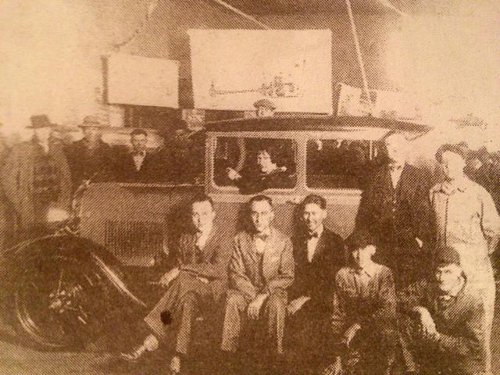
At one time it was the oldest car dealership in Indiana.
The Main Street School, Its Beginning and Its Ending.....1928
B.O. Hanby, publisher of "The Public" wrote an article in his Christmas issue of 1928 about the old Main Street School that sat on North Main, later becoming the home of the Overhall and Exylin raincoat factory. Back in 1833 that land belonged to John Burlison, being part of a tract of 25 acres sold to him by Samuel James on May30, 1812. On September 27, 1833, Mr. Burlison sold 4 acres of this land for the use and benefit of the Board of Trustees of the Posey County Seminary. The sale was made to George Green, Auditor, for $200. The land later was sold to the school trustees who at that time were Joseph Welborn, Simon Pearse, and John Pfeffr. That sale took place in 1874. At this time period the Seminary building was torn down and the Main Street building constructed in 1884. Now back in 1928 one person still alive who attended the old Seminary school was still alive...his name was Mat Nelson, who graduated from the institution at age 18. The Seminary use to charge $1.50 per month and those attended were of the age between 10 and 25. The course of study was about the requirement of being a freshman year in high school. Mr. Nelson talked of an old classmate by the name of Miles Wilsey and he seemed to be quite the character. Wilsey became smitten by a young lady, who was the daughter of an aristocratic family in town. Now Miles in that time was considered a pretty handsome country lad, but he had "big feet incased in large rough shoes." The girl was Emille Sullivan. Miles he told her..."You are my girl." Her reply was to spit on is shoes! That was hint enough for Wilsey. Heart broken, Emile married an Evansville man and Miles.... he sort of disappeared, never to be known from again it seems. Well, on that sad note, the new school on Canal Street was completed and early in 1929 the merry voices of children would be heard elsewhere.
Smelting Cupola Arrives at Staples.....1928
A smelting cupola was installed for the John Staples Foundry on West Second Street. A new edition 35 feet by 85 feet has been added and they expect to melt two tons an hour with the installation of the cupola. From what ~Wavy~ understand a cupola of this sort is a shell lined by refracting brick. I was just learning about smelt fishing....now this. This dog is too old to learn new tricks!
Boat Parade.....1928
Now this sounds a little different. It was Labor Day and Mt. Vernon scheduled this boat parade. I bet that was sort of cool. MVHS Principal G.S. Rust introduced water basketball at the riverfront. That's sounds like a winner. Lifeguards? Later between homemade ice cream and homemade jellies we had boat racing between Henderson Ky., and Evansville. No results were given in the sports page; but Ruth goes over 50 homeruns again in New York. Damn Yankees!
Western Union Clocks Installed in Mt. Vernon.....1928
Western Union clocks were installed in Mt. Vernon through the efforts of C.J. Heath of Chicago, Western Union representative. I don't know the precise locations. I do remember a clock in my youth on Main between Third and Fourth Streets. Not sure that is one of them. The article said that the telegraph company put the clock in place and takes care of it and that the hands are "regulated hourly on the basis of official time from the naval observatory at Washington." Heath said, "When the world was very young, time meant little. There were no trains to catch and no business meetings to meet, but now....well it's a different story."
Councilman Injured at Black's Grove...1928
Councilman Guy Green, of the second ward and local weather and river observer was knocked unconscious while moving logs at Black's Grove. A heavy cable on one end of which was fastened a pulley dealt the blow which resulted in the injury. The cable had been bent in pulling logs out of the creek and Green and other workmen with the assistance of a team of horses were endeavoring to straighten it and in some manner the cable which was wound around a tree, slipped and the pulley end flew around the tree striking Green in the back. He will recover, but if it had struck him in the head, death would have been instant.
Tragedy When Carriage and Auto Meet in the Dark.....1928
Mrs. Karl Winiger, 32, was instantly killed and her three year old son, Paul William, was seriously injured, Sunday morning at 12:30 o'clock when an auto driven by a Evansville man struck a horse drawn surrey in which the family was riding. The family, father, mother and three children were returning from Mt. Vernon to their home near Caborn, when the accident occurred on the concrete Evansville-Mt. Vernon highway, three and one-half miles east of Mt. Vernon. They had no light on the surrey. The auto driver and two female companions were returning to Evansville at the time of the crash and were unable to see the rig until it was directly in front of his vehicle. Another automobile driven by Buell Utley was approaching from the opposite direction and it is believed that the lights from Utley's machine also hampered visibility. The surrey was hurled 20 feet from the road, the force of the impact removing the horse from the vehicle. Mrs. Winiger and the children were occupying the back seat. Mrs. Winiger was not thrown out of the surrey and was struck by the auto. The baby received concussions about the head. All other occupants were only bruised. After striking the surrey, the car swerved across the highway and was struck by the Utley car. In the Utley car were the driver, Manfred Stein, Miss Katherine Jeffries and Miss Mary Lucile Causey. Jeffries suffered a cut on the hand from broken glass. Funeral was in the Caborn church cemetery.
Mt. Vernon Creamery as it looked in 1926.
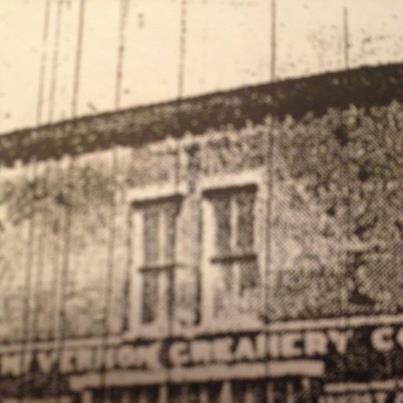
Of course, I have written before of the creamery that was founded by Holder Anderson who came from Denmark. He came to Mt. Vernon in 1926 and purchased this building at 214 College Avenue from Edgar Thomas. Later his two sons Jack and Bob took over. Ice cream mix was purchased already made, ready to freeze, and when it reached the creamery it was only necessary to add the coloring, flavor, fruits or nuts whatever the case may have been. The mix was placed in the freezer where it was tested to have at least 10 percent fat which was required by law. They also made pasteurized Grade A milk, butter, cottage cheese and various ice cream confections such as caramel cold krunch, snappy pacs, special bricks and individual molds.
"The Lucky Eleven Club" Has Me Stumped.....1920's?
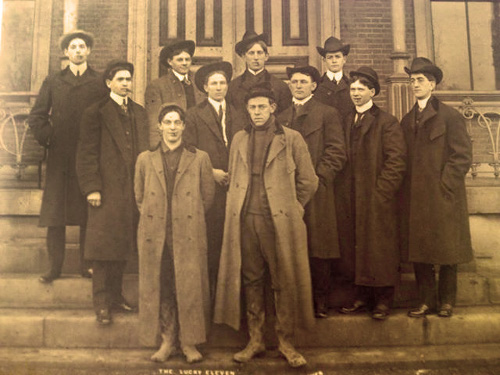
Maybe a cigar club? Three got stogies. What would they have in common? This may be even before the 20's. Those are some pretty starched high collars. Quite a difference in social status it seems from the back 9 to the front 2. I thought of politicians and custodians but they all seem relatively young. Maybe if I look in a few biographies of the names I know I will gain a clue. So much to do and so little time.
Vistors.....1926
In 1926, future owner of the Cincinnati Reds, Sidney Weil visited his uncle Ike Wolf on East Third Street in Mt. Vernon and three years later, Sidney's mother, Minnie came to visit her brother-in-law.
Weisinger's Funeral Home.....1926
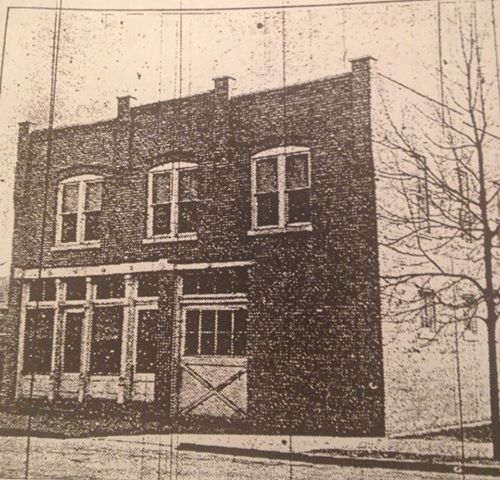
Established on West Fourth Street in 1866 by the late Henry Weisinger. This building replaced an earlier building on the same site. This one now Funk's Carpet was a two story concrete structure with furnished offices on the first floor and on the second floor four show rooms, preparation room and a suite of rooms used for services and comfort of relatives. A.V. and his son Merle Weisinger took over the business in 1904.
That "Butch" Dieterle Can Fly!.....November 1925
Gong!! .....and driver William Dieterle is off. A pocket watch held by a Western Star reporter in the presence of City Clerk Dixon at the City Building saw "Butch" hang up the receiver on the telephone and disappear from sight on West Sixth Street after just ONE minute had elapsed. Dieterle took off in the big red fire truck without any sign of excitement. An employee of the city for many years, both in handling the horse driven apparatus and the motor car. He drives great and is said to be a good mechanic. The truck started without a misfire and he clearly showed that he is a man the whole town can depend on in case of fire. The statement that Mr. Dieterle skedaddled up the street in less than two minutes was verified by Mayor Osborn, Clerk Dixon, a representative of the Star and Chief of Police Moses who rode in the back-end of the truck. "Immediately following the alarm of fire the gauge stationed in the city clerk's office, showing the water power at the pump station, began to function and within a few seconds the hands on the gauge began to show the upward climb of the pressure."
Grammar School Student Burned by "Spit Devils".....1925
Back in the 1920's boys would hide behind a hedge and watch little girls jump rope then walk by and throw down a "spit devil" or a "black cat." There would be a sudden ear splitting pop and the boy would take off running laughing as the girls would say, "I'm gonna tell your parents!" A spit devil was a small wad of explosive powder wrapped in red crepe paper. It would explode on contact with a hard surface. This Charles Johnson lad was severely burned while playing during recess at the Grammar school when he fell on the ground with a pocketful of spit devils. The fall set off all his fireworks in his pants and he was burned badly on his legs and his hands. Dr. Doerr attended to the young man.
Coliseum Done....Now Let's Get a Good Road to Evansville.....1925
1925 was starting out fine. With water mains added to the Strawboard factory and during the administration of Democratic Mayor Osborne we got our beautiful coliseum. The Chamber of Commerce worked hard for this project pulling strings to bring together Posey County financiers to go to Indy to appear before the Governor and the State Tax Board. Oh yes, our tax dollars at work doing redistributions for the benefit of its populace. Building infrastructures....investing in America. What happened to that spirit? The town went on looking to place a "hard surfaced' road between Mt. Vernon and the big city of E'Ville. Chamber of Commerce again held meetings and met with State Highway Commissions...being good public servants. Yes, the result would be gratifying as the road was put into the next year's road program. There was an agreement of the need and finances were found. The town seemed to be in good cheer with the annual Chautauqua providing entertainment, more lighting around the Public Square and Second Street. We had a Merchant's Trade Day netting money for the Chambers of Commerce several hundred dollars. A community looking forward.
Old 1920's postcard of Dietz Grocery & nearby barbershop at 229 West Second Street
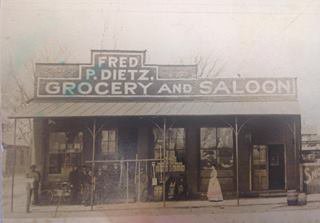
1925
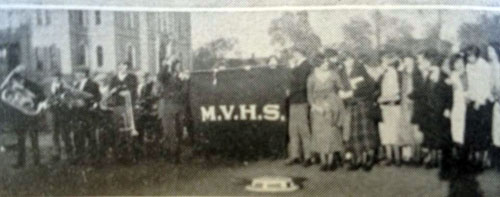
Must have been one of those old fashion snake dances. Too early for student demonstrations.
MVHS.....1925
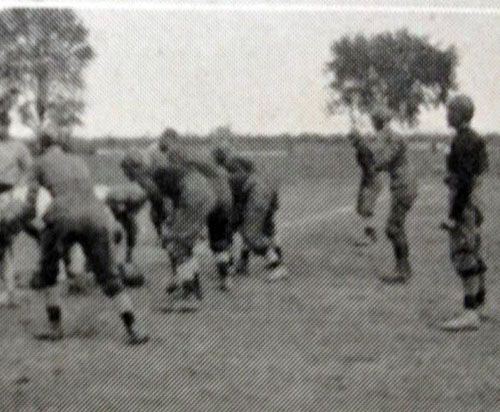
Back in those days we even had a town team that would play other cities like we did for a century in baseball and for many years in basketball. I hesitate to call it "semi-pro." There were Alumni games often too. The high school played day games, usually on Saturday afternoons. Usually there was a game on Thanksgiving Day. I had an uncle who played on the 1930 team that didn't score a point the entire season! We had one year back then that the only game they won was a forfeit. Of course in 1908 we had a undefeated team...even beat Evansville High School...(Central). They only had one high school then. Hahaha
Cruising 1924
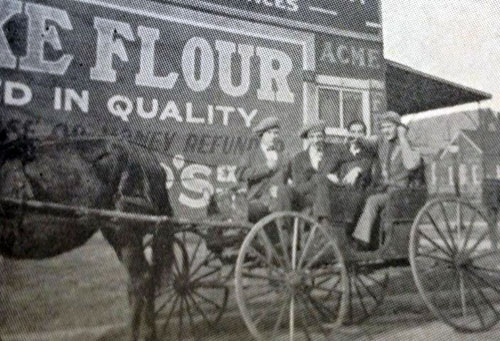
A flivver and a flapper?....1924 Good looking girls and cars always work well together
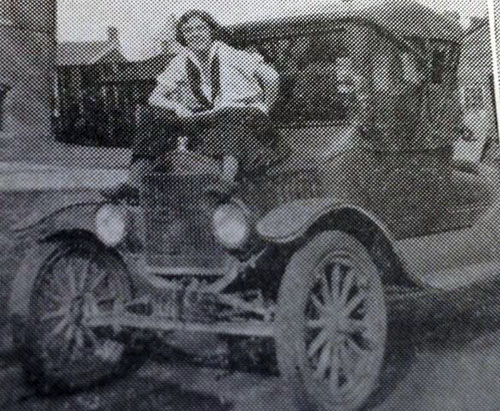
Not sure who the young lady is, but her outfit looks like one of the girls' basketball squad that were the best in the area in the 1920's. They wore "bloomers" early on, but became one of the earliest teams in the state to switch to shorts. First however they had to model their shorts in front of school officials and parents to see if they were acceptable. I interviewed some of these ladies 30 years ago like Irma Dieterle, Lorraine Zimmerman, and "Never Miss Sally" McGregor who is a forgotten legend who averaged more points a game than the opposition in 1926 including 56 against Memorial. During her last two years of high school the "Champs" went 36-1!
Distinguished Service Medal Awarded to Local Soldier.....1923
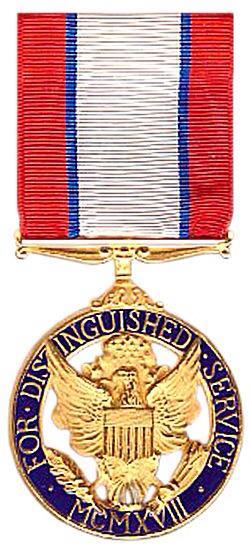
The Distinguished Service Medal was awarded to Major Arthur Houts of Mt. Vernon posthumously who was killed in the Argonne Forest in France on September 28, 1913. The award was started after the First World War and around 2000 were issued during that time....mostly to officers.
God says No on Halloween Parade....So they say.....1922
The street dance that was to be given on Main Street and a parade Halloween Night was cancelled, owing to the protest of the Mt. Vernon Ministerial Association that it would be "conductive to immorality." The local Posey County Band was disappointed as were the young people. Meanwhile, a barrel of mash and other equipment for the manufacture of "white mule" was located on a farm in the Black river bottoms north of Stewartsville. Not wanting this to corrupt even more people into "immorality", Sheriff McFadden sent two deputies to destroy the "monster mash." I guess it was okay to dance after Halloween as one was held by members of the Battery E National Guard in a barn on the E.B. Schenk residence on South Walnut Street. No mention of any mash.
Thieves Break Into Rosenbaum & Bro. Store.....November 1921
During the early morning hours thieves broke a front basement window. The entry was found by the janitor Matt Inglehart when he arrived and reported it to the police. Only the gentleman's department of the store was entered. The thieves were evidently choosy as they took the very best and completely outfitted themselves. They even took two suitcases to carry the loot they were unable to wear. They made their exit through a rear door. It looks like they took three suits of clothes, two overcoats, two suit cases, about twenty silk shirts, sizes 14 1/2 and 14, one hat size 7 1/4, three hats size 7 1/8, two sets of cuff buttons and the pins, a box of handkerchiefs and several ties. Left behind were pulled out drawers, empty boxes, and a uneaten piece of Tango chocolate candy. Two suspects were found wearing the clothing and arrested at the L&N railroad yard.
Independence Day at Black's Grove....July 4, 1921
2,000 people spent the day in the shade of the big trees, enjoying lemonade, sweet tea, fine breezes, a band concert and a baseball game between Farmersville and Stewartsville. There was also a political speech "Americanizing America" by Rev. Ewert of Chicago.
City Council Ordinance....Trim Your Trees!.....April 1921
A resolution for the opening of Maple Street between Third and Fourth Streets was passed along with a resolution requiring owners to trim their shade trees along the roads as not to cause any obstruction to electric light and telephone companies. They seem to be bitching about having the expense to continually having to raise their wires. Residents weren't too happy about it either it seems. Other city council news included a formal opening to Sherburne Park with a concert and oiling the Main Street with more freshly oiled macadam. One more thing...the old large two story, six room school house with the large basement on Pearl Street between Fourth and Fifth Streets was sold at public auction in several parcels. All four parcels sold at a cost of $2800 and were bought by the only two bidders: John Keck and Charles Hagemann.
"How do you think he does it? What makes him so good?".....1921
In Poseyville, a trick bicycle rider gave an exhibition on the street Saturday morning and was top notch. Standing on his head on the seat of the wheel, crawling through the frame, take the bike apart while in motion and many other wonderful performances constituted his program, all the while giving a rapid chatter. His limited audience threw down some change for the performance.
Harry Cotner's Barber Shop on West Second .....1921
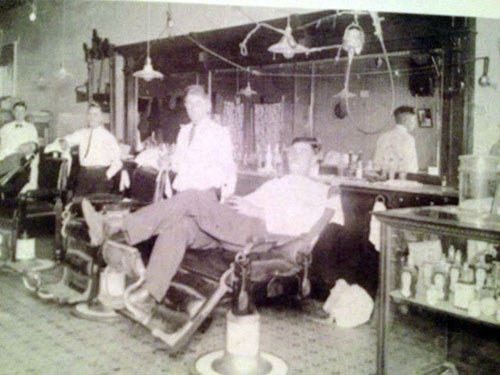
Town Looks for Property to Bury Dead Animals.....April 1920
The triangular piece of ground north of the L&N railroad tracks off Main Street was being looked into as a suitable place to bury dead animals. Arraignments of purchase were being discussed with the owner, an A. Waller of Henderson, Kentucky. City councilmen want to obtain this property, then condemn it, finally convert it to public use. Have not been able to verify if it happened or another place obtained. I sure would like to see this place cleaned up however in my lifetime.
The MV Excursion ship and barge I. N. Flesher...1920
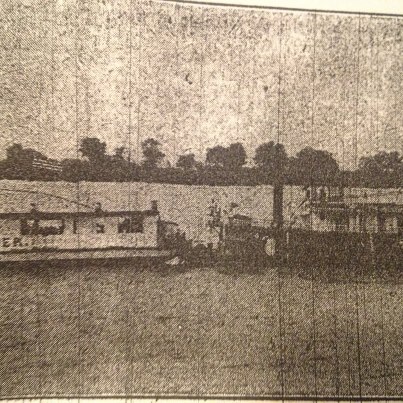
For fifty cents or so you could take a midnight cruise on the Flesher towboat and the barge, "Belle V. Flesher." Isaac Flesher and his wife Belle owned the boats that were used to move cargo during the week but could be leased out for outings for lodges, churches as well as other gatherings.
1910's
Store Street Becomes College and a Piece of Cake.....March 1919
The story of the name change has been told many times, but I will try to enlighten those who may have missed it. In the spring of 1919, Mrs. Annie Larkin and Mrs. Charles Hempfling introduced a motion of changing the name of Store Street. The contention was that a home occupied by Larkin had once been a private girl's school and that the name of the street should be changed to commemorate that fact. A debate followed saying that it was a business street, at least on the south end of it and should not be changed. The city council called a meeting to decide the matter and the session was at the City Hall with Mayor George Zimmerman presiding. William Holton, a banker led the charge for the name change and Edward Alles as well as B.O. Hanby, publisher and representing the Posey County Historical Society opposed it. An affirmative vote was taken and soon a little boy appeared with a large cake baked by Mrs. Larkin, who not only raised the proposition, was also known as a A1 cake maker. A document was attached to the cake saying it was a will that the cake be assigned to the council. Hanby objected saying he should be made administrator of the cake property. After hearty laughs, Zimmerman appeased the eccentric writer with the first piece. Hanby as well as others carefully wrapped his piece of cake and took it.18years passed and one day Hanby came upon a neat little box, carefully wrapped and lifting the lid he discovered another tin box and in it tissue paper was that piece of Mrs. Larkin's cake baked with home grown Dictator flour. During the debate Holton had remarked: "There is sort of a college up there where 'Squire Larkin lives, and our magnificent high school is located on this same Store Street. Therefore, I hold and so declare that College Avenue is the right and very appropriate name for that public thoroughfare." Hanby had said: "The proposed name change is something akin to sacrilege. The street was named by the venerated founders of our fair and flourishing city over 100 years ago. Solid, substantial, industrious, patriotic, thinking men whose names shall be heard when the timbrels of time shall no more be heard by us mortals here assembled and old Mother Earth is shriveling up with disgust at what is going on among those who tread her parched and decomposed surface!"....Hooray! went the crowd. Hanby, the old blowhard still had more wind...."and here comes an upstart and motley generation, tangoing, fox trotting, pussyfooting to God knows where, with no reverence for their sacred institutions as founded by their departed forefathers, and what do they want? I'll tell you what they want. They want to turn this proud, respected old town upside down and dance on its inverted respectability and cherished memories.......Hooray! Said the visitors....Hooray!....."They want to change the name of our venerable and historical Store Street because as they tell us, there is no store on Store Street. Neither are there any mulberries on Mulberry Street, nor pearls on Pearl Street, Abraham Lincoln never saw our Lincoln Street, and if he did he'd probably have taken our town off the map." Sit down old man!..."And my friends, no canal ever ran through Canal Street, and, in conclusion I am forced to exclaim with the immortal Patrick Henry....Give me liberty or give me death." "Hurray for the editor, hurray." "More power to him." Well, my friends that is the story of how tradition was stolen by carpet baggers and progressives
Local Airplane News.....1919-1920
On a Saturday in early November 1919, Wrigley planes Spearmint No. 1 and Spearmint No. 2 landed in the Hagemann field in the western part of Mt. Vernon and hundreds of our citizens spent Sunday afternoon examining the planes. When the planes arrived over our city they dropped 25 small parachutes, each carrying a package of Wrigley gum and four of them contained complimentary tickets giving the finder a free ride in one of the planes. Others desiring to take a ride were charged $15 each. The planes were used for advertising to keep his product before the people. Wrigley's planes were of the latest type of the Curtiss airplanes, similar to those used by the United States Army. In December another plane visited us a "Skylard," owned by the Rainbow Aviation Company of Crawfordsville. They landed at Hagemann's field on West Second Street and gave exhibition rides over the city. The plane is making its way southward flying people on short trips for $15 per flight. Also we had the famous NC-4 plane pass over the city. It was announced by the siren at the water works plant as the approach of the gigantic seaplane came by. Our town folks flocked to the riverfront as the plane flew as low as she followed the river that those not on the bank were unable to see this famous plane. The NC-4 was on a recruiting tour and was making flights all over America including Evansville. Afterwards she was to be retired and permanently stored at the Smithsonian Institute for all generations to see the pioneer of trans-Atlantic air passage. She was evolved to hunt down and destroy U boats. This was the first airplane to cross the Atlantic Ocean as she passed Mt. Vernon was in charge of the same crew that made that memorable trip, including "Mickey Finn," the bulldog mascot who was also aboard the ship. Mickey wears a full navy uniform and three service stripes indicating that he was enlisted as part of the Navy 18 months ago.
Deutsch Verboten.....1918
A so called patriot from Evansville found fault with a few German sentences in the local Western Star newspaper. The letter sent from E'ville and not signed said, "If you don't take it out of your paper you might find out something that you never saw before. If you think James Killroy keep yours printing shop up alone then just keep going." The message was muddled, but the editor got his point. Old man Leffel responded, "For the benefit of the writer, who is too cowardly to sign his name, we wish to publicly say that if the Star cannot exist without the support of such Kaiserites as he represents, we will most cheerfully close up our shop and ascertain the name of the crank, and make it our business to send him where he belongs...to the faderland."
Aren't Busses Suppose to Stop at All RR Crossings? Maybe not in.....1918
Thirteen of fifteen passengers of an "autobus" traveling between Mt. Vernon and New Harmony were injured when it was struck by a freight train at the Solitude crossing.
Soldiers' Mail.....1918
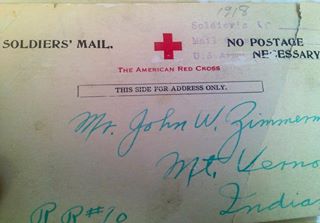
Let's tie this in with the Zimmerman family. The mail above was from Carl Zimmerman the son of John W. Zimmerman of Mt. Vernon. Now the Zimmerman's have a long proud history in our community so I want to go back to the earliest Mt. Vernonite. His name was John Zimmerman Sr. and he came from Darmstadt Germany. In the great Mt. Vernon fire of 1880 on Main Street he lost his boot and shoe store to the flames. He came to Mt. Vernon in the 1850's after living a short time in Baltimore. John Jr. was a blacksmith and he built a new home at 201 West Eighth Street in the 1890's. It was there in that home in the early 1980's I interviewed two of his granddaughters Elsie and Lorraine Zimmerman, former school teachers of mine and also basketball players in the 1920's for MVHS. In that home, which still stands, was a large Civil War sword hanging on a holder on the wall. In a book case hang a painting of an Indian chief and stacks of books were on the shelves. On a bottom shelf were Indian relics owned by Thomas Zimmerman. A pair of heavy wooden shoes worn in pioneer days and other antiques were nearby. In the cellar was said to be an old fashioned metal contraption for making home-made candles. Now getting back to the card from WWI from Carl Zimmerman we learn that Carl survived the war serving ten months in France. He had quite a career as an educator, graduating from Indiana University, teaching in Posey County, South Dakota, then New Albany, Indiana. He was principal at New Albany Jr. High, then principal at Logansport High School. After five years as principal, he then became Superintendent of Logansport public schools. He retired in 1966 and died in 1977. Of course he was the brother of my two elementary teachers at Hedges Central...Elsie and Lorraine. Another son of John Zimmerman ...George F. was once Mayor of Mt. Vernon from 1918-1922. He was a city attorney from 1894-1907. A graduate of Michigan he married a local girl, Mabel Barker. They moved to Oklahoma for about a decade, but returned and George maintained an office here until his death in 1951. It was located on 4th and Main near the People's bank building. He also lived in Evansville for a while and had a daughter who became a teacher. There were many more Zimmermans who married into other fine families who helped educate our young and made a difference in our community and our lives.
Soldiers Mail.....1918
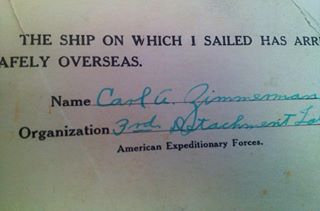
Cold enough to freeze the .....1917
The coldest year in Mt. Vernon history through 1958 was said to be 1917 with an average temperature of 49.6 degrees eclipsing the year of 1885 when it was 49.7. The third coldest year was 1958 with an average temperature in the mid-fifties.
Unafraid Republican Editor Receives Letter from Orville Wright.....1917
Our great publisher, historian, politician, author, poet, son of song writer, a Principal in Leavenworth, Kansas, etc., who came to Mt. Vernon in 1900 after learning the publishing business in Los Angeles got a letter from Orville Wright from Dayton, Ohio thanking Hanby for sending him a Mutt and Jeff cartoon and wrote: " Jeff's idea has more chance to fly than most that have been suggested to us." B.O.'s name was Brainerd O. Hanby and was the son of Benjamin Russell Hanby who wrote the song "Darling Nellie Gray" an anti-slavery song while a student in college and sold it for $50.
Parade around 1916
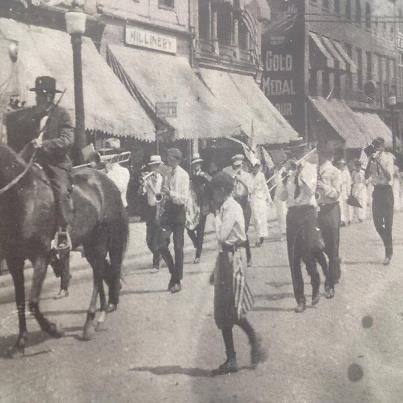
The fellow on the horse carrying a bayonet is not Romney.
"But I Ain't Got No Money Hunnie".....1916
Harley Stringler, of Mt. Vernon came to Evansville on a Friday night to take in the city lights. He had the enormous sum of $15 and he wanted to see the theater. But by early evening he fell in with some bad company. With two male and two female friends he went to John Street and spent the night arising Saturday morning with his bundle of cash gone. He notified an officer and the four associates were arrested. The two women were fined $10 each and the men were fined the same amount, plus 10 days in the county jail.
E. B. Schenk Hardware on Main Street...1916 Centennial Parade
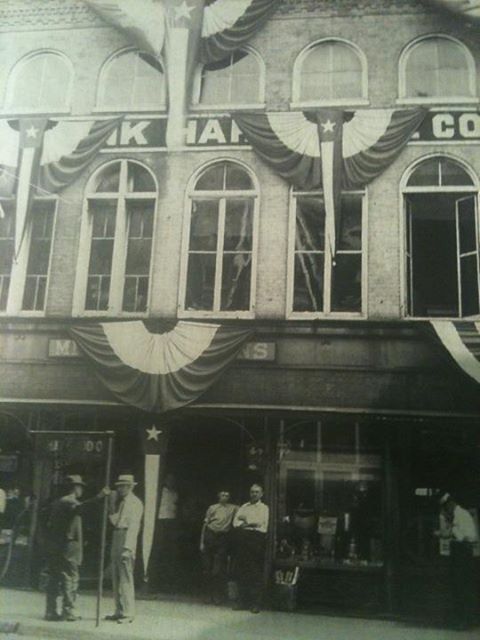
Circa 1915 Hartung Dry Goods 227-229 Main Street
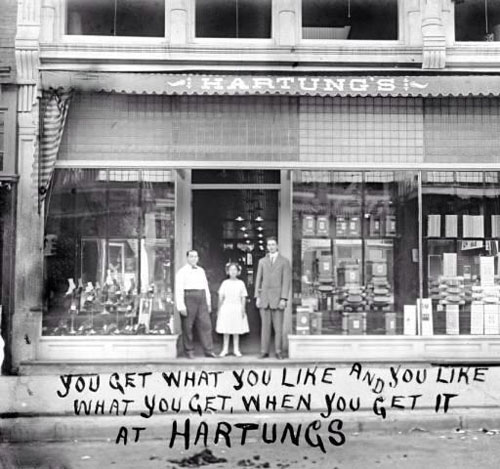
I believe this to be a Jones photo a professional photographer at the time who eventually went to Chicago. Several photos I have seen bare his writing on the photos that must have been used as newspaper advertisements.
William H Taft in New Harmony.....1914
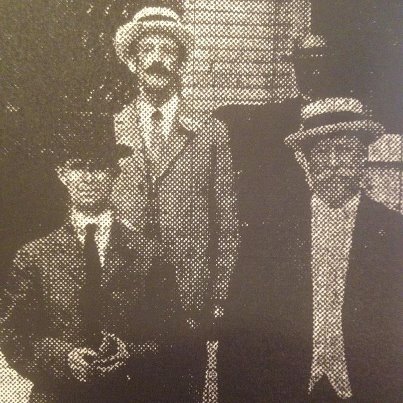
(Taft is at lower right). Arriving by train from Evansville he spoke before a couple of thousand people in New Harmony summarizing the history of the Rappites and the Owenites and their ride of socialism. Following he shook hands at Murphy Auditorium during the 100th Anniversary of New Harmony. He had lunch at the home of Captain Alfred Ribeyer and left by automobile for Princeton and a train to Indianapolis. The fellow to the right of the President is Clarence Wolfe, editor of the New Harmony Times.
Former President Taft in New Harmony.....1914
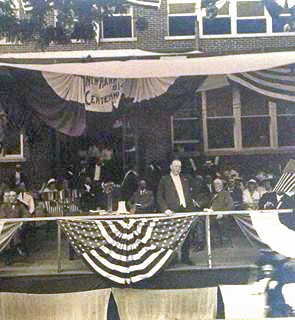
New Harmony Citizens Dress as Rappities.....1914
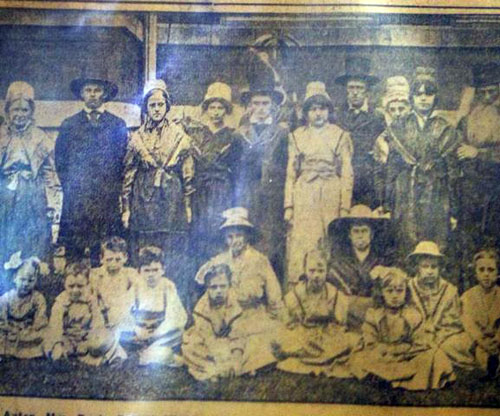
Civil War Vets in New Harmony.....1914
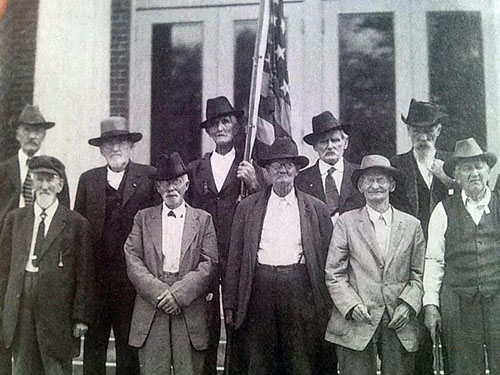
Fireman's Festival of 1913....
In late July for a week we had a grand celebration by all accounts. Every day at the new Sherburne Park we had band concerts, and there was something called "The Whitney Shows," where only 'high class, refined moral attractions,' were held. I guess you could call genuine colored minstrels, Nemo the "strangest girl alive," a snake and alligator farm, a Bohemian glass blower, a jumping horse, and a knife throwing human roulette wheel..."refined."
Water Street.....1913
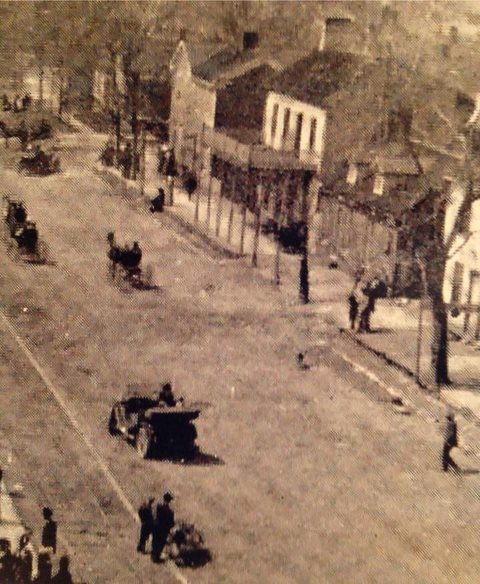
1913....the 50th anniversary of the Emancipation Proclamation and still Afro-Americans hadn't made that many gains. Life expectancy was 50.3 for males and 55 for women. The 16th Amendment gave us the federal income tax, not seen since Lincoln. We had a new Democrat President...Woodrow Wilson who started all that "social engineering" the Republicans like to remind us of. Yes, ole Woody Wilson was an activist...pushing to lower rates on tariffs to make imports cheaper and he established the Federal Reserve system and he started busting trusts. He took the conservatives off guard supporting a bill to regulate child labor and pushed for federal loans to help the farmer. He even came out for limited women's suffrage. We were a party of construction and progressivism. Then the war came.....
New York Publication Brags on Mt. Vernon.....February 1912
Nelson's Loose Leaf Perpetual Encyclopedia said of Mt. Vernon: "Mt. Vernon is the county seat of Posey County, 19 miles west of Evansville, on the Ohio River and 7 miles east of the Wabash River. It has rail service, a traction line, boat service, two daily from Uniontown, Ky., and daily packet boats to Paducah, Ky., and weekly packet boats to Memphis, Tn. It is an agricultural and manufacturing center producing flour, hominy, lumber, wheat, corn, hay and oats. The county has around 400 acres under cultivation and ranks first as the best corn and wheat producing county in the state. It has a great court house, a magnificent Carnegie Library, a high school, grammar school, Central school, Western school, and Booker T. Washington school. It has 9 churches of various denominations, 4 large flouring mills, a tile factory, largest foundry in the Central states, 3 planing mills, large sawmill and stave and heading factory, 2 cooper shops, tool handle factory, one of the largest strawboard factories in the world, mammoth brickyard, glove factory, and the best retail stores to be found in a city its size. The Poor Infirmary is a magnificent building with every convenience, and has the best management in the state. The county often receives commendable outside press notices for the capable manner in which its poor is cared. City maintains a good fair ground, baseball park, city park on the river front, has 4 miles of asphalt streets, 5 miles of Macadam streets, all with concrete curb and gutters. Three first class banks with the First National being the largest, then Mt. Vernon National and People's Bank being about the same in capital stock. It has two daily newspapers, 5 weeklies, first class opera house, two Nickelodeons, good water works, an electric light plant and a good police force."
New Harmony Times Editor Gets a Weapon.....1910
Hereafter the editor of the Times will be able to defend himself against irate subscribers of his editorials. He is now in possession of a genuine tomahawk, such as the Miami's used to fight off the encroachment of the white eyes and in tribal wars. The weapon was presented to the editor as a gift from Thomas Nickens of Lynn Township who found the ax and put the handle on it in Indian fashion.
Old Alexandrian Library now the City Hall Annex - 1910s 520 Main Street
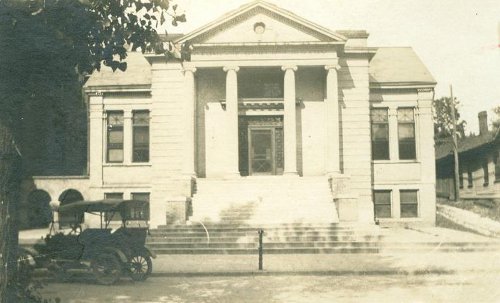
I wonder what that pole is out front? Place to hitch a horse? Check that building to the right...interesting. A city directory of 1915 says the library was at 516 Main not 510. By 1955 the street address was 520 so clearly the numbers changed over time. Anyway trying to find out what that building is to the right I again turn to 1915 and see there were private residences and the closest looks to be a Herbert Hogan.
Recollections of Elisha Jones.....1910
"Old Elisha," reminds me of a Black Oak Arkansas song....never mind. This pioneer had the privilege up to 1910 of living under every President of the United States, except the first four and the state of Indiana was only 4 years old when he was born. One of his grandfathers settled in Posey in 1804 and the other one in 1808. "It took men and women of energy and lots of get up and get to face the dangers and privations of frontier life. All southern Indiana was thickly covered with forest, the greatest hindrance and bother to the early farmer, was to get rid of the timber. I have seen the finest kind of rail and board timber burned, just to get rid of it." Jones said when the field was cleared and planted "meriods" of squirrels, (guess that means a lot,) would scratch up the corn and destroy it. The farmer set traps about every 150 yards apart to trap them. The children had to go around once or twice before noon and as often in the afternoon to take out the dead squirrels and reset the traps. It was common to catch up to 10 on one go around. Game was plentiful and a saddle of venison hams could be bought for 75 cents. The hams were generally dried whole. Wolves would come up from the river bottoms and raid the farmer's sheep. Foxes, mink, hawks and owls were always trying to kill their chickens. Rattlesnakes were plentiful also. There was a old mill on Big Creek which was infested and was called "Rattlesnake Bluff." Elisha said people seldom in the early days had coffee or store tea. Sassafras and brush were their substitutes. Their sweetener was homemade maple sugar. Women loved their flower gardens of hollyhocks, marigolds, touch-me-nots, and cocks-combs. When the tomato was introduced, no one thought of eating it. It was prized for its color only and was called a "love-apple."
1900's
Runaway Horse on Second Street....Amusing.....August 1909
Two small boys were in a buggy that was drawn by an old horse on West Second Street. The boys were from the country and were on their way home, and passing the corner of Second and Store the old plug became frightened and started off on a short gallop; maybe three miles an hour clip. That was about as fast as the nag could go; but that was entirely too fast for the youngsters who held onto the lines for dear life. As their strength began to fail they started to yell, "ketch 'im, oh ketch 'im, please won't you ketch 'im." Those watching thought from the speed of the horse that the boys were just "fool'in." But, finally one citizen got hold of the runaway after he trotted about six blocks and after cooling down the boys' anxiety, the young fellas continued their journey home.
"Any Color? So She's Red!".....July 1909
Theo Raben after consulting his neighbors and dozens of others as to what color he should paint his handsome residence at the corner of Fifth and Locust went and painted 'er red with "Yailer" trimmings. I bet that thar home was a beaut! Now if you git lost, jist go on over to that thar red place to git yur barings, yah here?
Mt. Vernon Without a Picture Show; but We Got the Cotton Blossom....July 1909
The city at one time had three theatoriums or nickel shows, but on this date there was none, the last one conducted by Guy Spencer, closed. For some reason it was reported in the paper that the merchants in that area were pleased. Editor Leffel said, "I was a regular attendant, but they finally became so bum that they threw up the sponge and quit." Well, anyway, out on the levee for the time being the Cotton Blossom Floating Theatre was in town giving top flight vaudeville acts with the scenery "just the best ever." Theatre-goers always came out for this boat which would sink in an ice gorge at our city in 1918. The Cotton Blossom would serve as the inspiration for the musical "Showboat" many years later.
"Getting Up With the Pheasants?".....1909
Joe Jeffries was cutting wheat in his field, five miles west of Mt. Vernon when his binder ran over a nest of a pheasant, breaking several of the eggs and since the nest had been disturbed Joe concluded that the pheasant would not return. He found eight unbroken eggs and took them home and placed them under a hen. Six of the eggs proved to be fertile and the young pheasants now over two weeks old, follow the hen and her chicks around the place as though they belonged with the old mother hen who guards them as carefully as she does her own chicks.
1909 Cadillac
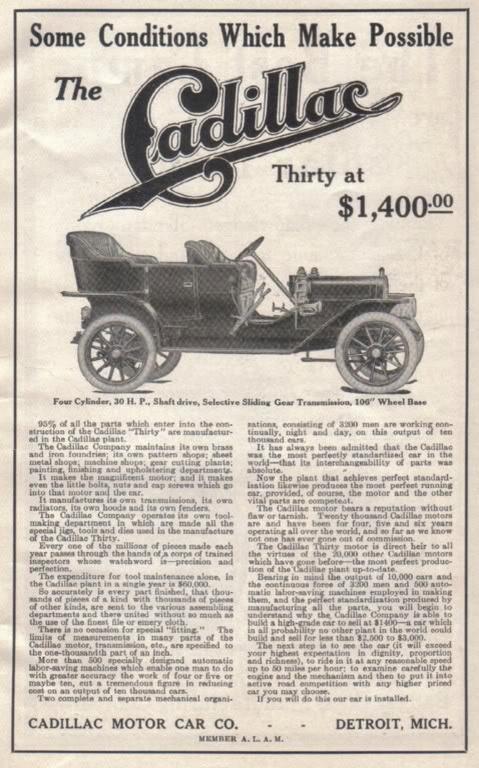
Louis Keck's 30 horse power Cadillac touring car arrived in 1909 and was the prettiest in the city it was reported. Louie could be seen riding into the wind testing its strength and pronounced it, "perfect!" Two weeks later he barely avoided a collision with Ike Rosenbaum on Second and Mill streets. Keck swerved and ran through the open gate of Tente's wagon yard. (later the location of Hironimus) Ike swerved, hit a curb and blew one of his tires.....Okay Mayor Moeller can we look into stop signs?
Old Blues Knock Down a Few.....9/24/1908
On a Saturday Ed Redman and Samuel Benthal of Black township and E.E. Bradley of Niangua, Missouri, all members of Co A., 25th Indiana Volunteers Infantry, under the command of the late Col. John Rheinlander met at Brettner's Hotel in Mt. Vernon and took dinner together. It was the first time these gentleman have met Mr. Bradley since the close of the war. At the battle of Davis' Mills, Mississippi on the 21st of December, 1862, these boys with 14 others were captured by the Confederates and these three are the only ones surviving; hence the reunion.
The Sentiment on the Plaque of the Soldier's and Sailor's...Where Did It Come From.....1908
According to local historian of the time and newspaper editor, B.O. Hanby it came from the pen of New Harmony resident Captain John Corbet. It reads: "A patriotism which readily responds to its country's call, a deep reverence for the laws, a decent respect for the rights of others, a sincere love of justice, truth and country are the safeguards of a nation's peace."
"Up Against the Wall, " for Smoking.....1906
Long ago there was a law in Mt. Vernon that forbid anyone to have in their possession cigarette papers or a "manufactured cigarette" that was wrapped in paper. A Western Star clipping said, "Jesse Conner was arrested by Officer Frank Smith on Saturday night for smoking cigarettes." Thus, Conner was the first victim arrested under the new anti-cigarette law in Mt. Vernon. Squire Rowe heard the case and fined Conner $25 and cost. Conner went to jail also for 35 days!
Early 1900's
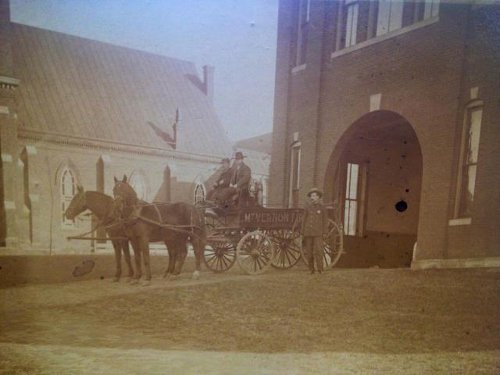
Attempting to Put Court House Flag at Half Mast Almost Deadly for Custodian.....1905
Marsh Hall trying to put the flag at half-mast in February of 1905 almost came near to a fatal ending. The heavy wind made a sail out of the large flag and the rope became entangled with Marsh's underpins and he was violently thrown against the iron railing, which he was fortunate enough to be strong and held his weight. Marsh had two spells of nervous chills over his narrow escape and gave it up without putting up the flag. One other court house item of that time....Joseph Blase, Cynthiana Argus newspaper editor was elected County Clerk and he after being sworn in he became so ill that he never did serve being only 41 years of age.
Judge William Paley Edson 1834-1902
Born in Mt. Vernon he was mayor of Mt. Vernon in 1868. His father Eben was an early settler in Posey and a talented lawyer. William was a member of the Indiana state house of representatives in 1857, common pleas court judge in Indiana 1871-1872, and a candidate for justice of Indiana State Supreme Court in 1876 and 1882. He also was prosecuting attorney of Posey County. It was said that before he reached manhood he read every book in the county that would benefit him in later years. His mind according to John C. Leffel, publisher of the Western Star newspaper, "was a storehouse containing main facts on recall of the books he had read." He started off as a teacher in county schools and by the age of 19 he began to study law in the office of the great Lincoln-Hovey mentor, Judge John Pitcher. At age 21, he was a member of the practice. When he became a member of the state house, he was the youngest member of that body. He was chairman of the joint senate and house state library. He introduced a bill for the geological survey of the state, to aid in mineral development. He also became a friend of Abraham Lincoln. He had a home on Walnut Street that stood up into my lifetime. He actually traded his home for a while in the 1880's to a Richard Sarills for 536 acres of land in Illinois on the Wabash River. William stayed here practicing law and sent his family to Bloomington, Indiana to give his children the best education available then they came home. Edson was one of the directors of the local First National Bank. Sarills was a prominent grain dealer.
"But it was only infatuation, running away with me".....1902
A deputy United States marshal was sent to Mt. Vernon to arrest a 22 year old son of a prominent farmer who was charged of sending an obscene letter to a prostitute in Evansville. Ed , who had an impediment in his speech was " not considered very bright," had met this woman on a recent trip to Evansville and becoming infatuated with her, upon his return home, wrote her a very weird explicit letter which was turned over to the police, and afterwards fell into the hands of the feds.
Rockport-Boonville Lynchings....1900
Recently I was asked about the Boonville, Indiana lynching. I had never heard of it; but since i came across an article that said three black men in Rockport and one in Boonville were hung for the death of a white barber. It was said that there were over 2000 Negroes in Rockport at the time; mostly unemployed they say and they would hang in the 'dives' and cause trouble. It was also said they would sell their votes come Election Day to those who paid the most. In those days there were Sundown laws to keep blacks off the streets at night. Many of Ohio Valley town had their black populations diminish in the smaller towns with populations moving to more urban settings with a larger black population.
Billy Goat Racing.....circa 1900
I remember when I was a kid they had soap box racers. I remember those Dremstedt brothers were competitive in those wooden cars. Long ago however; way back a century ago, boys would make two wheel race carts and hook goats up to them and race at the old racetrack east of town. In the summer evenings around 6 pm, the kids would put on quite a show and the elders would come out for the entertainment....and sometimes a wager. One boy was said to have had a saloon backing him and one heck of a fancy cart. Reminds me of a "Little Rascal" show.
1890's
Havana, Cuba.....December, 1898
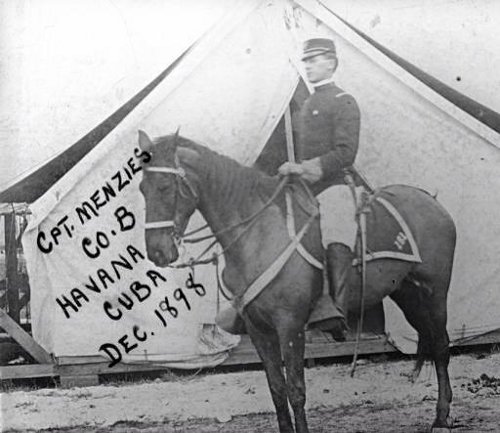
Captain Menzies. War ended before Mt. Vernon men entered the war although they were down south training.
Posey County Post Offices.....1898
Back in the "Gay 90's" in "Good Ole Whoop Pole Township", hahaha, people walked many miles to receive their meager mail at cross roads post offices. I doubt they didn't get all the junk advertisements today. No credit card offers, no hearing aid ads or offers to change your cable provider. Our county had 26 post offices, now we are probably under 5. By the 1930's we had seven in Cynthiana, Poseyville, Stewartsville, Wadesville, Griffin, New Harmony, and Mt. Vernon. But in 1898, besides the ones mentioned we had offices in Blairsville, Bufkin, Caborn, Farmersville, Grafton, Heusler, Hovey, Kilroy, Kleiner, Lippe, Oliver, Parker's Settlement, Rapture, Saint Phillip, Saint Wendall, Savah, Solitude, Upton, and West Franklin. I don't even know where some of them places are! Between 1900-1905 we started getting Rural Route mail service or as if was called "Rural Free Delivery (R.F.D.). Then post offices began to disappear.
Teen Shot for Walking in Man's Field....1898
Oscar Welborn, 44, shot and killed J.F. Reynolds, 18, with a double barrel shot gun because he said he continually would walk through his wheat field and he had enough of him.......sounds reasonable doesn't it?
"Cos I'm T.N.T. I'm dynamite; T.N.T."......1897
Right before Christmas many of our citizens wrapped up warmly and headed to levee to see Floyd McMeans of the U. S. Snagboat, E.A. Woodruff from Cincinnati commence work with his three assistants in removing our sunken wharf boat by means of dynamite! Yep, that's right...the explosives were placed in the hull and discharged by a battery....sending timber heaven bound. Everybody got out alive and now we can place in a new one....."cos we're T.N.T.....watch us explode!!"
How about a fish? Don't you have any fish?.....1897
William Doly, living west of Mt. Vernon, while hunting on the Wabash River, winged a bald eagle, measuring 7'4" tip to tip. He brought it into town and presented him to "Trick" Dieterlie, who then devoted his leisure time catching rats as the bird consumed as many as a dozen a day.
Death & Sex.....May 1896
A picture in time of long ago shows that in New Harmony the town marshal's wife committed suicide by shooting herself in the chest with a 38 caliber Smith and Wesson revolver. She was 34 years of age. In Mt. Vernon we had three prostitutes arrested by Marshal Boyce and Deputy Marshal Quick. They were given another slap on the wrist before Squire Hutchinson and fined $5 in costs. One paid her fine from a stash in her garter belt and the others went to jail.
We Take Our Politics Seriously.....1896
Ben Hunter was the superintendent of the Water Works and was the Republican orator at the barbeque in Point township. A Democratic meeting had been advertised and the place was packed. Hunter looked out over the assemblage and said, 'I see you are all Democrats, and therefore must be sheep and before I proceed, we must have one goat." "Who will be the goat? Who will be the goat? Come on, who will be the goat?" Not receiving a single response a tall man rose from the rear, pulled a revolver strapped to each side and said: "Mr. Speaker, you are a stranger to me, and I'm a Democrat, but in order to see this show go ahead, I'll be the damn goat." Mr. Hunter a a a , well he, a kinda decided this was not the kind of audience for his humor and sat down freely admitting later that he was the goat and in the future he would make no more Republican speeches at Democratic gatherings.
Stolen Meat Found...Come and Get It.....1896
Marshall Quick received a phone call from Uniontown, Ky., asking if any meat had been stolen in our fair city as two men were trying to dispose of some there. Quickly Quick made a quick (:>)) investigation and learned that the pork house of Rosenbaum Bros. had been broken into and lots of bacon had been stolen. The Marshall immediately notified the Uniontown authorities and they arrested Henderson Vincent, a plasterer of Mt. Vernon and John Moore, an ex-saloon keeper. After the heist the two men made their escape in a skiff taking the meat with them. It was found that part of the meat was left in New Haven on a farm where Moore told the farmer he had slugged a man here and was compelled to leave it and would return. Well, that ain't gonna happen anytime soon. He's behind bars.
"Daisy" The Missouri Girl, Play Held at the Masonic Hall.....1896
All those who purchased their tickets at Fogas' drug store were treated to some mighty fine comedy it appears. The scene was laid out in the southern part of Missouri during this present boom where everybody is excited about the rich lead and zinc mines being discovered. The play deals with an old farmer on whose land ore is found and who has a hard time trying to keep it away from grasping capitalists. Hmm, sounds a little like fracking speculators today. The title role, played by Miss Sadie Raymond was said to be very clever. "New songs were written for her this season and she does some difficult and catchy dancing." Mr. Fred Raymond as Zeke Dobson, the country clod-hopper kept the local audience in a continuous roar of laughter. Looks like this play is a hit, not bad for a 35 cent admission.
Grave Diggin' Goes Up.....December 1894
The directors of Bellefontaine Cemetery met and raised their prices for digging graves a buck. The new price will be $3 for a child and $4 for an adult. In other macabre news....Henry Weisinger has been elected coroner.
On February 26, 1894, 40 men of the city became members of the Mt. Vernon lodge of Elks
Their first home was on the third floor of the Wekesser building at Fourth and Main streets. In 1910 they purchased the home of Hovey at Walnut and Fourth. There was a disastrous fire in 1919 which gutted a great portion of the interior, but it was rebuilt.
Fall from Pony Proves Fatal.....1894
Twelve year old Arthur Zimmerman was thrown from a Shetland pony and died when his head struck a rock in the northern part of town. The boy who lived on West Eighth Street had borrowed the pony from Charles Dawson, the druggist and was riding on Main near his home when the accident occurred. He suffered a wound to the forehead and temple and was carried to his residence and medical attention was summoned. He lived almost two days before he was relieved of his sufferings. The boy lay in state at the home and tremendous amounts of flowers and visits from local children were noted. The young man was laid to rest at Bellefontaine cemetery.
Desparados Try To Take Over Griffin.....December 1893
Dan Williams, a saloon-keeper at Griffin, shot and killed Elmer Fisher, who along with three other toughs was on a drunk on a Saturday taking over the town. They brutally beat the railroad agent at the depot and not being satisfied with that, they proceeded to take on the saloon-keeper...but with different results. One of the other men was captured and the other two are on the run. Williams was placed under a $200 bond awaiting a trial. The one prisoner they do have was under constant guard as it was "feared he would be lynched."
We Gotta Do Somethun bout dat.....1893
A sewer is a beautiful thing if you don't have one. One gets all worried and hurried until one day you are buried. You see we had this here problem of a big ole mud hole at the intersection of Fifth and Main right in front of the Republican office. That is probably why it took a while to fix it. You know....politics. It's better now and them thar elephants can now find something else to bitch at I say...misery loves company you know.
Boom Town.....1893
Mt. Vernon continued its healthy boom of the last 18 years...first a courthouse, a new class of buildings downtown following the great fire of 1880, a new hominy mill, another flour mill, a strawboard paper mill, and soon there is talk of a hub and spoke factory and a new high school. Yes, neighbors it can be said that we are a "live" town.
Ruins of Hominy Mill.....1893
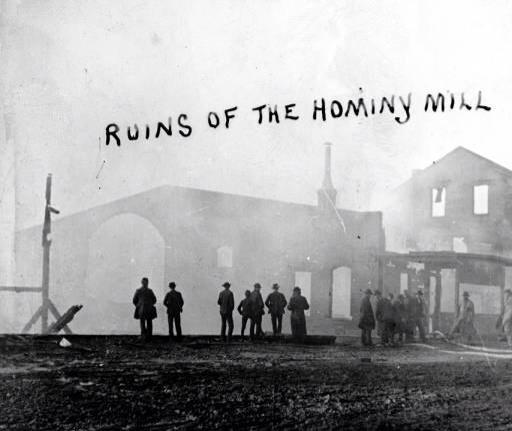
Mt. Vernon's Industrial Brick Company produced much of the brick to restore the mill. I read of an order for 400,000 brick.
Gov. Hovey Laid to Rest in Belfountaine....November 27, 1891
On the twenty sixth of November, eleven carloads of people arrived by rail to Mt. Vernon for the funeral of our favorite son Alvin P. Hovey. Those by train were not the only ones visiting. As many as 10,000 strangers were in town to pay their respects. Regimental bands moved down Main Street to the court house, soldiers who fought with General Hovey were present. A militia arrived and they camped out and quartered in the Masonic Temple. There were military companies from Indy, Terre Haute and Evansville. At the court house the body was placed in the rotunda upon a bier. At the head of the bier was a large floral design in the shape of a chair, with the words, "From the State Officers," inscribed on a card. Another design set up on an easel; bore a card, "To our Comrade-From the German-American Veteran Association. Another was a huge star of white chrysanthemums with a US flag in flowers. The bier was also trimmed in the American flag. A Mt. Vernon choir started the proceedings and Governor Chase gave an eulogy. Allusions were made of comparisons to John Quincy Adams and Andrew Jackson. On the trip to the cemetery, the funeral cortege was over a mile in length. A militia formed around the following leader and the body was placed in its final resting place. More speeches were made in his honor and a flag was held over his grave as it was being lowered. Thus concluded the life of a diplomat, a soldier, a governor ....a Mt. Vernon hero.
Telegram from President Harrison on Death of Governor Hovey.....1891
"The news of the death of Governor Hovey, which your telegram conveys, fills my heart with sorrow. He served his country with rare devotedness and distinction to high civil and military offices, and will be sincerely mourned as a brave comrade and a generous friend by all who knew him. Please convey to his family my sympathy and my regret that I am not able to leave Washington to attend the funeral service."......President Benjamin Harrison
Hovey Funeral Train Arrives in Mt. Vernon.....1891
The funeral train contained Major and Mrs. Menzies and their daughter Mary, Charles Hovey, and Mr. and Mrs. Press Bowman, relatives of the late governor. The entire train was draped in mourning, while the engine was literally covered in bunting and mourning cloth. In front of the headlight was a handsome portrait of the deceased, twined about with the colors of the American flag. It stopped at many places on its way from Indianapolis to Mt. Vernon. It stopped at Greencastle and was saluted by students with a fired artillery salute, it was in Brazil and met by several thousand people at the depot, on to Terre Haute and the casket was lowered to be viewed by several thousand citizens. It stopped at Sullivan for a few minutes then to Vincennes and to Princeton and on to Evansville; the train was composed of a baggage car, three day coaches, a chair car, and a private car. There were all sorts of state officers on board. Governor Chase, Secretary of State Mathews, the State Treasurer, State Auditor, State Superintendent, Attorney General, Judges and Supreme Court Judges, State Librarian, President of the Senate, attorneys ,a general or three, veterans group officials and friends. The funeral car was brand new...its first trip out. That car was full of military officials all in full uniform. The coffin was plain black with silver trimmings and handles. Over the covering of the face was a plain silk plate bearing in chased letters the dear word Father. Near the center of the lid another plate, richly carved, with bore his name and date of birth and death. Just below that plate was another from the state officers the G.A.R. containing a design of the order's badge surrounded by the words, "Fraternity, Charity and Loyalty," and in the center the words: 'At Rest.' During the progress of the funeral train the burial case was covered with a heavy silk flag of the United States. The remains looked as natural as in life. No discoloration...the arms laid across his breast and in his right hand a handkerchief as he often liked to carry.
Governor's Kin Moved to Bellefontaine Cemetery.....1891
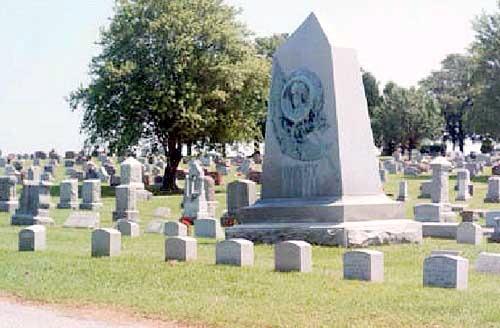
When Alvin P. Hovey died, laid in state at the court house and buried at Bellefontaine Cemetery north of Mt. Vernon he was joined by many family members in death. Several family members it was said, who had lain peacefully at Leonard Cemetery were reinterred at the newer cemetery. By doing so, those souls escaped the fate of the old cemetery which fell into neglect and were forgotten so terribly.
Before Texaco, Before the Strawboard Company....There was a Slaughterhouse......1890's
A long time ago, if you were a "city slicker" like I and you wanted a "fresh" chicken you went to the butcher shop. Grocery stores sold groceries...butcher shops sold "dead" animals. Back before 1900 there were at least three slaughterhouses near Mt. Vernon where the meat was processed for the shops downtown or uptown. Stats Meat Market was one of the shops located on the 300 block of Main. Now one slaughter house was located outside the city limits on a road that according to Pop Fessenden led from South Barter Street. Cattle and hogs were driven to the stockyard here and killed. Can you imagine the site of cattle being herded down the streets? Another slaughter house was located near the city that was used by Lorenz Hempfling who had a meat market where the Neu Way Cleaners was located and still another was used for Robert Fisher's meat shop on the 300 block of Main. I have found one picture of it which was shown once before.
The First Pneumatic Bicycle Tire in Mt. Vernon...Late 1880's...early 90's
Years ago Main Street was nothing but large rocks and mud holes. It was pretty much impossible to ride a bicycle on with all the ruts from wagons heading down to the wharf and all. But, there was this doctor in Mt. Vernon named J.M. Hale and he caused some interest by riding the first air filled or pneumatic tire on a bicycle in town. John Dunlop got the patent for this in 1888 and somewhere a little time later, the good Doc got his sweet ride. Yes sir, all decked out in tires of red rubber with rubber mud guards too. He had to ride on the sidewalks however and I imagine that wasn't so easy either with wood planks and merchandise on the curbs. All those horse troughs and people coming in and out of a busy downtown. It wasn't long after that roads started improving and the bicycle fever hit its stride. I wonder if they had a little bell or a horn.
1880's
September 1887
The old Damron House on the corner of Water and Store Streets was converted into a school house until the new building on North Main was completed.
Evansville a Dumping Grounds for Unwanted.....1887
An editorial appeared that caught my eye where there was much concern that very poor people who lived from hand to mouth were being dumped in Evansville. What was happening was small towns would have vagrants, mentally ill; criminals etc. and they would want to get rid of them. What they would do was at the first opportunity they would give them railroad transportation to Evansville. If a man was sick in Cairo, Illinois off he would go....If a man has been filling up the jails in Vincennes for drunkenness, a ticket was quietly given to him to reside elsewhere. In this manner dozens of paupers, injured, and criminals were shipped into Evansville every year and became the burden of the taxpayer. Sometimes it was just a stern suggestion to vagrants that economic opportunities were many in the big city. "There is scarcely a night that lodging is not given to two or more wanderers at the Central station, with breakfast in the morning," the editor said. He said the annual cost to the city of these foreign products is way up into the hundreds of dollars, but no prevention has been found for sending them there. Being sent back and forth didn't work because the paupers were averse to being shipped like cattle and started lying about how they got there or where was their origin.
Measles Explosion of 1887
Seems to have been a wild year. Our boom town of the 1880's was still expanding as 90 homes were constructed that summer. In the midst of all that we had measles throughout the county killing by the end of May 150 people according to undertakers Weisinger and Neumann. Decoration Day was observed with a parade through downtown to the German Cemetery (Bellefontaine). About 25 Civil War veterans marched accompanied by a musical band, followed by the Fire Department and a wagon loaded with 35 beautiful girls. At the cemetery, Major Menzies delivered a speech. By August, Alvin Hovey proposed to sell the city two lots on Main Street for the purpose of building a city hall and fire station. Later that month we had a city wide BBQ with 10 sheep, 5 hogs and one cow butchered. Eat hardy...see ya at the bicycle races on Sixth Street in the evening.
"Shun the Bait; Temptation is the Devil's Hook".....1887
Worth Templeton delivered a temperance lecture at the court house in which he declared against prohibition and banning prostitution. Said that �what people eat, drink and wear are matters of their own concerns, which the State has no right to interfere with." He believed that saloons and she-bangs are a" kind of necessary evil designed to test those who claim admission into the eternal home beyond, and that men who have not the moral courage to resist such temptations are unworthy of future happiness and bliss." Lord have mercy on me!!
Remarkable Phenomenon at Vincennes.....July 1885
Noticed by thousands around 4 o'clock on a Saturday afternoon a funnel shaped cloud approached the city and finally resolved itself into a giant immense water spout. "It swept down the Wabash, whirled the water into the clouds with lightning rapidity and was the grandest natural phenomenon ever witnessed by our people." During its run it upset boats in the river and was about 200 feet in circumference and was the talk of the town.
Joest's Barbecue & Grill.....1885
This old establishment sat on the corner of Second and Main where Steve Burris now has a barber shop. Here you could have got a barbecue sandwich and several items of liquid refreshment. Known as gathering place to talk baseball, hunting and fishing; I guess it was a sports bar in its time. Lots of the local merchants would stop there for a chat and a bite.
In Evansville November 1884
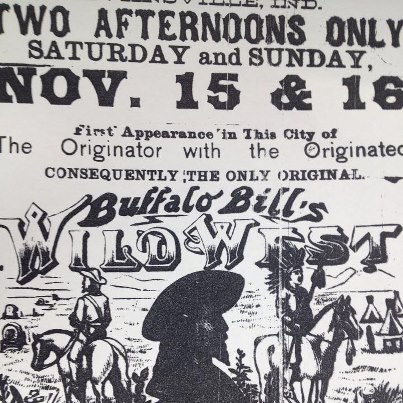
A crowd of 2000 showed up and the applause never stopped. Mr. Cody a "fine and athletic a specimen one could ever find. He certainly is a magnificent shot with the rifle and his feats with the Winchester while riding down the home stretch with his horse at full speed was challenging and gained the admiration of all. " The show had Indians, over 120 horses, several head of steers, buffaloes, elk and mountain sheep.
The "Belmont Disaster".....August 1884
This occurred when the Belmont steamer capsized during a tornado that summer of 1884. The Belmont was pushing a barge from Evansville to Henderson when it was struck by a tornado. Ten to 15 people drowned.
Shoot Out at the L&N Depot.....July 1884
Lew Tyson and another man became engaged in a quarrel near the local depot, during which they pulled out their artillery and exchanged one shot each. Tyson was shot in the chest and the other man....his leg. Both fled before an arrest could be mad and Tyson died of his wound in Kentucky.
Wild West Show Leaves by Boat.....1884
There was a world of interest at the Evansville wharf for the cargo of the W.P. Thompson was that of the honorable Wm. Cody, forty Indians, 20 cowboys, 22 Mexicans, over a hundred head of horses, a herd of wild buffalo and steers and all those loading them. When the first came into town the steamer ran ashore at the Scuffletown sandbar causing quite a commotion among the 'redskins', and "other animals.' They tried to back her off, but were unsuccessful. At daybreak, Cody ordered the Indians and Mexicans into the water, and jumping in himself, with a shout all hands went to work to push her off. But that didn't seem to work either. Up to their armpits in water they decided to remove the horse flesh and lighten the load. The bridge was dropped and the in a jiffy the horses were off. Next went the buffaloes. An old bull wasn't too keen on the Ohio River and bellowed loudly. The boat then slipped off the sandbar and one Mexican, who could not swim stepped off the gang plank into eight feet of water. A cowboy on a horse swam his horse out to him and drug him ashore. The show then started with whooping Indians and Dixie bands.
Mental Health Issue....1884
A local man committed suicide by shooting himself in the head. He had just been released from the "insane asylum."
Fighter Knows Some Tyson Moves.....February 1883
Aww nothing like a fight at the levee! We don't do this much anymore; but with a new riverfront....we will get around to it. This type of baser entertainment always drew a group of onlookers on a Friday or Saturday night. Now this here rumpus was between Fred Bishop of New Harmony and Pete Hess of our great city. These two river town gentleman had a dispute and in order to fight "fairly and cleanly." they first disarmed dropping guns, knives and clubs on the ground. That took a while. Still the viciousness of the affray became evident when Bishop began to use his teeth on Hess in a "lively manner,' whereupon Hess embarrassed his community by squealing like a pig and begged the passers-by to pull Bishop off; which they did reluctantly. On the same date, a man named Meade who was sent to the penitentiary for knifing Joseph Griffin was recaptured in town by Sheriff Crunk after two weeks of on the run. Due to exposure his feet were frozen and several of his toes had to be removed by Dr. Ramsey, before he could be sent back up to the 'big house.'
Alcohol Called #1 Problem in Mt. Vernon...1883
Papers said the misuse of alcohol was the number one problem in our little town. Marshall Park released a report covering the previous six months showing 80 arrests had been made of which 50 were for drunkenness, 18 assault and batteries, 3 for concealed weapons, 4 for burglaries, 2 for illegal ferrying, 2 for cruelty to animals and one for trespassing. One memorable incident of the baser side I found was relatively common place at the corner of Main and Second. This place always attracted the onlookers. A fight was in order but the participants first took time out to disarm themselves of guns and knives they were carrying. How gentlemanly like, don't you think? Not so. Wasn't long before the viciousness of the affray worsened as one began to use his teeth in a lively manner on the other. While they were breaking that up, on Water Street two masons got into it over the ownership of a trowel. This got so bad a brick was thrown "denting" the head of one man who was carted off to the doc.
Princeton Newspapers says: "Turn Him Over To Posey County Mob!".....1883
Boy, the reputation we had!! It seems in Princeton a man was arrested for cutting out his horse's tongue. In fault of $200 bail he languished in jail. "Anyone guilty of such inhumanity, has not half the soul of a skunk, let alone that of a horse, �said the Princeton Democrat. "It is thought here that the best way to insure him getting his just deserts is for the Princeton people to turn him over to a Posey County mob."
Two Prisoners in Jail Write Letter To Editor Awaiting Ride To Penitentiary.....1883
Editor of the Western Star, "As the river has prevented us from going to the pen, and we promised you a few items from Jeffersonville, we will endeavor to give you a letter from jail. Our number is not as large as by one as it was last week, but the number of convicts is steadily growing. Although we are not in a great hurry to leave here, for we get the best of treatment from Mr. Hayes, we told you in our last letter, we are closely confined in our cells, but we cannot blame anyone except ourselves, as we made an attempt to escape by cutting some iron bars in the jail. We understand that the citizens at large think this jail is to be so built that it would be impossible for a prisoner to escape, but we would have learned them different had we not been given away. Among the number of prisoners going from here are six two year men, and one for fourteen years. We have had but few visitors this past week, as the high water and bad weather I suppose, prevented them from coming. But there is a class of dead beats who come and stand in the corner and look at us as if we were a portion of some wild animal show. We ask them to call again, and we will try to be better prepared to entertain them the next time they call. We will close by saying to the readers of the Star that we are in good health, and hold a stiff upper lip, if we are going to the penitentiary". ...J.H. Norris and W.L. Manker
Hume Redman.....October 1882
I have written about Hume in Volume 1 of Ray's Ramblings on page 31 if you have it. If not I am going to repeat the story with a few more items of information. Joel Hume Redman was a prisoner in Memphis for two months in 1863 while in the army. The next two months he was AWOL. Two months after that he was in a military prison. He was 22, a cooper by trade and he reportedly killed a Negro who was drawing water out of a well. He was court martialed but escaped death by a technicality. Later he made a real escape and returned home. He served ten years in prison for shooting a man in the cheek for no apparent reason. He came back home to Posey and people were rightly afraid of him. He married four times, his first wife worked as a prostitute in Mt. Vernon, his second wife he supposedly killed in Illinois, but not enough proof was found to convict. His third wife he abused and his fourth, Eva he shot her through the brain. Eva was a McFaddin, 19, and pregnant. His second wife Rachael J. was the mother of his only child, a son David. Upon examination of Eva's body it was found to have been terribly beaten up, from head to toes she was covered in cuts from a pen knife and black and blue bruises, all in different stages of healing, caused by kicks and blows. She was shot through the skull with a 42 rusty derringer. News of the killing stirred excitement in Mt. Vernon and the town was intense that Saturday evening. Sheriff Crunk fearing his prisoner was in danger and not wanting a repeat of 1878 when Negroes were removed from the jail by a mob and lynched placed 15-20 guards around the jail. The streets swelled with farmers coming into town and by 8 pm the town square was full of citizens on Main and Second Streets all swearing vengeance. The saloons were ordered closed by the Marshall. Around midnight a mob began to assemble at Black's Grove, just north of the city and at 1 am moved down Mill Street to within two blocks of the jail. The mob dispersed then came to the jail in small squads, where anti-mob speeches were made of several of our citizens to the utter disgust of the boys calling loudly for Redman. The sheriff the next day fearing another mob on Sunday had the prisoner transferred to the Vanderburgh County jail in Evansville. The next night riders went to a blacksmith shop in St. Phillips and compelled him to deliver the tools they needed to get the prisoner out being sledge hammers and cold chisels. A posse of 75 men gathered in Evansville as the prisoner was being moved in a buggy. It was intentionally collided with throwing out Redman. Redman's skull was crushed with a sledge hammer "like a coconut." He was also shot in the head four or five times (have seen conflicting reports). He was taken to the Klee undertaking establishment and laid on the brick pavement on a couple of boards with his hands tied in front of him in rope. Much of his skull was gone, the pieces dropping off into the street. The streets were full of people in intense excitement. The entire Evansville police department was in the neighborhood of the jail when the killing occurred but could not prevent it. An officer shot and killed a man named Daniel Murphy who was an active member of the mob. An indictment for conspiracy to commit murder was returned for three Posey citizens of George Floyd, David McFadin, and Quincy Gill which said, "did feloniously and knowingly, unite, combine, conspire, confederate and agree together and with each other for the object and purpose and with the latent then and there by force to take one Hume Redman from the county jail of Vanderburgh county, said state, and then and there, the said Hume Redman feloniously and willfully kill and murder contrary to the form of the statutes in such cases made and provided and against the peace and dignity of the State of Indiana." Judge Parret fixed bond at $1000 each. I never found if they were convicted. As for Redman the Carmi paper said, "He goes to the grave, unwept, unhonored, and unsung." Redman was buried in a pauper's grave in Evansville.
Ain't Too Proud to Sleep On the Floor At Night.....No Vacancy 1882
Mt. Vernon is full at present! A new Main Street and contractors are working wide open as an increased population fills our town from each train that pulls into the depot and every immigrant that gets off a steamboat at our wharf. Mt. Vernon did not have a single home to rent at that time as living quarters were not keeping up with demand. Whole families were forced to live in one hotel room. Old shacks and cottages were being patched up hastily to turn into rent money. "Newcomers are willing to call most any roof over their heads home." Everything is up including crime. The docket is full at the Circuit Court for cases of fornication, larceny, robbery, concealed weapons, three cases for disturbing religious meetings, one case of rape, a couple murders, 18 cases of giving away liquor on election day, selling liquor on Sunday, 10 cases of prostitution and then there are the thirsty guys who broke into the Catholic churches at St. Phillips and St. Wendel and took nothing but the sacramental wine. Temperatures were hot that summer and some were cooped up in miserable huts really unfit for human habitation and one wonders what winter will bring without decent housing.
Tough Times, Huge Deficits, No More Spending.....1882
In the midst of a building boom locally a heated session of the city council occurred about a matter of opening up West Sixth Street from Store to Mill Street. Councilman Thomas opposed the opening believing the city would not need that block for another fifty years and that the city had thirty miles of street and was unable to keep one fifth of it in proper repair. "It's just not right to spend the people's money for opening a street of no value." So the matter was voted on and the street was turned down. So nothing was done about a new street or fixing the old ones. One resident said of our roads, "Even a goat couldn't grope a path through this quagmire of our bottomless ruts."
"If I had a hammer, I'd hammer in the morning, hammer in the evening all over this town." ....Spring 1881
Down at "The Landing" watching the builders. I think of the past after October 1880 and "The Great Fire." A time when land speculators were buying up Main Street property and flipping it for a profit. A spirit of building and remodeling had descended on our community and growth was unprecedented. "Workers vigorously attacked old walls and debris along Main was deep in preparation of a changing face" to old Mt. Vernon. The Western Star said: "carpenters can be heard hammering from early morning till dark and anyone willing to work can hire on as a brick carrier." The architect for the Rosenbaum store says his brickwork on a future building will be "eye-catching!"
And Then He Who Had the Sword Drew It, and Cut Off His Ear.....1881
Bethel Church in northern Posey County was having one of those highly charged tent revivals and Felix Swallow and John Montgomery had a disagreement. A church elder used the term "difficulty" and admitted that the fight ended with Montgomery losing an ear. Now it seems the Gospel where the apostle Simon Peter cuts off the high priest's servant's ear was taken a little too literal. No record of Jesus restoring the ear in the "difficulty" was reported. Maybe Felix had that rabies thing....for you see we were having a epidemic of victims of dog bites. One colt was bitten by a mad dog at that time and the colt came tearing down the streets biting and kicking everything in sight. He had to be shot as well as many cows and pigs and dozens of dogs. Everybody must have been on edge with rabies, small box, measles, and spinal meningitis being reported here and there. So keep your women and children off the streets and cover your mouth when you pray.
How Much is a Hanky Worth.....Christmas Week....1880
From time to time I read of fights and killings over little things....I have read of a man killed for walking through his pasture, a man killed over ownership of a shovel and now a handkerchief....Really! George Daniels was arrested and jailed by Marshal Ed Hayes for a stabbing on the corner of, you guessed it...Second and Main. Dad was right. "Nothing good ever happens after dark on lower Main." George he was upset over a hanky that he says belonged to him and was being used by Lafe Shyrock. I don't know if Mr. Layfette expired, but if I had been stabbed in the back 15 times.....I would 'give up the ghost."
The Beginning of the Electric Age in Mt.Vernon.....1880's
In 1883 Western Star editor Leffel was upset with the number of nighttime robberies in the city and called for street lamps and proposed that the citizens furnish the lamps and the city the oil and a lamplighter. Sometime after that it seems the first electricity generated in town came from a upright steam engine. This light plant was a curiosity and was housed in a shed of about 12X15 feet in the rear of the Butch Freeman livery stable. This frame building was later replaced by the cream station on College Avenue between Second and Third Streets. The plant was operated by Gene Knowles. People would walk along the plant watching what was going on. The first business to take advantage of the new light was the Raben-Nass Drygood Store located on Main Street. This building was later destroyed by fire and the new Stinson Bros. store was erected on the site. The lights were old carbon type that put out a reddish light and were said to be little brighter than a coal oil lamp in those days. The wiring was exposed to view at the ceilings and each light was turned on and off by a thumb switch at a globe.. By 1889 the town had a contract with the Sun Vapor Light Company of Canton, Ohio but there were many complaints of the amount of light furnished, irregularity in time of lighting, etc. Street lighting soon went over to Electric Arc Lights.
Damn Horse Thief.....1880
Niblack Ramsey....now that's a gooder for a name...Niblack, kinda catchy. Ole Nib was living in Robinson Township back then and came into town and sold a horse to Wm. Thomas for $95 and then he went about spending his wad. He got to the John Naas saloon, near the L&N depot, (you didn't have to travel too far for a drink back then) and purchased a revolver from him , (must have been having a gun show) and then the gentleman Nib shortly afterwards decided to shoot up the town. He was arrested for carrying a concealed weapon ( looks to me it was non concealed a bit) and the Mayor fined him $25.45. The next morning ole Mr. Thomas thought he should have a bill of sale, so he sent a man to Niblack's father to get it. Now Ramsey Sr. wouldn't give up such a paper because he said Niblack did not own the horse to start with and that it was his property. Well crap, young Niblack was now in Blairsville and all liquored up again he got into a quarrel that ended up in a fight, during which he used a knife rather freely on another fellow. Nib he flew home to his pop and told him of all his difficulties. Dad turned him in and so there stayed Niblack picking his teeth in the hotel Hayes otherwise known as the jail. "Bad boy whatcha gonna do?"
Fighting a Fire.....1880's Style
The water supply for downtown consisted of a big cistern at the corner of Second and Main and another one at the corner of Fourth and Main. The engine consisted of a big pump with a long handle balanced in the middle so that it would go up and down like a ...well a teeter totter. Worked by manpower. Men making it go up and down. By this means water was forced into the hose and perhaps a fire could be put out. If there was a shortage of men available...the Chief was draft civilians and if the order was not obeyed....the next day the man would be arrested and fined.
1870's
Brrrr.....January 1879
The Ohio River and the Wabash are frozen over and many Kentuckians are buying groceries and other items in local stores. In New Harmony wagons are being driven across the Wabash.
Telegraph Dispatch from the Indian War.....1879
A few days before in Colorado the Ute Indians killed an Indian agent and several other persons. A body of soldiers was sent out to engage them and the Indians attacked the "blue coats" compelling them to entrench themselves. Besieged for five days, "enduring indescribable sufferings." Reinforcements arrived and found twelve soldiers dead, 43 wounded; while outside, were lying the carcasses of over 300 horses and mules. The stench was horrible. More troops are being sent forward with all possible haste.
Big Payroll.....1877
The Mayor of Mt. Vernon in 1877; which would have been Jonathan Burlison made a annual salary of $600 and the Clerk $375 per year
Hawkin & Company.....1877
Not sure exactly where this grocery was at in Mt. Vernon; but it had some interesting items for Christmas that year. How about breakfast bacon, dried beef, smoked tongue, bloaters, and molasses? You could buy salt for $1.75 per barrel and quail was abundant for 80 cents per dozen. They had 400 bushels on hand of pecans for them pies and candies. They were always buying from the public too like eggs, popcorn, rags, feathers, tallows and for some reason they had an ad wanting to buy 15,000 coon skins!
Indian Peddler Sets New Harmony Man Straight.....1876
A clever young man with a poetic tongue went up to an Indian woman on the street corner who was selling bead ornaments and said to her, "Unhappy rose of the forest, do you mourn because your beaded moccasins no longer brush the dew from the prairie flower and the green leaves of your native woods? Was it so many moons ago that the smoke curled from your peaceful wigwam and -----" He didn't get any further, for the "rose of the forest" shook her fist in his face and said, "Gid along wid eyes, ya dirty drunk, the devil choke ya fir insult'n a hard workin' woman like me!" The young man staggered off with his buddies laughing. ....some people just want to be disagreeable, always holding to the prickly side of everything. Their prejudice and closed minds is appalling. Amazingly, we insisted for freedom from England, but denied it to the native people and to blacks. Our prejudices then were against the Italians, the Irish, the Chinese, the Japanese, and now the Muslims. Not all of us, but too many as we dare to advocate abroad good will towards all men.
~Wavy~ thinks of 4th of July at Black's Grove.....1876
I can just imagine getting in a buggy early, parking my steed someplace cool and watch the gathering of people on the grounds. Kind of like Bull Island in the 19th century I imagine. People dressed in all sorts of strange clothes, but sadly no cut off shorts or halter tops. Food would be in abundance...no Salvation Army or Reis Catering to stand in line forever. Probably get a large cup of lemonade for next to nothing with a tin cup tied to a tub. A brass band or two would play; maybe a fiddler and the mosh pit of saw dust would be full of hot chicks. ~Wavy~ would be having his anxiety attacks about then and would venture off into the creek woods for a smoke and maybe a shot of red eye to get some nerve to try and separate a certain blonde from the herd. That usually never works, but my attention would turn to some hot shot politician who would step off the locomotive and meet with local politicians before giving one of those high octane "bloody rag" speeches about how much his party had done for us and how little the other party cared. Inspired I find my own stump and practice to nobody my campaign speech..."Dear Mt. Vernonites.....As we see great construction in our boon town, I choose to run for the office of Mayor as a progressive, all-inclusive public servant. I stand in front of you at this beautiful park, just blocks away from the court house... a wonderful new edifice. I expect justice for all regardless of race or creed. I expect our great merchants who fought to protect the union to provide opportunity to the newly freed slaves...." Here I am stopped as fruit and veggies are thrown at me. "Please, please".....I propose to triple the size of our police force (that helped), and I want an ordinance better treatment of our horses. This ordinance provides that when parties leave horses hitched at public racks all night without attention, an officer will place the animal in the livery stable to be cared for at the expense of the owner. No more will we stand idle and watch the ill treatment of our 4 legged friends. I see tar and feathers being prepared so I end with I welcome ideas from all political spectrums and extol my thanks and appreciation for the opportunity to serve you." Okay, I'm getting down, no need to push.....why am I being put on the train?......Hey!
New Street.....December, 1875
In December of 1875 East Eighth Street was opened up from Walnut to Main
Courthouse - November, 1875
In November of 1875 workmen began tearing away the old court house. "The old temple of justice," had stood for 50 years, yet it was said the timber in the building was as sound as when it was first constructed. That year sidewalks (planks) were being put all over town....so much so that the supply was continually being exhausted.
Kissing Bridges or Spoon River.....1870's
Back in my great grandfather's day covered bridges were famed as lover's rendezvous. I can see them now, driving the buggy over those aged planks that must have rumbled graffiti on the trusses and siding. Stop the old horsey in the middle of the tunnel of love and fumble all around with all those things those women wore in those days.....wow! Old shy ~Wavy~ sitting in the cool shadows at a serene quiet moment would muster up all his courage to steal that first kiss. An old story was told about a young lad taking his sweet thing into one of those long dark bridges and he teased his pretty companion..."Aren't you a-skeered?" ...."Naw," was the young lass' reply, "Just make sure you take that stogie out of your mouth." Just like lover's lanes in my day there were spooky stories of these bridges. They were isolated on back roads and surrounded many times by wilderness near rivers and streams. Weird screeching owls and bats would flutter about I guess. Coyotes were around and the horse probably got a little skittish here also. No wonder there were reports of ghosts and bandits and maybe even Ichabod Crane. I bet they were something....places for kids to play on a rainy day, a place for a fisherman to cast a line, and a place to put billboards for the next fair, circus, ball game and an ad for rheumatism meds and chewing tobacco. Wish I could have seen them!
Getting Out the Vote.....1872
Heard on the news...I guess it was true; you know "Fox News"....hahaha that in California there was this place where if you showed that you had participated in early voting you could get a hit from a bong. You got to love California! You know for the sick they need their medical marijuana. Maybe we can get that covered in Obamacare the second term. My cataracts have been pretty bad recently. Anyway, back here in October 1872, the editor of the Mt. Vernon Republican carried around a gallon jug of whiskey to the polls assisting the "Radicals" in a victory. Of course, the plurality went to the Democrats......we probably had our own bag of goodies and a bottle of wine...you know sassafras and moonshine...a "stone soul picnic."
The "Good Ole Days" of Working in the Office of the Railroad in Mt. Vernon.....1872
Back when the first railroad tracks were laid through our town, an employee was expected to sweep and dust the depot daily. He had to fill each lamp, clean chimneys, trim wicks and sell tickets. He washed the windows weekly and each clerk was required to bring a bucket of water and a scuttle of coal for the day's business. You had to supply your own writing materials and ink. Office hours were from 7a.m. to 8 p.m., except on the Sabbath. Men employees were given an evening off each week for courting purposes. No, really, they were. A second evening off was given if he went to church. If an employee performed his duties faithfully and without fault for five years and he had been regular in his religious duties he was given 5 cents a day raise. My uncle Leonard retired from the railroad. I don't know if he got a gold watch or not. But he would travel on the trains and the family always looked up to him because he got to go places and send back interesting postcards. He never married, but he saw the country.
1860's
Man Hiding Behind A Tree at Court House Shoots at Grocer.....November 20, 1869
Around six in the evening as Charles Lounig was on his way from supper to his grocery he was shot at by some person behind a tree in the public square. The ball whistled over his head. Suspicion at once pointed towards a young man and a search was instilled. He was not found for four days when he was arrested by Marshall Piper at Smith's Mills in Kentucky. He was brought back for an evaluation before Squire Campbell and bail was given.
A Town Divided.....1868
A man came into Mt. Vernon from the country and cheered the ticket of Grant and Colfax, at the head of Main Street. Another man, a staunch Democrat came out of a tavern and knocked him down. The man suffered a severe wound to the head and the assaulting party made good on his escape. Even I, believe knocking out the brains of another person who differs in opinion from me is just a tad strong.
What did you call me?.....1868
In July tempers flared between the editor of the New Harmony Register and the Mt. Vernon Union. It seems in New Harmony they liked to call the former Democratic soldiers of the Civil War "copperheads, rebel demons, and traitors." It seems it didn't matter what side of the war they fought on. All that matters was whether or not you were supporting the Republican agenda now. The Union responded with: "we find no courtesy more disrespectful than week after week we have to read of some tirade of abuse against our citizens by the mouthpiece of the drunken Grant.".....Well, okay just don't expect Senator Hendricks to visit your little town New Harmony. "We will meet him with bands and wagons and buggies and cheers for defending our Democratic party." (Hendricks was later Vice President of the United States.)
MV Baseball Defeats New Harmony Earthquakes 62-55.....1867
New Harmony had three baseball teams that season, the Earthquakes, the Starlights, and the Eagles. New Harmony paper, "The Advertiser" said of their club: "Our specialty doesn't seem to be grounders. Spectators were nauseated by the shape of our team. A dose of sulphur and molasses given in hunky quantities, preceding an extra amount of training might be the first step to being something worthy to watch."
Only Known Photo Taken of Sultana when at Helena, Arkansas....April 26, 1865, the day before the Explosion.
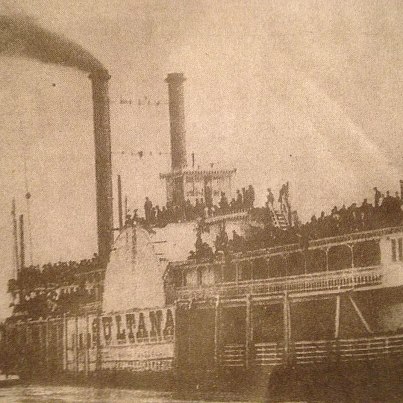
This was taken at a coal stop and then the steamboat docked briefly in Memphis then headed back out into the swollen flooded river. This happened just 12 days after Lincoln's assassination and for many it was on the back burners of consciousness despite being the greatest maritime disaster in United States history. The ship was only two years old and was frequently commissioned to carry troops. Three of the four boilers exploded it was reported. Jolly said he was faced with burning up or the river and chose the river. He was found the next morning hanging on to a floating piece of the boat.
Van Buren Jolley. Prisioner at Andersonville, Sultana Survivor , Editor of Mt. Vernon Democrat.....1865
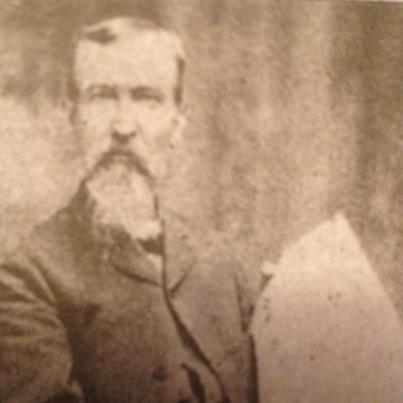
Before joining the Union Army, Van Buren Jolley had been editor and part owner of the Mt. Vernon Democrat, along with William Louden and Charles Legge from 1861-1864. He enlisted on March 21, 1864 and was at the Battle of Franklin and the Battle of Nashville. He was captured on the night of December 17, 1865 near Spring Hill, while pursuing the remnant of General Hood's army as they retreated from Tennessee. He received a saber wound to the shoulder. He was forced marched to Meridian, Mississippi and then transported by rail and boat to the Andersonville Prison in Georgia. As the war ended in the spring of 1865, prisoners were released and sent to Vicksburg where they were held at Camp Fisk and transported by rail to the Vicksburg depot and marched down Mulberry Street to the riverfront. The Sultana had experienced boiler problems and the decks were crammed with soldiers. Just after midnight April 27, 1865, her boilers exploded after leaving Memphis and passengers, animals and pieces of the ship were thrown into the waters. More than 1800 people lost their lives and only around 500 survived. After getting home to Mt. Vernon he eventually returned to the south, due to his health in 1880. He was editor of newspapers in Amarillo and St. Joseph, Texas, where he was elected mayor and finally at Noble, Oklahoma he died and was buried in 1898. He was 62. That means he was only 25 when he was editor in Mt. Vernon. Each year a reunion is held of descendants of those aboard the Sultana in Knoxville, Tennessee to commemorate that fateful day.
Confederate Money Flew From the Skies.....1865
In November 1922 the Western Star newspaper reported that W.H. Duckworth of Bufkin was in town and showed $50 in confederate money, two $20 bills and one $10 bill. During the Civil War Mr. Duckworth served as a member of Co. G, 91st Inf., with Captain Thomas Stevens of Mt. Vernon in charge. He saw service for three years in six battles and was doing provost duty in front of a bank in Salisbury, North Carolina, and picked up the money and it was still well preserved. Duckworth stated that could have secured as much as he wanted as the streets were literally covered being thrown from the banks after the town was captured. He was born near Farmersville and as a memento of his military service he had a finger amputated at the outer joint.
Civil War Survivor of Andersonville and Sultana Explosion In His Own Words; Part 1
I found something pretty incredible I think. Lieut. W. F, Dixon lived in Mt. Vernon after the Civil War and wrote a manuscript of his trials in the terrible military prison Andersonville and the explosion of the Sultana that he was traveling aboard after the war. The manuscript was never published in a major newspaper though other veterans wanted it done so. His daughter Miss Dixon did not desire to release the Andersonville, Ga. prison story for a long time. Eventually, in the 1930's, she gave it to our Major Geo. W. Kimball of Mt. Vernon and he had parts of it published in several articles in "The Public," starting on June 21, 1935. Here are some highlights: "When war was declared and Abraham Lincoln issued his first call for three hundred thousand men to assist in putting down the rebellion, I was living in Henderson County, Kentucky, and was farming with my brother. I was born in Indiana and believed it was right that the government should be upheld and the rebellion put down. I at once hastened to Indiana and enrolled my name among her loyal sons as a member of the Co. A, 25th Regiment of Infantry, then being organized in Evansville, Indiana for a term of three years. After being mustered I was sent to join Fremont and aid him in reclaiming the State of Missouri. The 25th Regiment was attached to Fremont's command about six months, when General Grant was ordered to organize his famous expedition against Fort Henry and Fort Donelson. I was joined in support of the Stars and Stripes by my father, and two brothers who enlisted in other regiments. We were ordered to Ft. Donelson on February 12, 1862, and after a three days hard fight we charged over the breastworks. I was severely wounded in this fight, and was furloughed home for a time and then I rejoined my regiment and later discharged. I then returned home and remained three days, at the end of which time I was offered a position as Sutler's clerk for the 91st Regiment. This was my father's regiment. He was sixty-five years of age, and served nearly three years. He was one of 'Sherman's Bummers' that marched from Atlanta to the Sea. I accepted the position as clerk and stayed with the regiment five months until my wound got well, when I returned I went back to farming with my brother. While farming there was a call for some cavalry regiment and I left my crops in charge of my brother and enlisted again for a term of three years in Co. A, 10th Indiana Cavalry. We were sent to Tennessee to do service in the vicinity of Pulaski. We had a three days hard fight with General Forrest's command. I was slightly wounded in this fight. We remained in that place until what was known as the Hood raid on Franklin and Nashville. At Franklin there was one of the hardest battles of the War. At Nashville on December 15, 1864 General Thomas attacked Hood's force and we fought three days. On the 17th I was captured at Hollowtree Gap, and stripped of my overcoat, blanket and hat, and in this condition started for Andersonville, through rain, snow and sleet, without a blanket to cover me. The Rebels stripped some of the boys to the extent of compelling them to go barefooted and in this condition marched them over snow and rough frozen ground until their feet became sore and frost bitten. They could not go any farther, and I never knew what became of them. Some of the boys rolled up their pants and marched barefooted, and the muddy roll would rub their legs until the blood would run down to their heels, so they could be tracked by it."
Civil War Veteran Marched to Andersonville. In His Own Words: Part 2
Continuing the story of Lieut. Dixon's story from his manuscript as told to "The Public" of 1935....."Just before reaching Pulaski about the middle of the afternoon and knowing that we would stop overnight there, Lieutenant Twigg and I asked permission to stop and see a family that we had become acquainted with. We were granted the privilege with a guard, after a short visit I proposed to my guard to move on and when I started I found it difficult for me to walk my feet were so sore. My guard told me to get up behind him and ride. I told him I was afraid the officers would not like it, and he said it was nobody's business, as it was his own horse. We had not gone but a few yards when a Rebel Major rode up and asked me what command I belonged to. I told him the 10th Indiana Cavalry. Whereupon he drew his revolver and struck me with it, ordered me to get down, and at the same time cursing me and the guard, telling me to sit still. I told the Major it was not right to mistreat a prisoner. After he was through cursing me he rode on. In conversation with my guard I learned his name (the guard's) was Henry Hoard of Union County, Kentucky. I was acquainted with his father by reputation and he knew quite a number of persons that I knew. Mr. Hoard was a gentleman and a soldier. We have communicated with each other through H. Pitcher of late years. I would tear my shirt into halves and give him both pieces. We stopped for the night in Pulaski. An old widow lady I knew while stationed there, sent her boy over to see if I was among the prisoners and if so bring me over to supper and for me to bring half a dozen of the boys along. I went to Captain Odem, and asked permission to go, and it was granted, a guard accompanying us. It was a fine supper. We had had but little to eat since we had been captured. Late in the afternoon of the next day we were marched out in a snow storm, and as night came on we marched off to one side of the road where the cedar bushes were bent down with snow. Here we camped for the night with no tent, no blankets, no covering whatever but the cedar bushes, and but little fire. Some of us were barefooted, and we marched back and forth through the pine swamps with but little to eat, our rations being from a pint to a quart of corn meal per day without salt and without sifting. We had no cooking vessels except one quart bucket. Fifteen of us had to use it by turns. I don't think I ate 25 pounds of anything else but corn meal boiled in water, and eaten with a spoon, yet I tell you even this was good. I saw the rebels passing by our camp with loads of corn, and they would break ears into pieces and throw them over into our camp, and you should have seen us running and wrestling for the corn just like starved hogs, and when a comrade got a half ear he was as proud as any person in this town would be of a 20 pound turkey. Yes, I said rebels, they were the hated kind, and if they had not been they would have thrown it over by handsfull. I obtained permission from Captain Odem to go get corn in a sack and divide among the boys a half ear a piece. This Captain Odem appeared to be a very clever man. Just before reaching Corinth he told us that we would all be searched and if we had any money or valuables and would hand them over to him he would return them next morning and I gave him ten dollars. When we arrived at Corinth we were not searched, and I never seen Captain Odem from that day to this. We have all heard of Yankee tricks, but I would call that a Johnny Reb trick. The time dragged slowly by. We had finished our long weary march of nearly five hundred miles through cold and snow with no tents, no blankets, no shelter, and found ourselves in Andersonville, Georgia, in the dead of winter, as the old saying is the City of Peth, where one lives and seven starve to death. No my friends, we felt utterly God-forsaken, and beyond the benefit of help or civilization. We now behold the most cruel sights that eyes of man ever witnessed....ragged, dirty naked skeletons with starvations staring us in the face."
Inside Andersonville...In His Own Words...Segment Three
Here are some vivid descriptions of Lt. Dixon's experience: " A short history of Andersonville prison consisted of about 17 acres of ground, a stockade built of logs over a foot thick, twenty-five feet long, a trench dug five feet deep, those logs stood on end close together, a walk built around it three feet below the top, so that the guard could see all over the prison, and there was a dead line which was certain death to anyone to cross. There were as many as thirty to thirty-five thousand men on this space of ground, and at times not much more than room to lie down. Our beds were Mother Earth and our cover the heaven above. No, my dear friends, I hardly know how to describe those horrors, and be decent in the description. We were put up like hogs without room, clothes or shelter, and but little to eat. Those who had been there for some time were most of them perfect skeletons without a shirt or coat on their backs. They were hollow cheeked and hollow eyed, and the loss of flesh showed their big knee joints. They did not look like natural human beings. Some had their feet frozen and one or both amputated. I attended a re-union at Enfield, Illinois, and met with a comrade that had lost both feet at Andersonville by freezing. He walked on his knees; his mind was not right and this was the case with a great many of those living skeletons. Hundreds of comrades died and were carried out and put into a pile, then loaded on a wagon and hauled off to the ditch and thrown in. You have often heard of tunneling out of prison. This is done by digging a trench under the ground large enough for a man to crawl through on his hands and knees. Dog trainers made a circle around the prison every morning with the hounds and if anyone had escaped they would be hunted to the end. Every morning we would hear the horn blow and then we could hear the hounds. It was equal to a fox chase. I saw a man who tunneled out three times and was captured three times. He showed me the scars where the dogs had bitten him; his legs and arms had almost been torn off. The officers, 65 in number, were placed in a small stockade sixty to seventy feet long and twenty feet wide. We were kept in this pen day and night. Once in a while they would let us out, but we were not allowed to communicate with the men. Here we are, rolling and tumbling in the dirt, ragged, dirty and lousy. Our hollow eyes, dirty smoked faces had not seen soap for months. I wish, my friends, you could have peeped in the prison doors; then it would not be much trouble to explain this matter here. We were fighting and scratching for life; we were constantly under fire with the inhabitants. I got an old kittle and gave my shirt a good boiling. When it dried I hadn't much of a shirt left. It took two of the best men in camp to put it on me. Comrades, we had such things as green backs and gray backs during the war, and I tell you now if gray backs had been money I would have been a millionaire. We formed a resolution that we would get out of that awful place at the risk of punishment, even to put our lives at stake......."
Inside Andersonville....A Local's Story....Segment Four
"We commenced a tunnel with the intention of liberating ourselves, and going among the comrades for the purpose of organizing and throwing the gates open and making a rush on the camp, capturing the artillery and small arms, let the loss be hundreds of thousands, as it might be; but it was rumored around that we would soon be exchanged and we stopped our work on account of punishment. At last the glad tidings came. Those sweet words came, I shall never forget them....'Fall in, Fall in line," and a dreadful looking line it was, crippled and drawn in all kinds of shapes from disease, some almost naked. They were as rough as mangy dogs. We were marched to the depot, and loaded on the cars en route for Jackson, Mississippi. We had three railroad wrecks in a distance of less that 65 miles. I was in one car that was mashed to pieces. I was struck a severe blow on my leg with a piece of plank. When we arrived at Jackson we had to march across to Vicksburg, a distance of forty miles, and it seemed as though it was over a hundred. During the last miles it seemed as if my shoes were screeching "Coffee beans, coffee beans." When we arrived at Vicksburg we all yelled and shouted when we sighted the old Stars and Stripes floating in the air. We felt that we were in God's country at last. It seemed that we had been gone from it for years, and it seems now in looking back that it could not be possible that we had passed through such an awful hell. When we went marching up in camp there was the grandest sight that could have possibly come before my eyes.....camp kettles full of pork and beans, beef and potatoes, hominy and rice, coffee and sugar, fruit and pickles, which our good folks at home had sent for benefit. You have all heard of the return of the Prodigal Son, but this was the return of Father Abraham's sons, and the fatted calf was slain and a grand feast was had of which good things we all partook. We were allowed to drink all the coffee we wanted, but we were guarded against eating too much. We were furnished with plenty of soap and a new suit of clothes apiece, and off to the river we went for a bath. We piled our rags in a heap and set fire to them. We all took a good bath and dressed in our new suits. I got a looking glass and took a good look at myself, and I thought I was one of the nicest looking boys in the whole Union army. I don't think I had seen my face in months. You could see the boys looking at themselves every now and then. Bedtime came and for the first time in four months I had a blanket, but I could not sleep. I had drank so much strong coffee I was too nervous to sleep. The first thing the next morning was to write letters home. We remained here long enough to receive answers to our letters, and then the President was assassinated, and Richmond was taken and rebel officers who were there to attend to the exchange fled for their homes and left us in the hands of the government. We were then ordered to Camp Chase, Ohio."
Boarding the Ill-Fated Sultana....1865....Segment 5
On April 25, 1865 the Sultana landed at Vicksburg. There were over 2000 prisoners of war crowded on board of her. She pulled out from Vicksburg for Camp Chase. In a short time we had lost sight of Vicksburg and were gliding along at a merry rate, the boat making her usual stops up the river. We were all talking of home and friends and the many good things we would have to eat. We consoled ourselves that we had lived through it all and were now in the land of the free. There were a great many sick and afflicted on board and I went to the captain and asked him if he would furnish soup for those men. He said he would. Sometime in the fornoon we stopped for a short time. While here a photograph was taken of the boat with her mass of prisoners aboard. After leaving we headed for Memphis. At Memphis the boat unloaded some freight and took on a supply of coal. Night soon came on and I gave those sick comrades their supper and bid them good night for the last time. Vey soon we were all sound asleep and dreaming of home. It was past midnight and while the boat proceeded on her way up the river about two o'clock, ten miles above Memphis her boilers exploded and over seventeen hundred lives were lost in less time than it takes to tell it. I was lying on the crowded cabin floor and the floor did not blow up quite as far back as where I was sleeping. A sudden jar threw me across the boat, hurting me in my breast and I heard someone calling out that the boilers had blown up and the boat was on fire, and now the thought that rushed through my mind for a moment as I stood on the cabin guards gazing out on the rough cold waters was of the long months that I had struggled for existence in prison, of the friends at home waiting to receive me, and now that I must die an awful death. The river being so high, the waters so cold, the night so dark and the boat now on fire made the chance for safety doubtful to the extreme. I did not have the slightest idea that a single soul would get out alive to tell the story. I saw that I must make a choice of one of two things....either burn to death or drown. I preferred the latter. All now was confusion on the boat. I could see fire and hear groans and screams and see men jumping into the river by the hundreds, hanging together in clusters and going under, for ever so many of the poor crippled and scalded comrades would drag themselves to the side of the boat and dropping into the cold water disappear from sight, many were fastened in the debris of the boat, and soon perished in the flames. Tongue could not describe the agony and confusion at this time. I secured two strips of plank, and watching a chance to jump in as near to where I stood as possible; and when I went under and came up I had lost one of my planks. I turned my face from the dreadful scenes and began looking for shore.
Fighting for Life ...Final Segment of Lt. Dixon's Quest to Get Home.....1865
I could see nothing but darkness and I turned my head and thought I could see the light shining on the willows at quite a distance. I made every effort in my power to reach it but failed. I soon lost sight of everything but darkness. I could hear men halloring and crying in every direction. "O Lord have mercy." They would strangle and that was the last of them. Some did reach the willows and chilled to death, hanging fast to the limbs. There were several of those little islands. They were called Paddy's hen and chickens by river men. The Mississippi River was overflowed five miles wide. I heard water roaring against timber and drift piles. I again made an effort, but with no success. I now resolved to paddle along slowly, to not overdo myself, for of course I did not know in what direction to go. My mind was wandering and it seemed like everything was becoming blank. Here is the mystery and is until this day. It seemed like a dream. It was getting light and there were two men pulling in another man at quite a distance and when they shifted their oars they made quite a noise, and it aroused me and I saw that I was passing by Memphis a distance of 11 miles and the bank was plain to be seen on the other side, and I just had strength to call and they came to my rescue. They took me back to Memphis, and at the wharf there were two boats lying side by side. One had hot fire in the furnace and there was a comrade that helped me to the fire and threw an old coat around my shoulders. The hospital nurses came around and gave me a glass tumbler half full of whiskey. I told them that was too much. They said it would not hurt me, so I drank it, and it was not long until I was hot inside and out. I was given clothes and the first thing brought to me was a pair of red flannel drawers. I was taken to the hospital in this condition. I was very poorly for several days and could not stand on my legs. After a few days me and my comrades were ordered north. We were loaded on another steamboat and she caught on fire and came near burning up. Finally the boat landed at Cairo, and we took the train by way of Mattoon, Illinois, and Indianapolis. At Mattoon there was a grand dinner at the depot for all. When we arrived at Indianapolis we were stopped by that great and grand old Governor O.P. Morton, and he told us to go home for ten days and then report back to him. The regiment returned to Indianapolis whereas the war was over we were mustered out and Johnny came marching home again. In conclusion, we do not wonder that so many died, but we do wonder how so many lived. We point with pride to those 60,000 graves, and say: "Those comrades chose the most cruel death rather than dishonor their country's flag in any way, and under the most trying circumstances, naked, striving and racked with pain and disease, with certain torture and death staring them in the face they refused offers of relief by enlisting in the rebel army or working in their shops." My dear friend, after all this suffering and privation and loss of life, what have we today in return? We have that grand old flag without the loss of a single star.
"That Ain't Funny!".....1864
About two or three miles north of Mt. Vernon, Mr. Charles Allen was on his way home from Evansville with his wife in a two horse carriage. A man from Mt. Vernon stopped him and told them that the rebels were sacking Mt. Vernon and that he had better hurry home and look after his property. He raced all the way home and on reaching his farm...both horses dropped dead. The man had lied, thinking he was playing a good joke. Allen brought suit in court against him and obtained a tidy sum for his team and distress.
Civil War "Hospitals" Said To Have Been In Mt. Vernon.....1864
According to "A Document History 1815-1900 Volume 2 by Carroll and Gloria Cox two hospitals existed during the Civil War. One was located in a old hotel near 2nd and Main and another at 10th and Main. The one on 10th street was the old County Seminary Building that was razed in 1878 for the Main Street School. Here many wounded from Shiloh were taken. Also, Camp Link was said to have been located near the RR station on Main Street. I wonder at the conditions of these temporary hospitals. I would imagine the field hospitals would have done most of the amputations. Sickness killed so many soldiers. I wish MV had papers that still existed from that time. I need to check out some Evansville papers one day. Memorial coliseum was used as a temporary hospital by the Red Cross during 1937 Flood. Cots were put in basement. I found them today at the Historical Society in the said volume. I don't have the page number but could be found easily in the Civil War section. I had heard previously of the hospital at North Main and 10th street, but not the other one. Camp Link has had me confused several times. I have read of it in two different areas and heard of it in a third.
Earliest MV Democrat Ever Found Has Article on Lincoln.....1864
Our weekly Democrat has on its banner that it was founded in 1867. Maybe, maybe not. A copy of a Mt. Vernon paper of November 12, 1864 was found by the Bouslog Abstracting Company in its search through archives at the Posey County court house. This Democrat was printed by C.S. Legge with an office on Main Street over C.F. Leonard's Store. The lead editorial of the issue deplored the re-election of Abraham Lincoln as President, closing with the paragraph: "the nation has chosen despotism and we do not intend to oppose its choice. If they can stand it we can." News articles basically had to do of the war and a list of advertisers was a plenty. A few were the hotels of the Flower House where the Hominy Mill would stand in the future, the Nelson House on the corner of Water and Store (now College), and the Union Hotel at the corner of Main and Second. Some advertisers were the Mt. Vernon Marble Works, Tailor Nicholas Joest, Henry Leunigs Grocery, Chappell and Company Drug Store, Gamble's Millinery, Fuhrer's Saloon, Wolfe's Saloon, Spear's Music Store, Rosenbaum and Brothers Dry Goods, E.B. Schenk's New Grocery, Emanuel Wolfe's Grocery, Springer and Huber's Lumber Mill, Hout's Cabinet and Coffin Firm, Wilson's Ornamental Painting Shop, Test's Clothing Emporium, Wilson's Dry Goods, and Willis' Photograph Gallery.
Hovey's Raid.....July 1862
Not everything or most of what happened there is known. Mt. Vernon shifted some five pieces of artillery (cannons) about our riverfront feeling threatened. "A company of Home Guards from Mt. Vernon and vicinity crossed the Ohio River to repel the rebels who were threatening Mt. Vernon, says the Committee on Safety Notes published in "The Public" in 1935. No later data was available of this movement. As late as July 26, 1862, Governor Morton ordered two companies from central Indiana to Evansville, one of which was Company A, 78th Indiana Infantry, which proceeded to Uniontown to repeal Colonel Adam Johnson's battalion of rebel cavalry. The Union force was composed in part of 60 men under Colonel William Farrow. Of the Union force several men were killed and wounded and the force was completely routed according to reports. "The town of Mt. Vernon was intensely excited at this time." Scouting parties were patrolling the river front of whom one was Joseph F. Welborn, who hearing of the firing across the river in Uniontown, rushed rapidly on horseback to announce the presence of fighting and as he crossed the old wooden bridge across Mill Creek, he shout, loudly, "The rebels are coming! The rebels are coming!!" Of course, Mt. Vernon prepared for the worst, but the rebels didn't come. That ended the saga of the Home Guard....we were never attacked. I have a list of the names of the guard, but it is too lengthy. Some surnames are : Hinch, Wilson, Black, James, Freeman, Jenkins Lauglin, Thomas, Roser, Morlock, Lictenberger, Mills, Haas, Leuring , Williams, Server, Templeton, Duckworth, Klenk, Culpepper, Russell, Thompson, Reeves, James, Muggie, Noel, Koerner, Zimmerman, Pearse, Witworth, Grabert, Finell, Seat, Bacon, Rowe Curtis, Woody, Schurer, Allen, Reifner, Quick, Meyer, Rosenerans, Reis, Mackey, Server, Weisinger, Smith, Dill, Fisher, Donivan, Redman, Burnett, Oatman, Willis, New, Boyce, Schneider, Alldredge, Von, Tinley, Lewis, Knowle, Gurch, Blochly, Burtis, Mann, Pitcher, Edson, Nix, Lockwood, Newman, Showers, Gardiner, Nettleton, Chaffin, Dieterlie, Welborn, Barter, Drylen, A.P. Hovey, Lennig, Craig, and Leonard.
Young Volunteer.....1862
In 1862, 13 year old Eugene Beal of New Harmony ran away from home and enlisted in the Union Army, joining the 161st Illinois Infantry, Co. K., and served until three years after the war. He died at age 83 in Stewartsville.
August.....1861
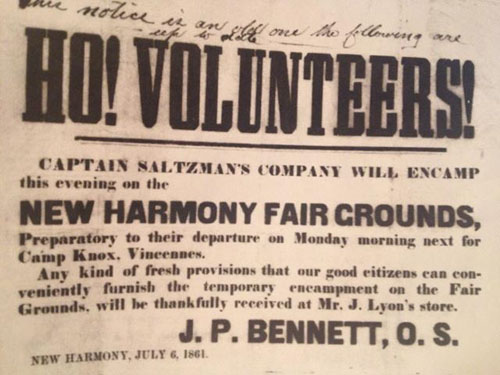
The first full companies of men from Posey County were in the 25th Regiment of companies A and F mustered into service on August 19, 1861. George W. Saltzman of New Harmony was the captain and Enoch Randolph of Mt. Vernon was the First Lieutenant. Captain Saltzman was killed at the Battle of Shiloh April 6. 1862. James P. Bennett shown on the flier died and three days following his promotion for Captain came through. Of the original 100 men, 32 died or were killed and 4 deserted.
Fourth of July in New Harmony During the Civil War....Independence Day 1861
"One year ago we were a peaceful happy nation; today we are a warlike people doing battle on our own soil in defense of those liberties which we were bequeathed to us by men whose deeds cause the Fourth of July to be in all times. The morning of the 4th has come upon the nation arrayed as it never has been before, and we severely trust as it never will be again." ...New Harmony Advertiser. "Amongst the gloom which overshadows the country we enjoyed the blessings of our Constitution. After partaking of a most excellent dinner arraigned at Woods Grove, washed down with bumpers of lemonade, we drank toasts and found amusements in the dramatic arts prepared by our Thespians and their love of drama."
Robert Dale Owen Speaks With "Honest Abe".....July 20, 1861
Owen traveled to Indianapolis and he was charged with the duty of purchasing arms for the locals. "The 160 carbines are all breach loading, manufactured in Providence, Rhode Island and the 300 Sharp weapons were made in Connecticut. The carbines both Burnsides ad Sharpes are beautifully finished arms doing credit to New England mechanics. Either can be fired from ten to fifteen times a minute with an effective range of 800 to 1000 yards. I had an interview at some length with the President and another with the Secretary of War. The President, as you probably know spent a considerable part of his youth in Spencer County, near Gentryville and has not, I assure you, forgotten nor ceases to take an interest in the scenes of his youthful days. I sketched a plan for him on placing a regiment of cavalry throughout our border counties."
Governor Has 60 Muskets Delivered to Mt. Vernon.....May 1861
From the meetings of the Safety Committee (Home Guard), 60 muskets were secured from the governor and they were hauled down to the jail to be stored for distribution. Muskets already in procession of Captain Koch's company were delivered to the Mayor and kept at the Court House. A plate of sheet iron was placed over the grate in the door of the cell in which the powder was kept and over the ventilation hole in top of the cell. The Mayor detailed 15 men every night to watch the town, and of this number one would watch the Public Square.
James Jolley Writes Home to Brother -in- Law about Life in Mt. Vernon.....1861
James Jolly was the father of Van Buren Jolley, Sultana survivor. James moved his family to Posey County in 1853. In Mississippi, James had been sheriff and tax collector in Covington County, MS but came north to join his uncle, Maxey Jolley , settlers at Stewartsville since 1804. Maxey was a blacksmith and helped build the first church in Posey County. He is buried in Jolley Cemetery in Robb Township. In the letter he writes: "I live in a fine country. It is the most productive country I ever saw. Corn, wheat, oats, barley and rye are raised in abundance. We are up here divided in the political topics of the day. We have Douglas men, Breckenridge men, Bell men, and Lincoln men. I took the side of Breckenridge as his view regarding slavery in the territory were exactly mine, which were formed and expressed in 1850. Notwithstanding all this I think the South has acted rather prematurely, but as she has done what she has, I now say for her to go ahead, and if the Southern States for a Southern Confederacy there will be a new state formed out of the southern part of Indiana and Illinois which will go with the South, as our interest on the many streams are so closely identified with the South. If they cut us off from the navigation of the Mississippi and Ohio Rivers we are then ruined. The South wants our corn, flour, bacon and other products of the soil, and in return we want their sugar, molasses, rice and cotton." It must have been heart wrenching to see his son become a sergeant major of the 10th Indiana Calvary and fight against family.
Big Government, High Taxes....Dems?.....Nope... 1861
In a desperate need to find revenue stream the Republicans adopted an income tax to levy to pay for the Civil War in 1861, 1862, and 1864. During the congressional debates the Republicans argued that "a tax properly levied, upon incomes is an equitable and just tax." Some favored a graduated tax on the wealthy that benefited the most and thus needed to give more. My, My, My. Individuals who made more than $10,000 per year were to pay 10% in income taxes. Oh my! The Chicago Tribune said, "The rich should be taxed more than the poor." Oh goodness me! After the war the tax lapsed in 1872, but the Democrats for decades labeled the Republicans the party of high taxes and big government."......These quotes come from the book, "The History of the Grand Old Party by Lewis Gould and published by Random House in 2003. The Republicans championed the largest expansion of the government's role from our nation's history to that time. There is no doubt that the reinvented Whigs were on the right side of the historical argument and their opponents were not; however, those who now believe in limited government separate themselves from their own founding traditions of their party.
More Guns For Home Guard.....1861
Somehow 60 more guns were acquired from New Harmony and put into rooms in the E.R. James residence, free of charge. Each member of the organized company was to have a gun and 24 rounds of cartridges and the necessary amount of caps.
The Dan Rice Show is Back...September.....1860
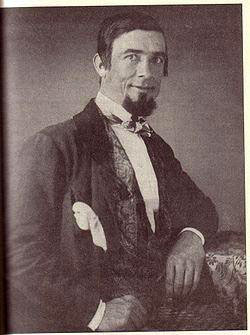
The man who coined the name "One Horse Show" was back in Mt. Vernon. He had a good rapport with our citizens before the Civil War. One man called him...."The most famous man you never heard of." He was very popular, even ran for President in 1868. In 1851 he came to Mt. Vernon like he always did and found a rival circus here also, He was allowed to pitch his tent on the northeast corner of the Public Square and people came in droves...so many that the tent sides had to be opened to accommodate all who came. Rice was very impressed with our loyalty that later he built a 50 X 120 food market house for us to be used as a farmer's market. A large sign bearing his name was at the entrance. The market place was used in 1861 as an armory for newly enlisted Union soldiers according to "Pop" Fessenden. The market place was torn down when the new court house was constructed in 1876. So here was a popular national clown, an "Uncle Sam" sort of character thanking Mt. Vernon for coming to see his elephant walk, his tight rope act, and his talking horse. The man with the baritone voice was once the highest paid performer in the nation. I would have loved to have seen his parade of zebras, giraffes, monkeys and bears walking down Main Street!
Robert Dale Owen Speaks to Marchers in New Harmony.....August 1860
Flags appeared in New Harmony, some for Lincoln, some for Douglas and at least one for Bell for President. Supporters of Douglas, who won Posey County, marched in a torchlight procession through New Harmony....every street and led by a brass band to the home of distinguished former representative and socialist, Robert Dale Owen who gave a short speech. Owen spoke of a common free school system and widows having control of their property. There were "3 cheers" for the speaker and "3 cheers" for Douglas. Owen, a Democrat, differed from most Democrats, at least those in the South by urging an end to slavery. He wrote a letter to Lincoln in 1862 saying as much and part of the 14th Amendment he molded though modified.
MV Advocate Editor....Upset at Evansville.....July 1860
Mr. Posser, of Mt. Vernon's paper, "The Advocate," wrote an article on his Independence Day celebration in Evansville. He took the occasion to denounce its citizens of having any lack of hospitality towards strangers. Rumors were spread through town that it wasn't actually the citizens of Evansville he was upset with, but a saloon-keeper who refused to let him have five drinks of whiskey for 40 cents. "Times get rough when you ain't got enough."
Knights of the Golden Circle May Have Held Secret Meetings Near Cynthiana.....1860's
There was once a log cabin that stood not quite 2 miles north of Cynthiana that had a interesting history. It was rumored that the Knights of the Golden Circle met there while the owner was away in the Union Army during the Civil War. Some say the lynching in Mt. Vernon of Negroes in 1878 bore the trademark of the Golden Circle. This log cabin also housed many books...in fact it was said it was a early library called, the "Black River Library." When the Union soldier came home from the war the books were moved and the log house was abandoned. The years have cycled on and on...many truths are lost only rumors remain. I wonder if the books may have ended up in New Harmony at the "Working Men's Institute?" The books at Cynthiana were called the "Working Men's Association, Black River, Indiana, organized January 29, 1857. I think the New Harmony Institute started in the 1830's and it would only be natural that the books would have been taken there.
Fear of Lincoln Assassination Abated.....1860
The New Harmony Advertiser reported: "On Monday, Mr. Lincoln was inaugurated President of the United States and although many rumors were afloat concerning what could be done to prevent the ceremony he got through it without any bodily harm. We were led to expect he would be murdered, assassinated, shot at, stabbed, scalped, and a thousand other things. Where was that man among 500 others, who was to shoot the President while delivering his inaugural address?"
Filling Out That Census Form.....1860
The Civil War would be starting soon and by May of 1860 the federal government sure was asking quite of few questions on the census forms. The usual age, profession, name, marital status, race or in this case color, siblings, address, etc. That's not all they wanted to know...are you an idiot...no kidding or if you were blind, deaf, dumb, insane, pauper, or a slave. If you were a farmer they wanted to know your livestock, your implements, how many animals you slaughtered, the bushels you harvested, the pounds of cheese produced and the gallons of bees-wax. They sure were nosy. I imagine the Yankees learned a few things about the Rebels from these facts prior to the war. In all they found 31,443,321 in the United States and 3.9 million slaves. I guess they weren't counting them as 3/5th's of a person just yet.
Princeton Editors Fight like Mt. Vernon Editors it Seems.....1860
The Princeton papers were having a personal quarrel. The editor of the Indianan called the editor of the Clarion a "dirty lying contemptible puppy," and the Clarion responded with calling the other's paper a "nose rag."
Paving.....1860s
From what I can gather the streets of Main and Store were macadamized in the years 1859-1862 for the first time. Special tax levies were installed for this expensive process for the benefit of our community. Three contractors were used: F. Schenk, A. Galliger, and Jean Febre.
1850's
Resident Looks at Mt. Vernon in 1854
During the 50th anniversary of the local Western Star newspaper, Mrs. Emily Rosencrans looked back 72 years to when she first saw the "beautiful little village of Mt. Vernon." She called us a picturesque little town situated on the bank of the Ohio River and was charmed by the impression and it remained with her all her life. "Northeast of the L&N depot was dense woods. All lots now in the corporation limits down to Fourth Street were in the woods. East of Fourth Street blackberry bushes grew plentifully. The luscious berry could be had without going far for them. School children would roam over the woods looking for gum wax found on gum trees, the only wax obtainable, as chewing wax was unknown. Woods extended all along to the White bridge, and then it seemed a long way off. Houses were few and far apart, none of note on Water Street until the Flower Hotel came into view, which stood where the big mill now stands. Mr. and Mrs. Flower were tall and commanding in appearance. Mr. Flower with his large brass ear trumpet, and Ms. Flower with her snowy white turban high on her head, caused one to look twice. The friendly grasp of the hand and the cordial greeting at their hotel, their house discipline was fine. The cuisine was all one could wish. Their kindness and hospitality to visitors, patrons and everyone else made them exceedingly popular. Mt. Vernon had two hotels at that time, the other one, the Nelson House, stood where the Water Works stands or near there. The transportation to and from Mt. Vernon was by stage coach or boat. Packets made trips up and down the river for the accommodation of the public. Oh what a beautiful sight to see one of those steamers laden down with passengers, painted snowy white, glistening in the sunshine (Queens of Beauty) , the Negro deck hand singing jubilee songs, filling the air with melodies. Time that conquers all things. The wheels of progress have been going on. Now we have railroads, telephones, electric lights, water works, four big mills, five schools, eleven churches, memorial building, armory, court house, fine business houses, straw board plant, and fine residences all over the city."
Yellow Fever Death in New Harmony.....1853
New Harmony avoided the chorea epidemics that Mt. Vernon had in the 19th century, although there was much travel between the two towns. Yet, at one time, in 1853, there was a case of yellow fever brought there by a man named Ferniman, who had been to New Orleans where the scourge had been raging. The victim lies at the foot of the hill as one enters Maple Hill cemetery on the right. Later, George Warren wrote his account of the incident: "It was about six P.M. one evening in the summer as I was going home when the stage drove up to the post office and I saw the only passenger was Mr. Ferniman. I shook hands with him and told him I was glad to see him back from the afflicted city of New Orleans, which was then being swept by the yellow fever. He, I could see was looking very ill, and although the weather was warm, wrapped in a cloak, closely around him. He said, "George, I am a sick man. I can assure you. Goodbye, I am going to Mr. Fretageot's." He was put in a very best room and was growing rapidly worse and died about 2 1/2 hours later. In the meantime our band had met for drill and just about ready to begin when a messenger came to tell us that Mr. Ferniman was dead. Mr. Prichard, Ance Hamilton and myself at once went to Mr. Prichard's shop and we soon made a nice coffin of walnut, after which we were joined by Fred Lichtenberger, and Mr. Bishop. We made two lines to carry the coffin as to not touch it after the body was put in. We went to the Fretagot residence to place the remains in the coffin. We did not dress the body, but Dr. Mann and another of the party took the sheet, one at each end, twisted it tight and placed the body in the coffin. I put the coffin lid on and it was nailed down by the three of us. It was then two o'clock in the morning and a gruesome procession it was. When we got to the grave we found that it had been dug five inches too short. The digger swore it was bad luck to re-enter to dig more but with stimulants supplied as a nervures, it was completed. After the burial was over we all went home, very tired, as it was near daylight. For about three weeks after the funeral, we who had been close to the remains were very much shunned by passersby."
1840's
Whigs and Democrats Go At It in Cynthiania.....1844
The first barbecue ever held in Cynthiana was really a place called New Union, about four miles from that town. James K Polk was the Democrat and Henry Clay of the Whigs were the candidates for President that year and having no real amusements at that time to do, the men, women and children soon became partisans in a political battle. You see the main issue at that time was the annexing of Texas. Polk was all for it and Henry Clay said no. I somehow feel aligned to the Whig position on this one. LOL. The men started fighting in the open streets, there being no Marshall or arm of the law to make them afraid of and all. The women bitched at each other on either side of fences and the little boys were whipped by their parents for singing the wrong party songs. All this violence stopped for a while until news came of Polk's election. Great bon-fires blazed in public areas in celebration. It was decided to have a barbecue at New Union. There were then 26 states in the Union so 26 young girls were chosen on account of their good looks to represent the states and they were requested to dress in white and to ride white horses to the barbecue, all save one. That one was a beautiful brunette and she was asked to dress in black and ride a black horse in the procession and represent "Little Rhoda," which had done something during the presidential campaign to displease Democrats. I have been unable to find out what that was; anyway the day of the barbecue was bright and clear. The twenty-six young girls, rejoicing in their beauty, drew up in front of the public square to wait for the procession to form. The Whig boys were excluded and not invited to the big shindig and they stood back and boiled. Here were some of their sweethearts being escorted to a luncheon by their Democratic rivals and they didn't like it one bit. It was rubbing "salt into their wounds." When the whole thing was over there were more bloody noses and blackened eyes than had ever been seen before or since in Cynthiana.
1830's
Fight Breaks Out...Man Killed in New Harmony.....1838
Joseph Lynn, was a black man, called a "desperado" at the time. He was employed at a flour mill and distillery of William and Richard Owen. There was tension in the air between bands of blacks and whites it seems and one day a fight between Lynn and a noted white fighter John Webster occurred. The group headed by Lynn left and returned shortly armed with knives and pistols. Dr. Mann of Mt. Vernon and John Webster were approaching when Lynn allegedly fired at the two men with his weapon filled of nails, and slugs of lead shot. The two men were badly lacerated but were not fatally hit. Lynn was later found dead from "nasty ghastly cuts." Webster was arrested but no evidence was introduced and he was discharged.
William J. Lowry...Builder of Robin Hill....1830's
Lowry was an early pioneer in Mt. Vernon and was involved in the grain and pork packing business sending goods to the south. He first came into prominence in 1825 serving as the Justice of the Peace and he helped liquidate the Springfield court house when it was moved to Mt. Vernon. The court house and jail were both sold. In 1826 he was Captain in the 26th Regiment and in the 1830's built the house, then known as the Lowry House and later called Robin Hill. He was a participant in the famous "Hoop-Pole Fight" at the riverfront in 1834. In 1836 he was contracted to build a clerk's office on the public square at a cost under $3000. From 1840-1844 he was County Treasurer and in 1851 he purchased land that became part of the city from Mill Street to Store and from 8th to 10th. By 1857 he was so wealthy he bought the First Bank of Mt. Vernon. By 1857, Robin Hill became the home of Edward Sullivan and he named it "Popcorn Hill."
Prince Maximilian of Wied-Neuwied Visits New Harmony.....1832
Prince Alexander Phillip Maximilian 1782-1867 was a German employer and naturalist, the grandson of a ruling King. He was in the Prussian Army during the Napoleonic Wars. He led an expedition to Brazil from 1815-1817 and found the tribe of the Botocudos. In 1832, he traveled to the United States, including New Harmony where he spent one winter collecting specimens of flora and fauna and studying the cultures of the Native American tribes.
"Wild Man in Kentucky"...New Harmony Disseminator Newspaper....March 1831
"Five or six days since my business called me to Danville and thence to Harrodsburg. While descending the cliff on the north side of the Kentucky River, I very unexpectedly encountered a being whose strangeness of visage inspired me with the most horrible sensation. When I first saw him, he was lying on the ground, his tail tied to a limb of a tree, about twenty yards distant. I would judge it to be almost 30 yards in length and almost the size of a bed cord. The trampling of my horse's feet startled him and he bounded to the tree, climbing up by his tail, which as before was tied to the tree. Recovering from my confusion, I advanced nearer the tree, where I surveyed his whole appearance. His head was of the proper dimensions and his hair was long and flowing, reaching exactly his waist. His one eye was white and the size of a silver dollar in the middle of his forehead. His body was covered with hair and feathers, and his feet resembled those of a bear. He skipped with the greatest agility from limb to limb and muttered some unintelligible words in a harsh tone. Whilst he was intent on gazing at me, I rode around the tree about four times, his head turning each time with me. When I stopped his head was still a moment, when it wheeled with great velocity of a top until it resumed its former position. Seeing him almost descend by means of his tail, I put spurs to my horse and reached the ferry greatly terrified and nearly out of breath. The above statement is sent to you at the request of my neighbors who will certify to my good character, having resided with them for 19 years. " ....Patrick Floory.
But How Many Horses and Bayonets?......1831
The Army from a report of Major General MaComb, it appears that our United States Army at that time consisted of 6186 men of which 546 were commissioned officers. Alexander MaComb was a hero during the War of 1812 and like Ike he never actually came under direct fire from the enemy. He went on to write books on martial law and codes of conduct.
A Story of "Johnny Appleseed"....Right Here in River City.....Early 1830's
Back in the 1930's, local historian Vernon Posey published a story in the Western Star newspaper of "Olden Times in Indiana.' The story goes that the first keelboat built giving performances on the Ohio River was built by a Mr. Ludlow in 1817. It was named, "Ludlow's Noah's Ark." Some credit this as the first showboat. By 1827 a more significant actor and boat appeared in our area. It was run by an English born actor, named William Chapman who launched the "Floating Theatre" in Pittsburgh Pa. The Chapmans became famous playing river towns, including Mt. Vernon. Posey describes him as the "Clark Gable of the early opera boats." Now here comes another Chapman....Jonathan Chapman, aka "Johnny Appleseed." Johnny was well respected in these parts, barefooted and soft spoken. He was liked by the Indians and received in their lodges and was spared when they were at war with the white men. Jonathan read the Beatitudes to the frontier families beside the cabin fires and showed his love of nature, especially flowers and trees. In his journeys his favorite was the simple apple tree. He envisioned great orchards of these trees everywhere and he planted their seeds to make this possible. Jonathan was in his 50's or early 60's now when he came into town and saw that William's boat was tied up at our wharf. He had asked for lodging with a resident, just as they were leaving for the show. He consented to accompany them. They were late in arriving, probably paying their fee with 50 cents or a peck of veggies. They took their seats unnoticed. Shortly after, Johnny became restless and squirmed and fidgeted. He wasn't comfortable as he changed his position several times and finally spoke aloud, interrupting the show. All eyes were upon him and they were filled with contempt and disgust. Suddenly, the white haired old gentleman was recognized as the kindly old gentleman who had been a welcome caller at their campfires. A stampede took place across the floor to welcome him and shake his wrinkled leathery hand. The show was forgotten. The next trip down the river, William Chapman printed on the side of his opera boat..."The Apple Blossom Floating Theatre."
How Could Anyone Ever Think This Was Right?.....1830
As reported in the New Harmony Disseminator......"A decision in a New Orleans court makes it legal for a white man to shoot at black children for $200 a shot provided that he only wounds them and doesn't kill them." Like Malcolm X once said, "Our nation was born in genocide when it embraced the doctrine that the original American, the Indian, was an inferior race."
1820's
Anarchist Moves to New Harmony to Join Owenites.....1820's
Josiah Warren was born in Massachusetts in 1796 and he is known as 'America's First Anarchist." He was editor of a paper out east called, "The Peaceful Revolutionist", and it was the first anarchist paper in America. In 1821 he moved to Cincinnati and worked as a orchestra leader and made some inventions. By 1825 he became aware of Robert Owen's group in New Harmony and tossed around a idea of starting a communist colony in Ohio. The group had differences and he couldn't wait so he sold everything and moved to New Harmony in early 1825. He stayed about two years and thought Owen's experiment was communism and he didn't really like it as much as he had thought. He moved back to his home state and tried twice to start utopian societies based on free love, human rights, and sovereignty of the individual. We don't do that much anymore. Anybody want to join my group?
Anarchy in the Classroom....Point Township 1820's
It seems that a tradition arose locally where on major holidays like Thanksgiving and Christmas the school master was obliged to treat the students. Somewhere in Point called the Alldredge settlement a teacher chose not to do so. The rough farm boys erupted and carried the teacher, a Mr. Gages to a nearby pond, broke the ice and dipped him under a few times hanging onto his ankles. His shirt was removed and chunks of ice were put on his chest......the teacher was finally rescued and no doubt he gave consideration to a new career.
Free Negroes Kidnaped West of Princeton, In.....1822
Two black men came to what became Princeton, Indiana looking for work. They were hired by General Wm. Embree to work on his farm which was a few miles outside of town. They were good hands and worked the farm for two years living in a small log cabin doing their own work too. One of the two men could read and write and he borrowed books from people in Princeton. When the work season was completed they spent most of their time hunting for game which was abundant. After the second summer was over, the men did as always and went out to hunt. One morning someone found tacked on their cabin door a note saying they had gone to the Ohio River to cut cord wood and that was the last time they were seen. Years later General Embree was in New Orleans and found the two men working on the levee, rolling freight. They told Embree that two men whom they had seen several times in Princeton came to their cabin early one evening and handcuffed them and by the next day they crossed over on a raft to Kentucky, going down to Henderson. After a few days a boat came and they were sent to New Orleans and sold into slavery. Embree went to a lawyer and told the story but the investigation found that for three years the Negroes had been the property of two men named Absolom Tower and Thomas Slaven and there had been no complaints of ownership. The judge refused to release them.
An Indian Long House and Audubon in Mt. Vernon.....1820
Long ago, historian Vernon Posey wrote of our small village here on the Ohio that became Mt. Vernon. We were a community of small log cabins, winding footpaths through the forest and many and growing tree stumps. The heart of our town was west of Mill Creek with woods and north of Fourth Street which was pasture. McFaddin's Creek was still full of river pirates and Harrison Street, which became Main Street had but one store, a supply store mostly for boat people near the levee. Around what became Mulberry Street were a group of homes, a log church, and a log school. Also there was one more thing at the top of Mulberry Hill....an Indian Long House. This old relic was covered by leaves and made of hoops and here Native Americans snuggled beside fires in groups. Maybe they were Miami, Shawnees or the Wyandotte, I don't know but this structure was impressive. The length of it is not recorded, but many went over 100 meters and usually had doors at each end covered by animal skins. It was here in October 1820 that Joseph Mason and John J. Audubon were hunting to supply boat crews with game as they passed down the river. They had hiked along McFaddin's Creek and bagged some rabbits and a bunch of wild turkeys. They came upon Mulberry Hill , knocking off a few more rabbits along the way. Young Mason, just 13 wanted to see the house, so they climbed the hill to check it out. At this time Audubon, 35, was penniless and had not found his place society. As John stood in the darkness of the long house he was said to have been in despair, yet he could see through the exit the bright sunshine and woods. His woods! He stepped out with determination in his heart. He killed many animals here and had taxidermist locally stuff many of his items he later drew.
Judge Pitcher Loans Lincoln "Blackstone's Commentares on English Law"....1820's
Lincoln had very little of a formal education, barely a couple of years. Where did he get his knowledge? Who influenced him? The answer is he learned from individuals who could furnish him books and inspiration. One of those men came to make Mt. Vernon home and is buried up at North Cemetery behind the old high school and Hedges Central......Judge John Pitcher. Lincoln had a quest for knowledge and he borrowed according to John Breckenridge's biography, "Lincoln" his first law book, "Revised Laws of Indiana" from Dave Turnham, justice of the peace near Grandview, for whom he worked. Although not mentioned by Breckenridge....Pitcher a resident lawyer in Rockport loaned him "Blackstone's Commentaries on English Law." Pitcher's granddaughter, Mrs. R.R. Schultz (Kate Pitcher Whitmore) of Mt. Vernon had a letter dated April 14, 1866 written by General Thomas Gamble Pitcher to his father and it tells of a conversation on a crowded train where he was sandwiched between President U.S. Grant and Senator McDonald. The senator asked: "President Grant, do you know that General Pitcher's father loaned Mr. Lincoln the first law book he ever read?" Pitcher was born in Watertown, Connecticut about 1794. His ancestors came from England and were early settlers in the New England states. At 17 he entered law school in Litchfield, Conn., housed in a cottage in the garden of Tapping Reeves, an eminent American lawyer and jurist, from whose school graduated such legal minds as Aaron Burr, John C. Calhoun and other prominent officials. Pitcher became a member of the bar in 1815 and married Eliza Gamble, a sister of Commodore Gamble of the U.S. Navy. In 1816 they moved to Rockport Indiana to practice law. His circuit on horseback covered wide territory and visits to Mt. Vernon influenced him to establish his home here and law office in 1830. He loved our town so much he refused an appointment to the U.S. Supreme Court, but did go to Lincoln's inauguration. Pitcher served as judge of the Posey County Pleas Court from 1852 to 1866. He was also elected state senator and county treasurer. He was a respected leader also mentoring General Alvin Hovey as a young lawyer. He was president of the stock company organized in 1851 which built the plank road between Mt. Vernon and New Harmony. He was considered one of the best lawyers in Indiana and his oratory was legendary. At the age of 92, in a speech on the 4th of July in Black's Grove at Mt. Vernon, he warned 2500 listeners of the perils facing the country from anarchists and communists who were entering America. He was a Democrat but placed the welfare of the people above partisan loyalty. His son was also a General in the Civil War and became Superintendent at West Point. The judge lived at 530 College Avenue. The building was turned into apartments and then put on the National Register of Historic Places to try to be saved led by Ron Greenfield for one; but it burned in a fire and was destroyed. It sat behind the old Keck building now "Inspiration Station" playground by the library. Would be a nice place to put a historical marker I say....
1810's
Jesse Nash Floats to McFadden's Bluff On Way To New Harmony....1815
Jesse and Sarah Nash were born in Scotland and Ireland, settled in Pennsylvania and moved in 1815 to New Harmony. George Rapp had also been from Butler County Pennsylvania and he was friends with the Nash family. He sent them glowing reports of the new found home on the banks of the Wabash River and invited them to join him. Jesse loaded up his family and household goods on a flat boat and floated down the Ohio River, landing at a point called McFadden's Bluff. Father Rapp met the boat and using a keel boat towed him to the mouth of the Wabash and up that stream to his new home...Harmonie. Jesse bought his first land from Mr. Rapp and that same farm was still owned by ancestors of Jesse into the 20th century and maybe even today. Jesse became a farmer, a cooper, a shoe maker and a very high class cabinet maker. He prepared burial cases for many miles around and his charges were between $3 and $7 depending on the elaborations of the trimmings. He was a Whig in politics and lived to age 82, passing on in 1844. From there continuing generations of Nash's made their imprint in Posey County and New Harmony as business men from furniture making to undertaking. There is an old Rappite coffin in the Workingman's Institute. I got a feeling I might know who made it.
Tax Rates in Posey.....1814
According to Judge Herdis Clements in 1930 the rates were 37 1/2 cents for a horse; and land rates went anywhere according to the type of land from 12 1/2 to 37 1/2 cents per 100 acres. There was also a poll tax between the ages of 21 to 50 years of age and if you had a Negro slave above 12 years of age they taxed you $2. And here are a few more tidbits. We had townships like Big Creek and Casselberry and parts of New Harmony was then in Gibson County. I guess the owner of our land William Henry Harrison, who lived in Ohio, needed the money. He was a Whig...I guess he had some Republican traits. After fighting Indians Harrison somehow was able to obtain titles to Indian lands so when the white man came he could profit...that's how ~Wavy~ sees it anyway. Better fact-check that.
George Smith of West Franklin Was Here for New Madrid Earthquake.....1811
One of the early settlers of Posey was George Smith who came from down South in 1811. Standing at the bank of the Ohio River it is said came a great tremor followed by a vivid flash of lightning that "revealed to him the parting of the river to the very bottom." That's saying a mouthful, I would say, but stories say great bodies of water were running up stream for a while. Now that township is called Smith and for years that family was very prominent in our county; maybe still is...lots of Smiths. LOL. George was a Democrat and the very first election there was in his home. His family held many offices of trust over a century. His son William was treasurer of Posey County from 1863-1867. Another son, Ellsbury was trustee of Smith for many years. A grandson, Dallas became trustee and died in office. Later a great grandson, Ora became trustee and on and on.
1800's
McFaddin Settlement.....early 1800's
I have read that the initial settlement was near where SABIC is today; but the first McFaddin cabins were built at the foot of Store Street (College Ave) in 1806. The first trading boats landed out there at the first settlement until the wharf was built at the end of what became Main Street in 1810. Well, actually Main was called Harrison Street in the beginning. Where fourth, Fifth and Main Streets are there once was a pond favored by the settlers for goose and duck hunting. Darius North and William Robison opened the first general store here in our village. North I believe was the first person buried at the Cemetery behind the old high school/ junior high school.
If ~Wavy~ Could Travel in Time to McFadden's Bluff....1805
Ah yes, a friend loaned me his time machine, so I may as well use it. Right? I push a few buttons, enter a code and presto....zoom, zoom, zoom. I'm here! Look at that, look at that! The McFaddens don't seem to be at home...must be still out there at what they called Hageman's farm even though it is owned by somebody named Oatman. Anyway, I like my new threads...real backwoodsman like...kinda look like that cat in Easy Rider. Hey, here comes somebody. "Light stranger! Light and hang your hoss to a tree, sit, I'll spare ya some liquor and something to gnaw on." Na man...William isn't it? I kinda had a hanker'n for one of those clay pipes with the long draw. Ain't no cops here right? About that time two of Wild Bill's pet beavers come up wanting a fish. I ain't got no dam fish, here's some skittles...git! How many folks you got here in this har place Bill? "Fifteen families!," he said. Well is that there red-haired gal in the corner thar, tak'n? I 'd like to scrouge over thar git acquanted. "Wal, I reckon, " says Bill. I go over thar and the young lady all barefoot and such must have been about 18....just my type. By the flickering light, I tell her I am ~Wavy~ and asked her what the arraignments are around here. She said, 'you can't em sleep here, "Twiddle Dee" will be back any minute!" Oh, never mind I said...I'm a time traveler; only staying for a look. The cabin was really crude and I could see the family flatboat tied up at the river. Hogs out there groveling in the mud in what will be Mill Creek. How many streets ya got Red? "Two," she says, "First and Second with an alley." Sure is dark here with that forest up there."Twiddle-Dee is up in thar now flying that axe with our hoss. He tells me he has the best hoss, the best dog, the best axe and handsomest wife in all this place." So u is married Red, why that man on that log acted like u was fair game. "Ah Bill he likes to stir the pot." That's fine maam, but u see my talents aren't very good with a musket....I'm better stump-speak'n, than pistol firing. I see the boys out back have been jugg'n pretty heavy and they are doing some knife throwing. One fella has a quart bottle in one hand and the other drawing the remains of tobacco from his mouth, in a rather nauseous manner. That thar chaw is down in that whiskey and he hands me his jug. He looked displeased with ~Wavy~ when I wiped the bottle off." I started to leave right then but they sat a mess of chicken in front of me; and I felt abliged. That tobacco chewer had some great mannerisms...maybe it was just the etiquette of the time, for he kept throwing chicken bones over his shoulder to the beavers and the dogs. Didn't know beavers ate chicken! They sure have some nasty teeth...bad as "Big Jim" and Little Jim's" who have joined the feast. Felt bad for the women folk as they didn't get to sit down and eat with us. Even the beavers were fed first! It was a substantial meal with ham, chicken, eggs, milk, honey, hot wheaten bread, butter, game, etc. I stayed a spell, passed the jug, and the pipe, snuk a kiss from the red head gall and planned my escape when they started talking about England and militias. I went behind a tree under the ruse of taking a leak and hit the power button and got the hell out of Posey!

